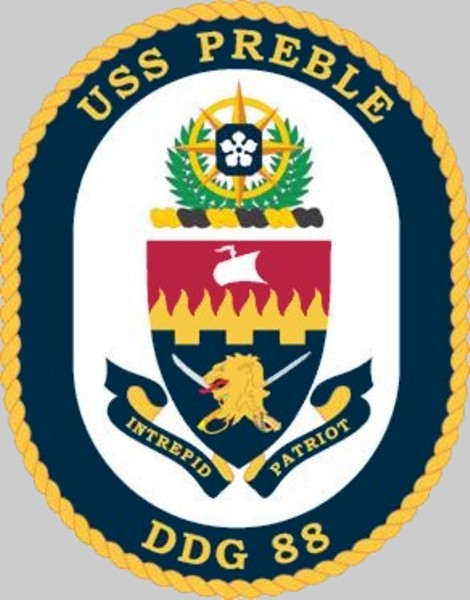 |
||
|
HOME
|
US Navy -
ships
|
US Navy - air
units
|
USMC - air
units
|
International
Navies
|
Weapon Systems
|
Special Reports |
||
|
US Navy - Guided Missile Destroyer DDG 88 - USS Preble |
||
|
||
| 10/24 | ||
|
Type, class:
Guided Missile Destroyer - DDG; Arleigh Burke class, Flight IIA Builder: Ingalls Shipbuilding, Pascagoula, Mississippi, USA STATUS: Awarded: December 13, 1996 Laid down: June 22, 2000 Launched: June 1, 2001 Commissioned: November 9, 2002 IN SERVICE Homeport: forward deployed to Fleet Activities Yokosuka, Japan Namesake: Commodore Edward Preble (1761-1807) Ships Motto: INTREPID PATRIOT Technical Data: see: INFO > Arleigh Burke class Guided Missile Destroyer - DDG |
||
| images | ||
 arriving at her new homeport, Fleet Activities Yokosuka, Japan - October 12, 2024 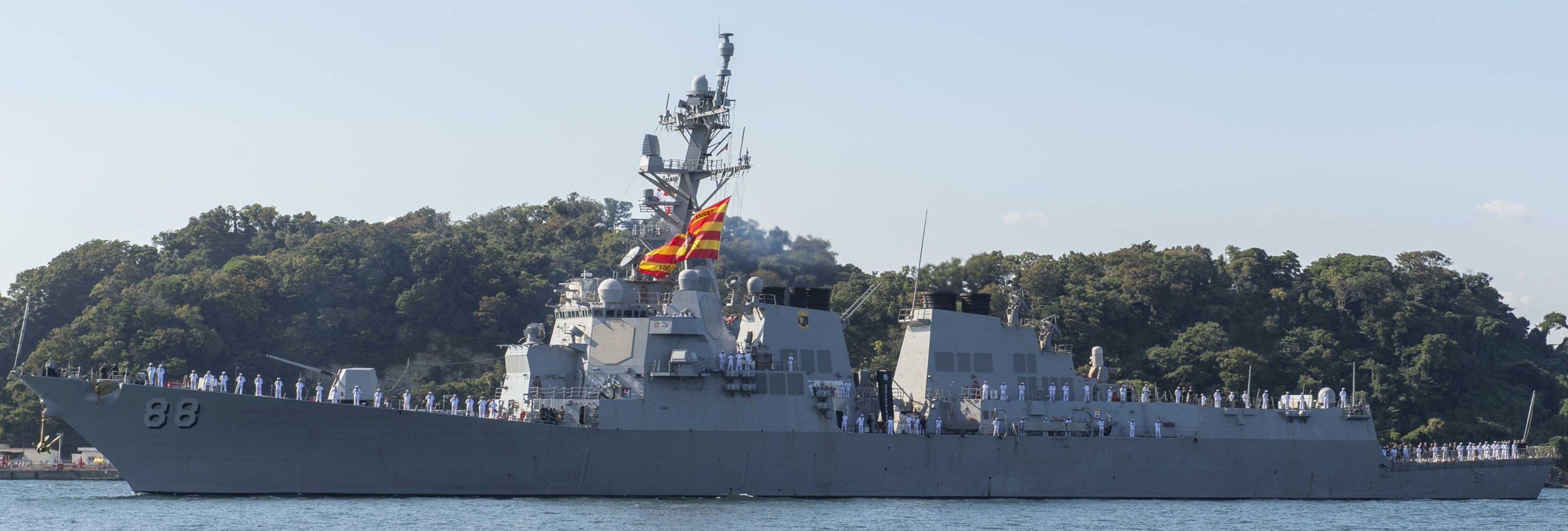 arriving at her new homeport, Fleet Activities Yokosuka, Japan - October 12, 2024 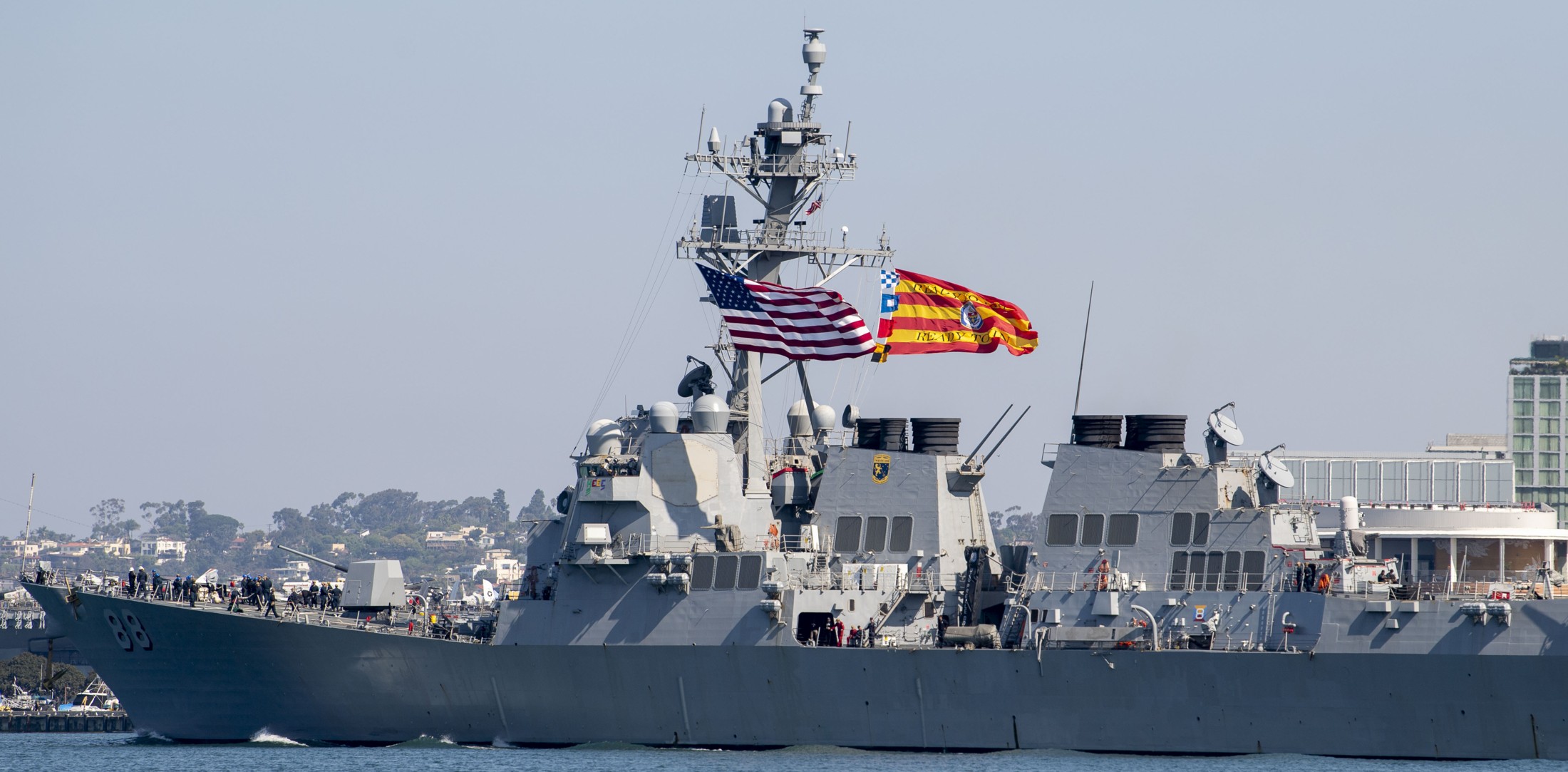 departing Naval Base San Diego, California for a homeport shift to Fleet Activities Yokosuka, Japan - September 22, 2024  departing Naval Base San Diego, California for a homeport shift to Fleet Activities Yokosuka, Japan - September 22, 2024 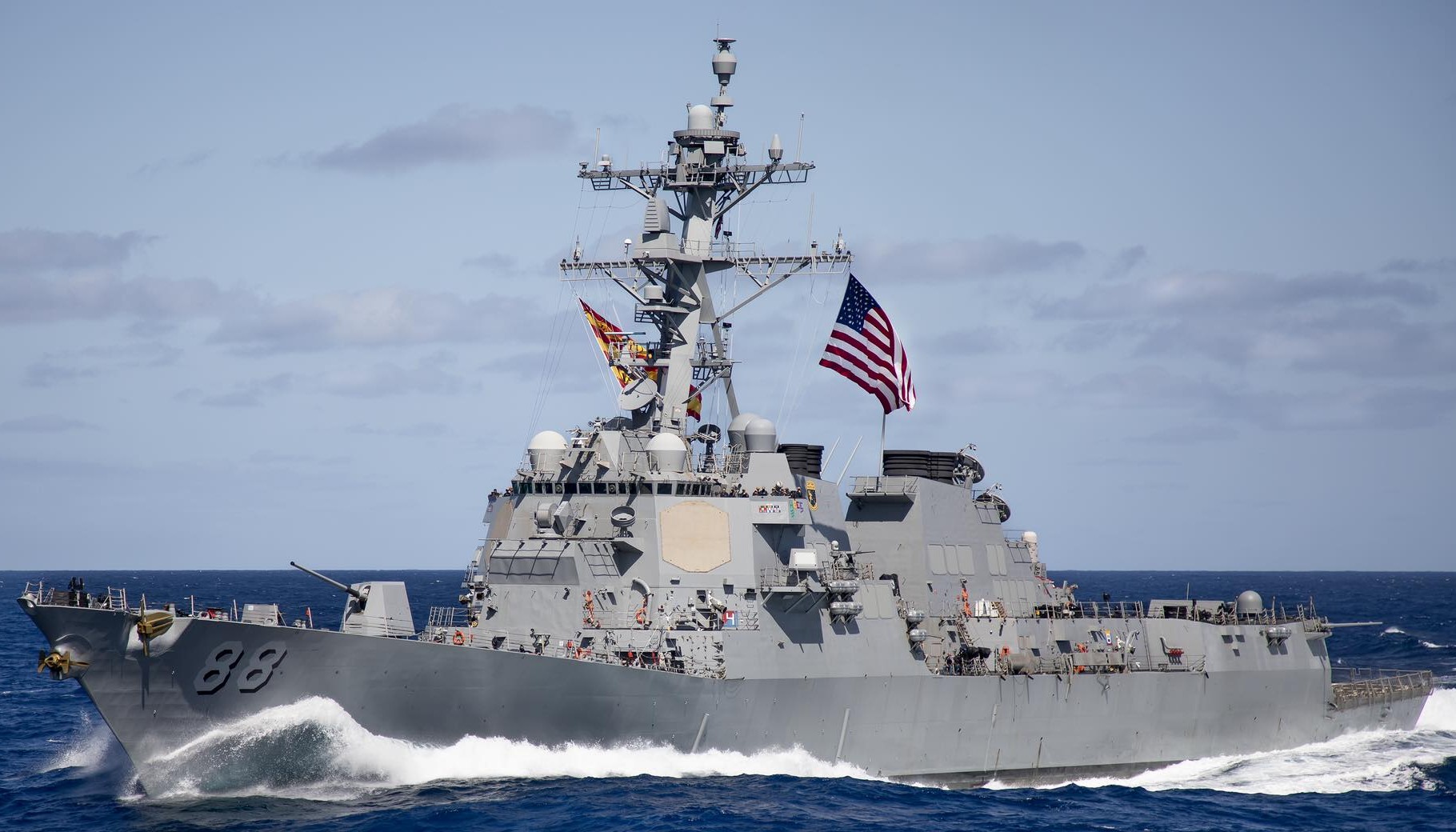 Pacific Ocean - April 2024 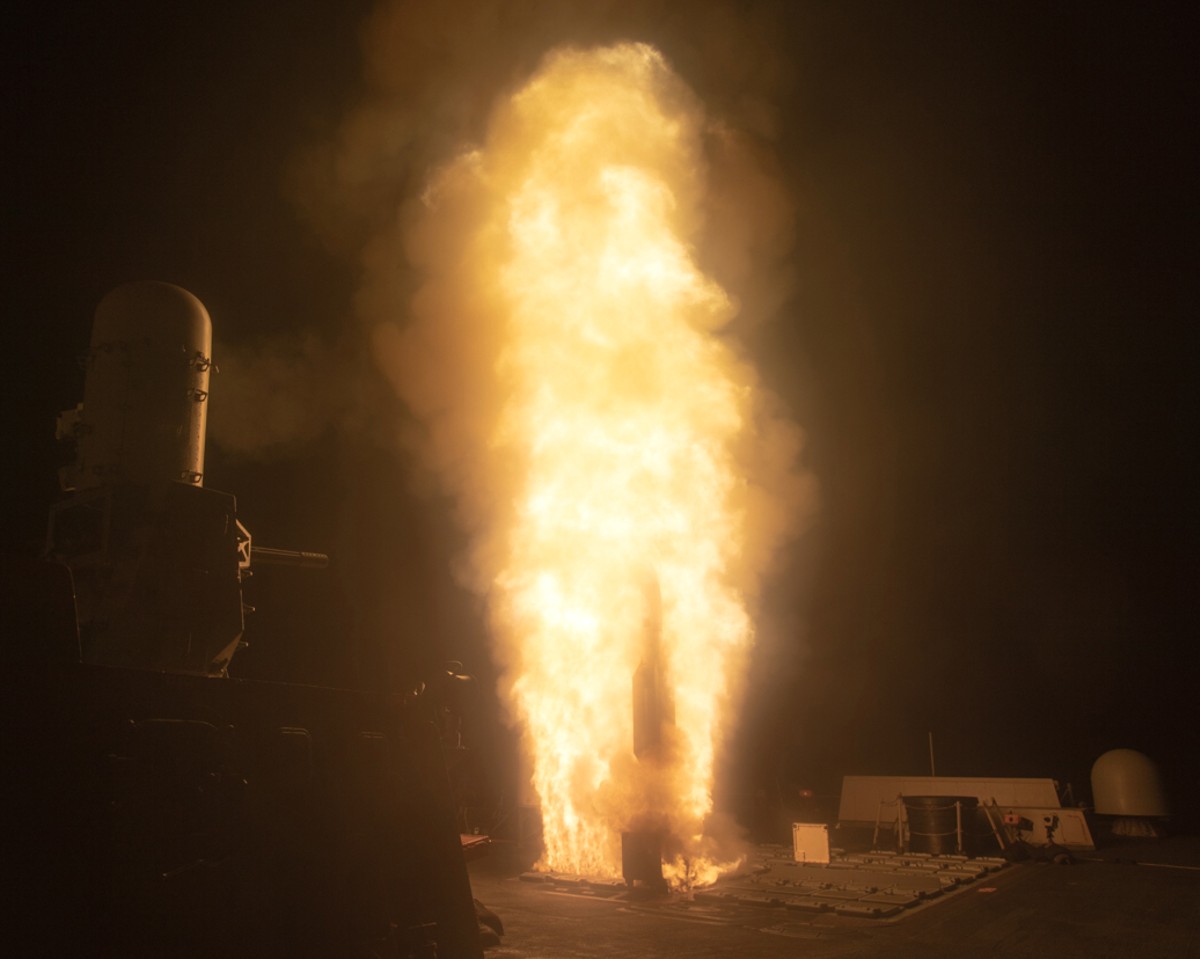 firing an RIM-174 Standard Missile-6 (SM-6) Dual II with Software Upgrade (SWUP) - Pacific Missile Range Facility - off Hawaii - March 2024 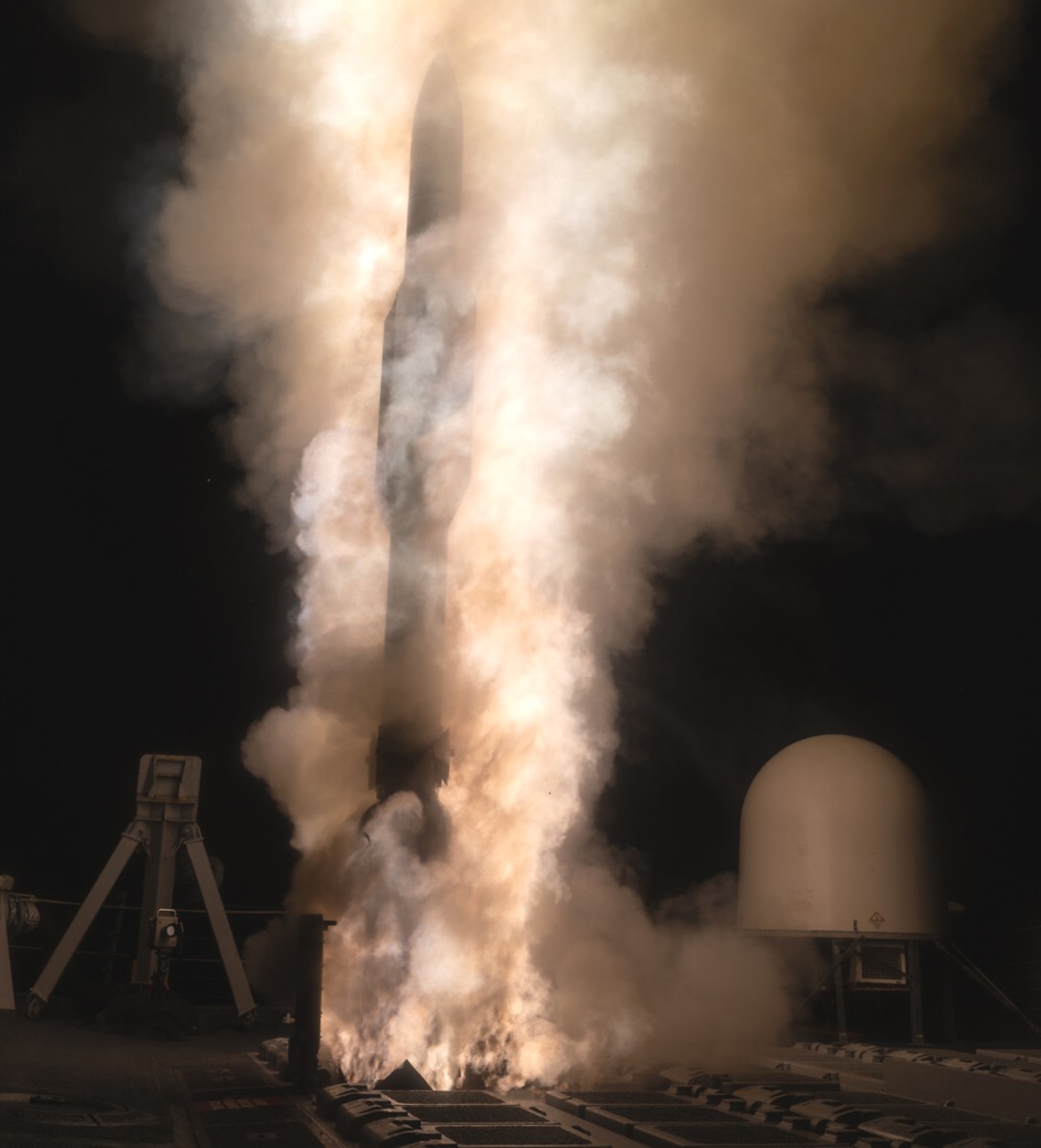 firing an RIM-174 Standard Missile-6 (SM-6) Dual II with Software Upgrade (SWUP) - Pacific Missile Range Facility - off Hawaii - March 2024 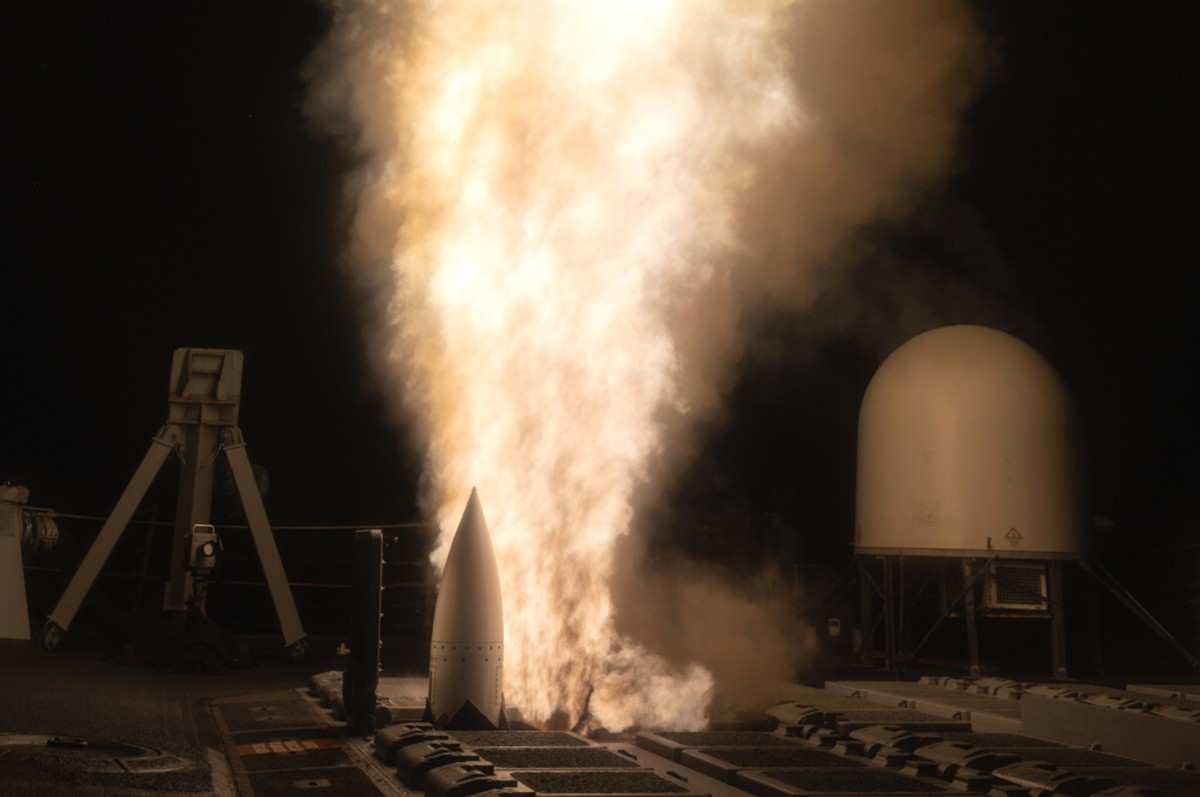 firing an RIM-174 Standard Missile-6 (SM-6) Dual II with Software Upgrade (SWUP) - Pacific Missile Range Facility - off Hawaii - March 2024 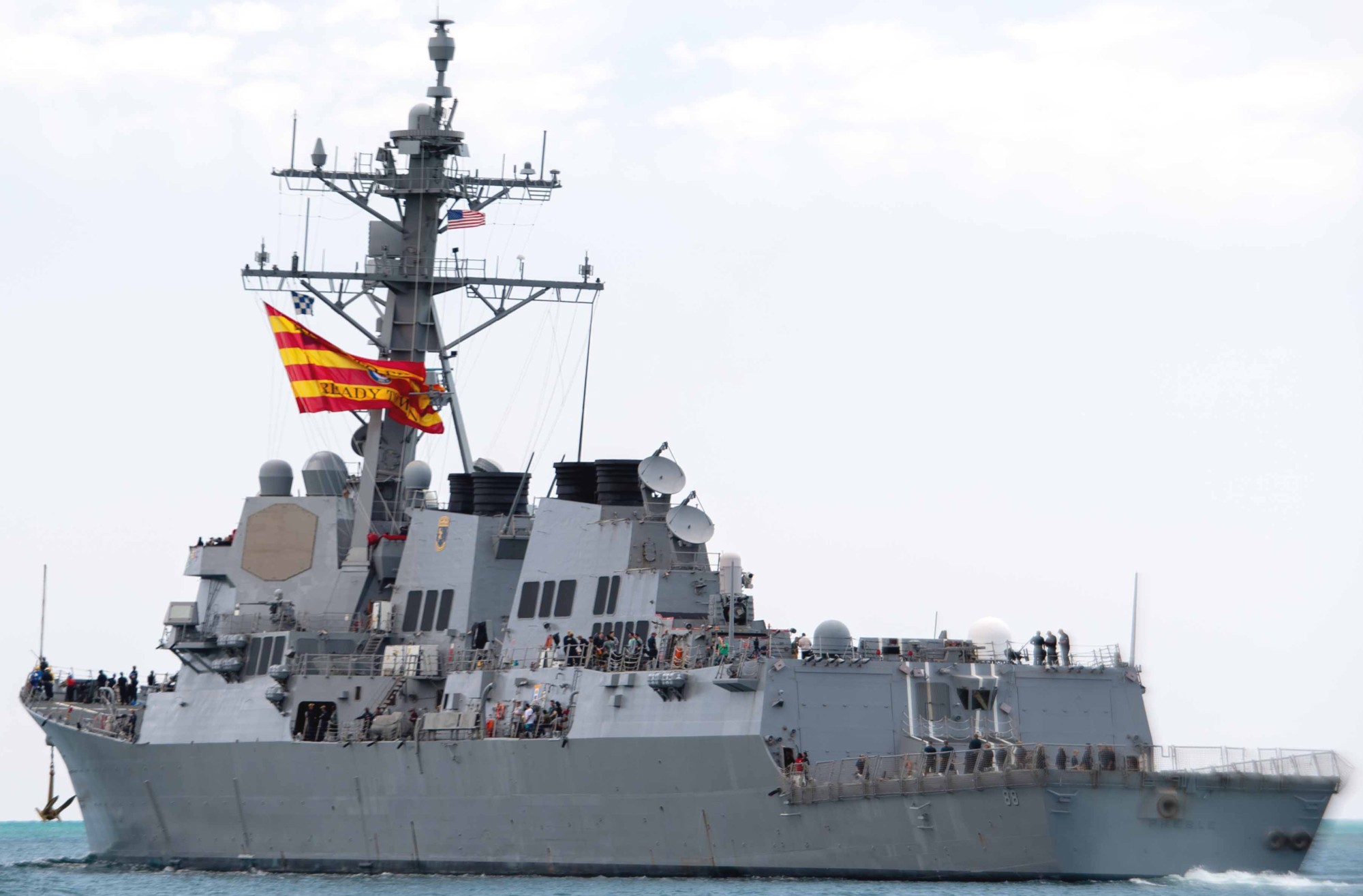 departing Joint Base Pearl Harbor-Hickam, Hawaii for missile tests - March 2024 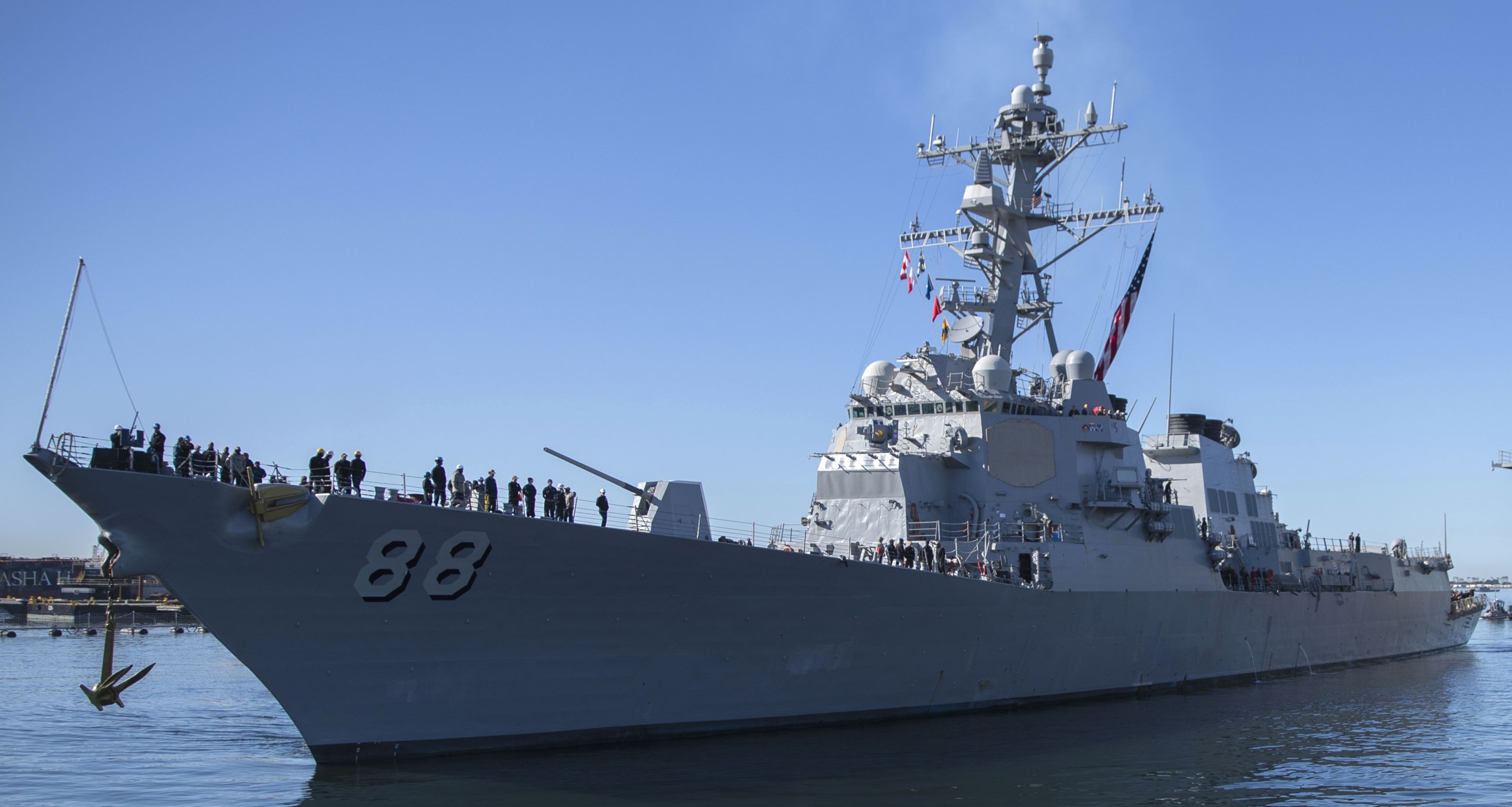 arriving at Naval Base San Diego, California - February 12, 2024 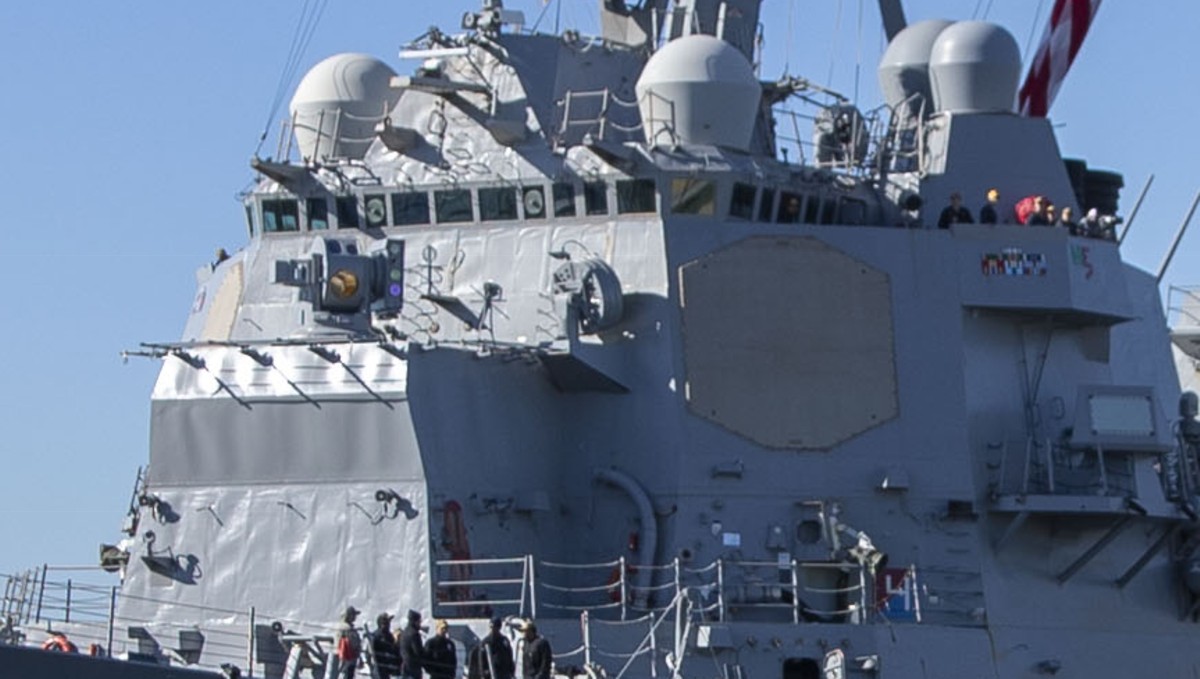 cutout - note the added 60+ kW High Energy Laser with Integrated Optical-dazzler and Surveillance (HELIOS)  returning to Joint Base Pearl Harbor-Hickam, Hawaii - June 25, 2020 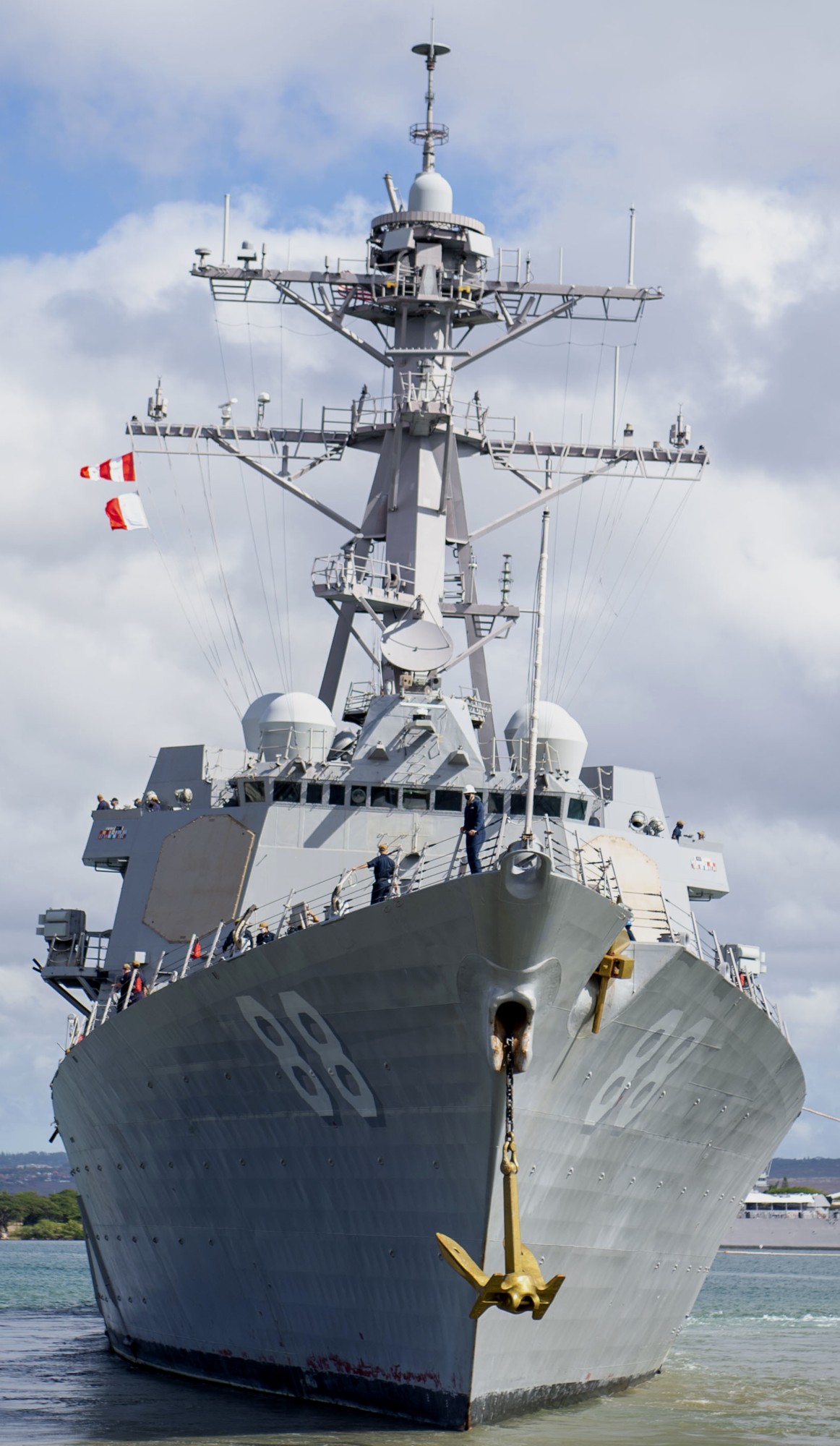 returning to Joint Base Pearl Harbor-Hickam, Hawaii - June 25, 2020  Pacific Ocean - June 2020 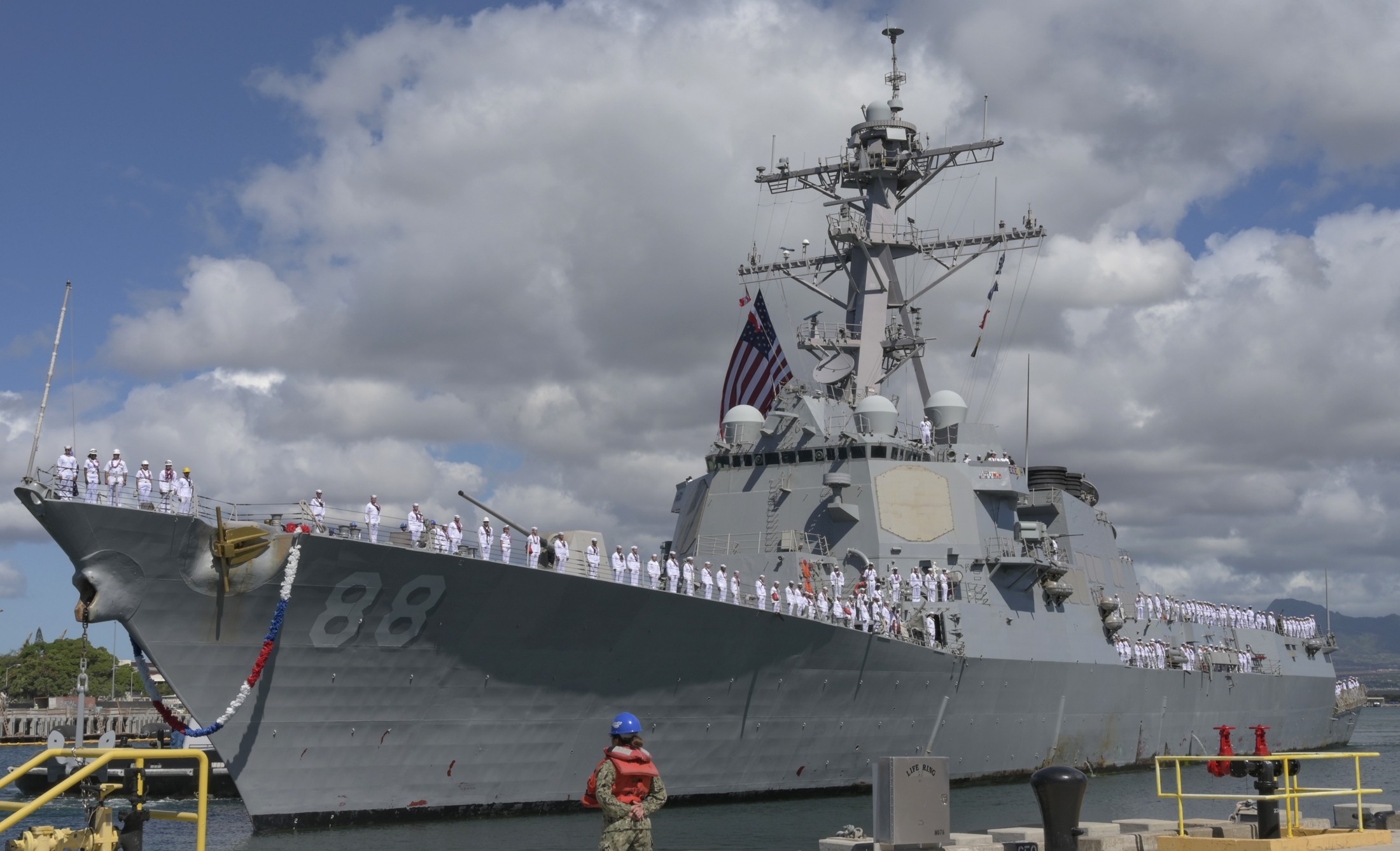 returning to Joint Base Pearl Harbor-Hickam, Hawaii - June 13, 2019 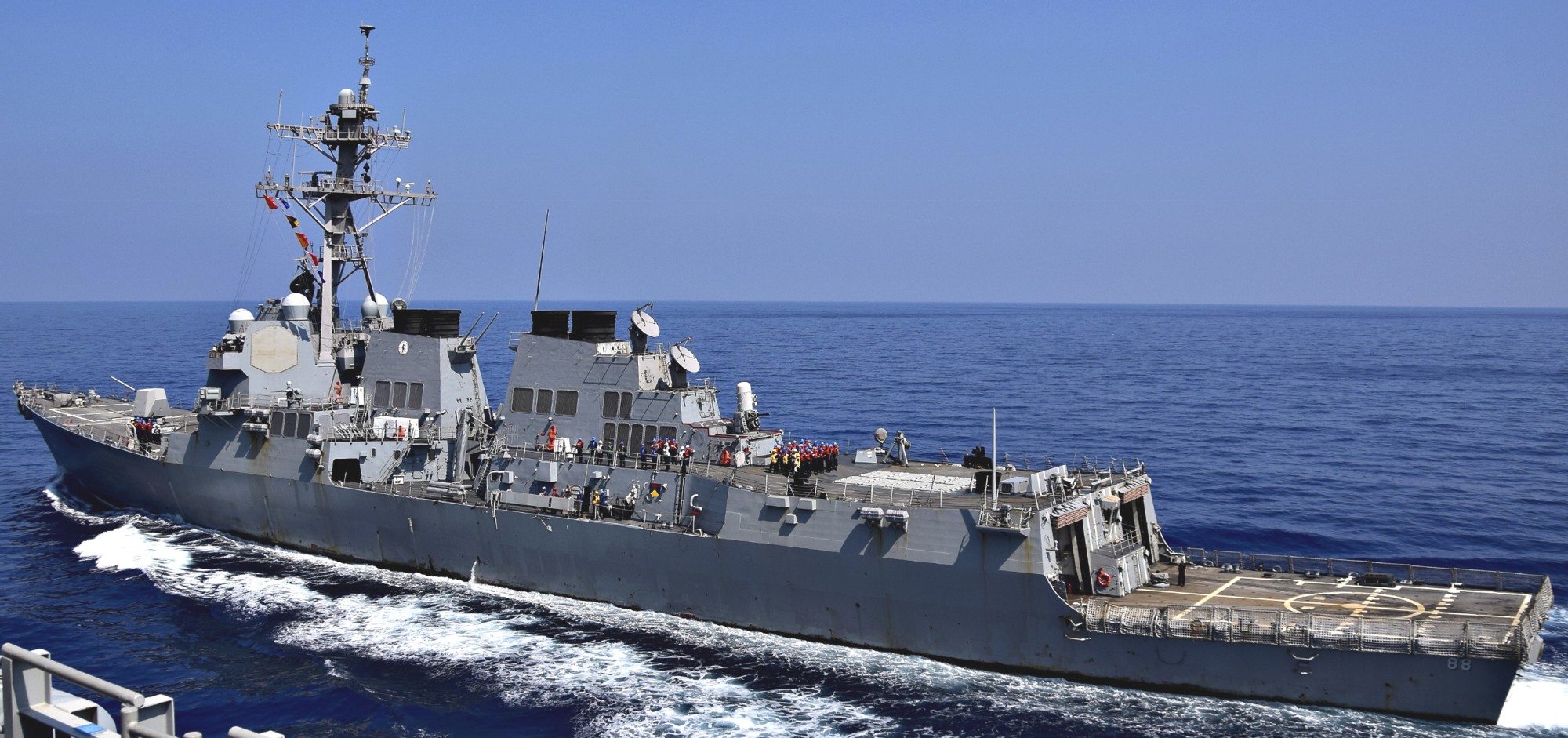 South China Sea - April 2019 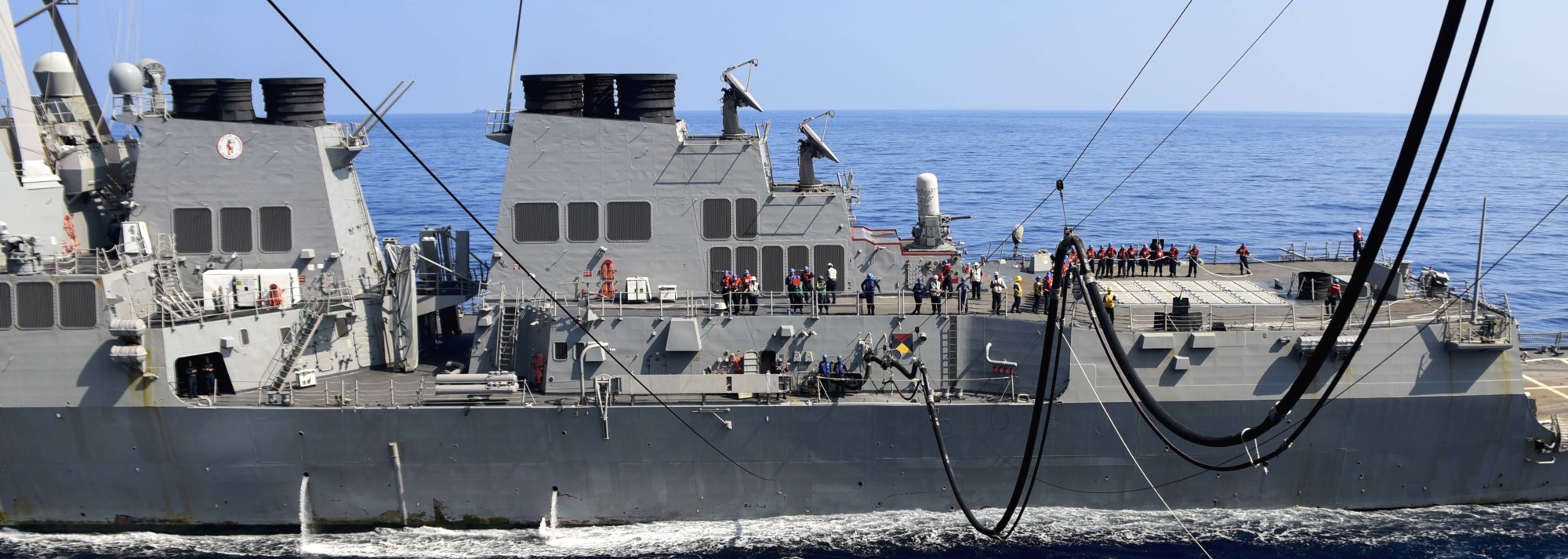 South China Sea - April 2019 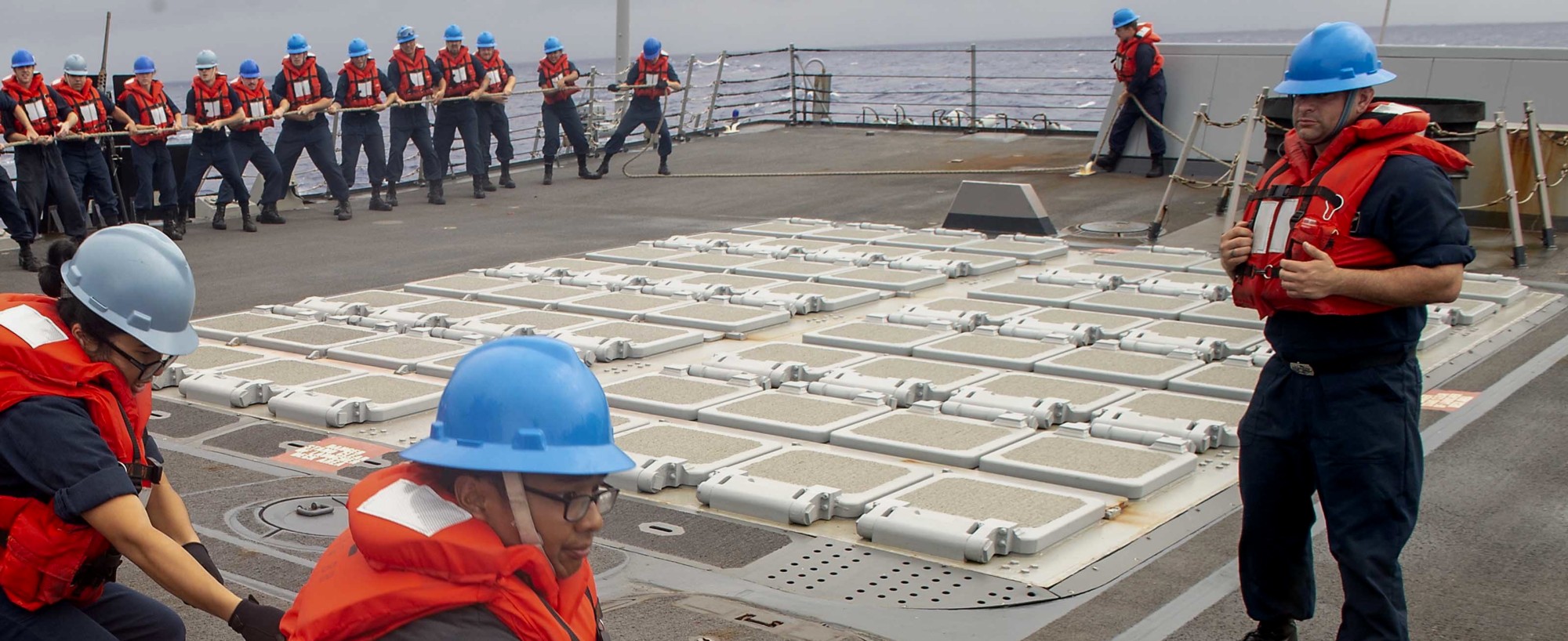 aft Mk.41 vertical launching system (VLS), 64 cells - Philippine Sea - February 2019  Mk.15 Phalanx close-in weapon system (CIWS) fire exercise - Pacific Ocean - January 2019 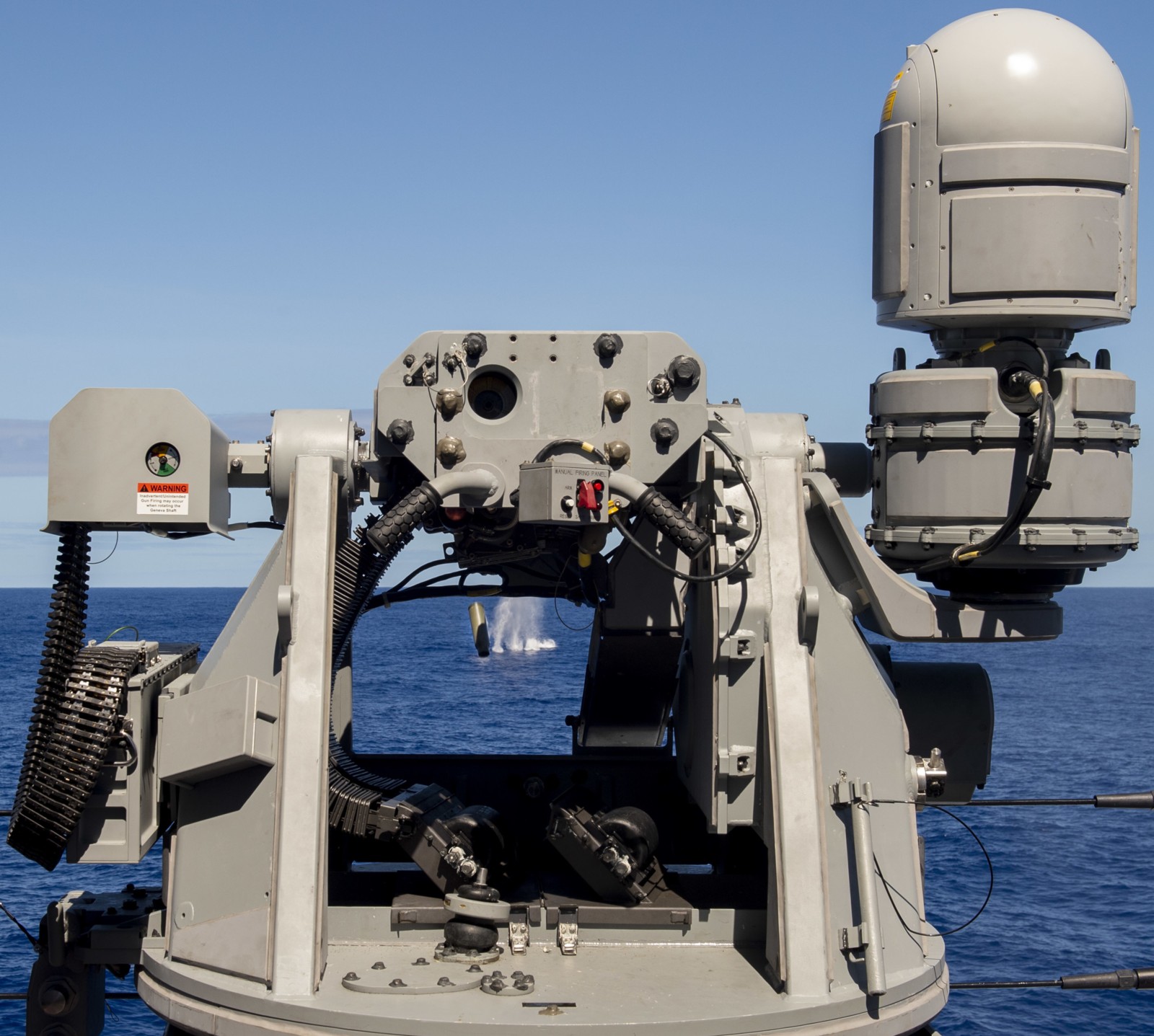 Mk.38 Mod.2 machine gun fire exercise - Pacific Ocean - January 2019 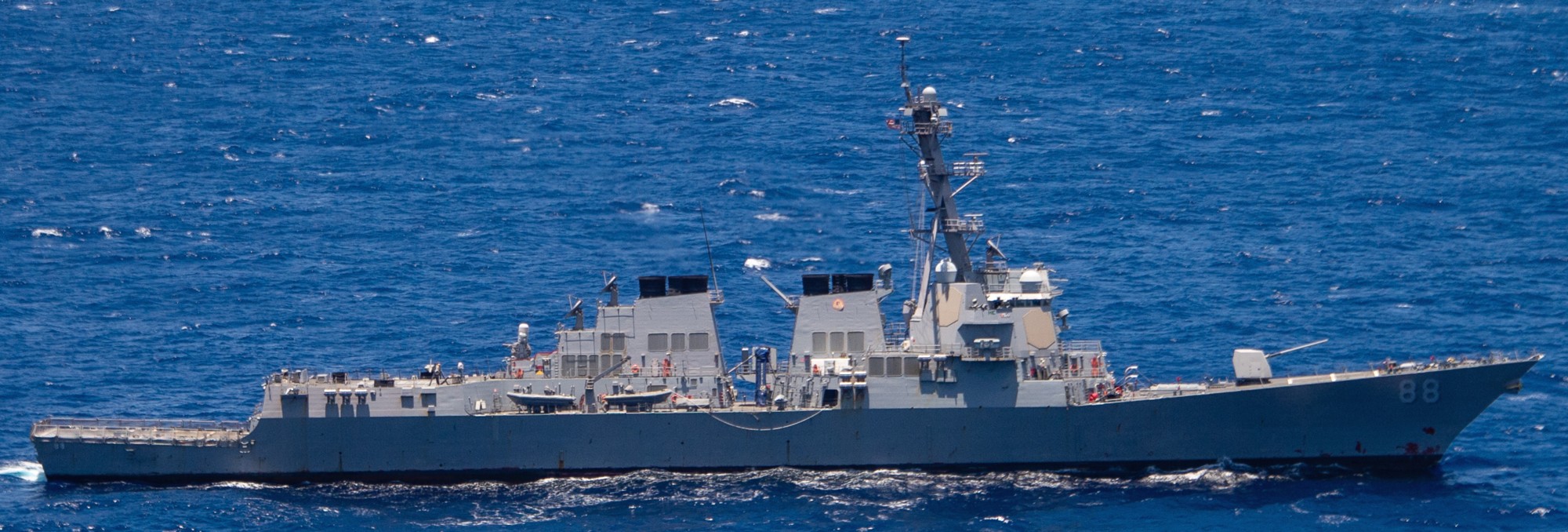 during Exercise RIMPAC 18 - Pacific Ocean - July 2018 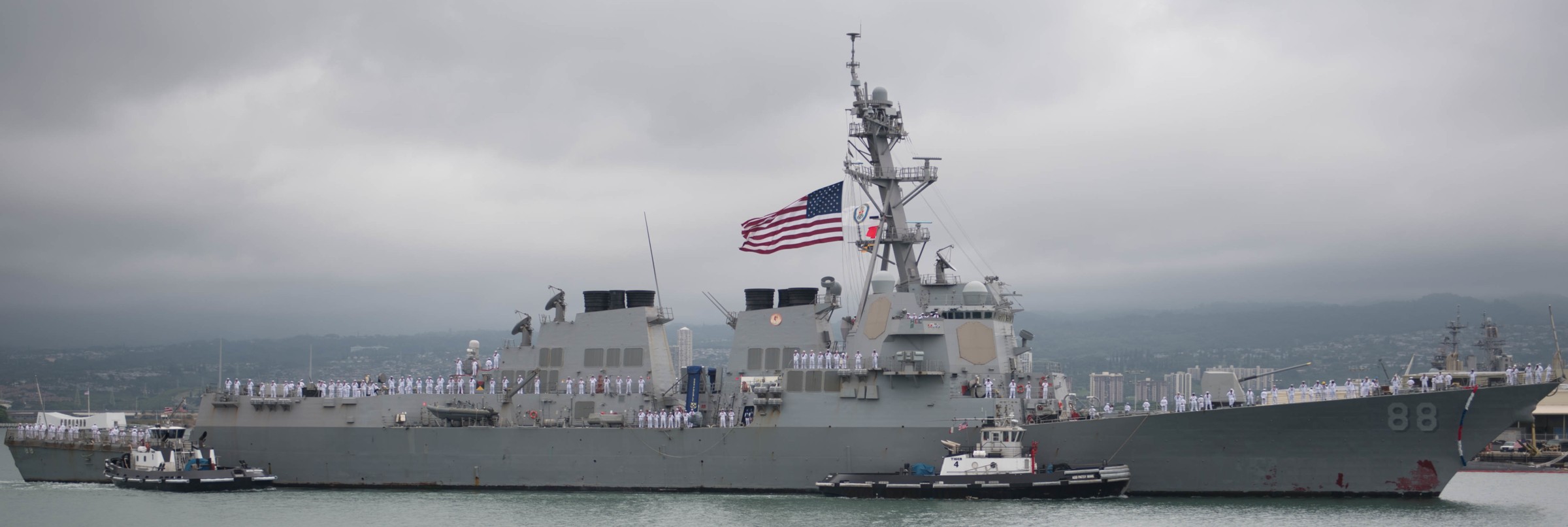 returning to Joint Base Pearl Harbor-Hickam, Hawaii - April 27, 2018 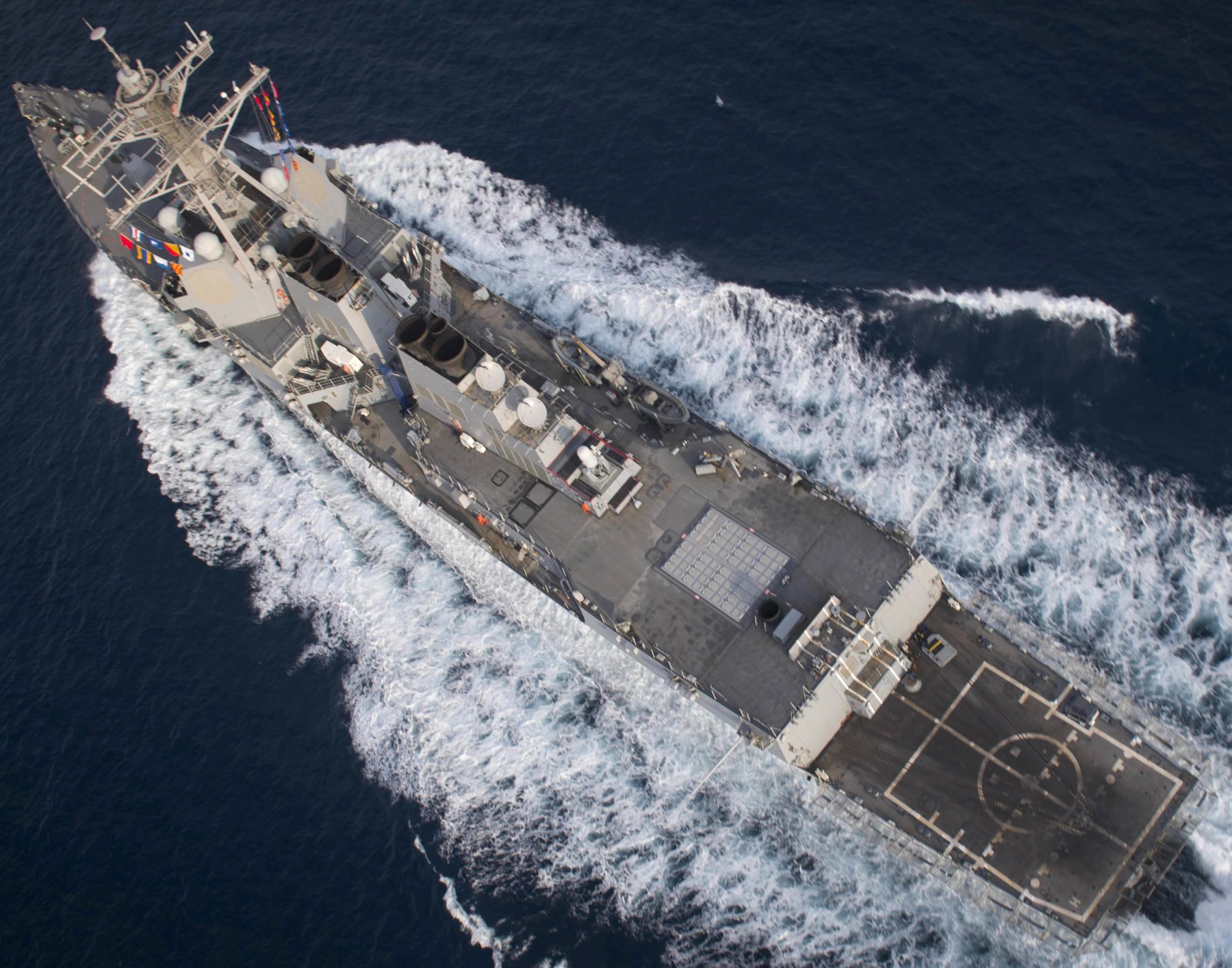 Indian Ocean - March 2018 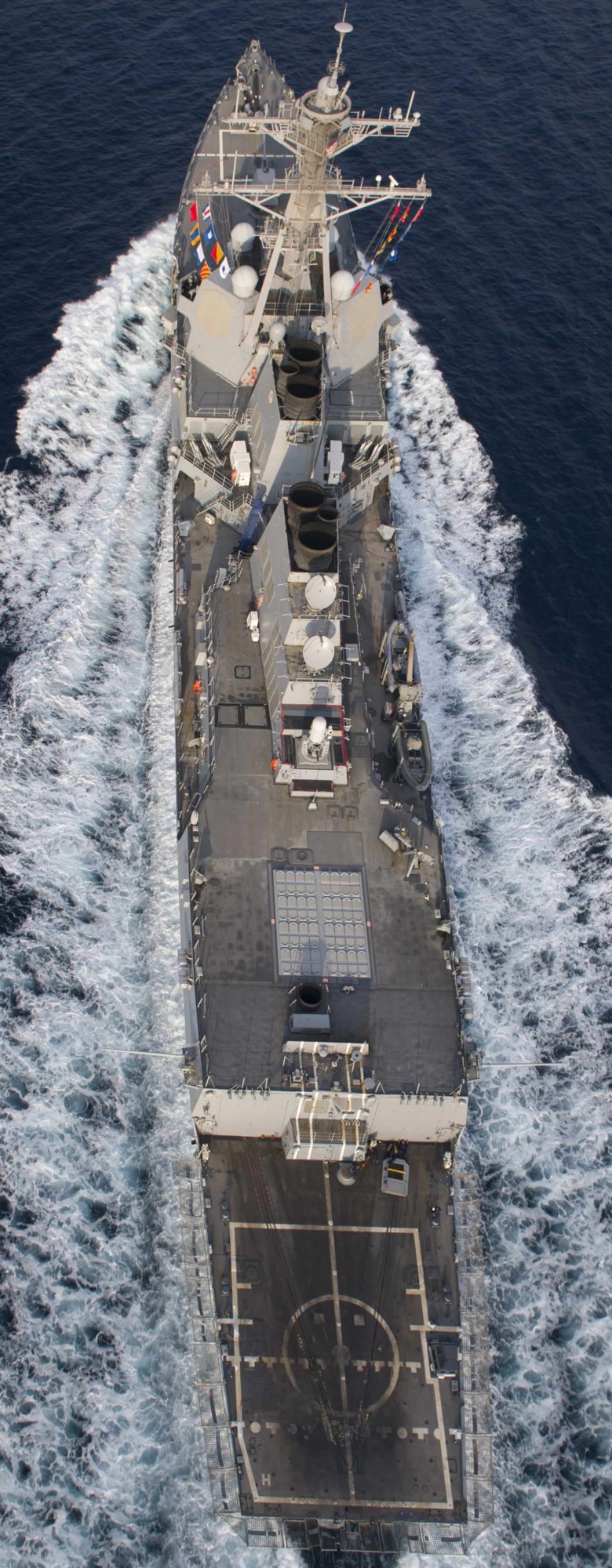 Indian Ocean - March 2018 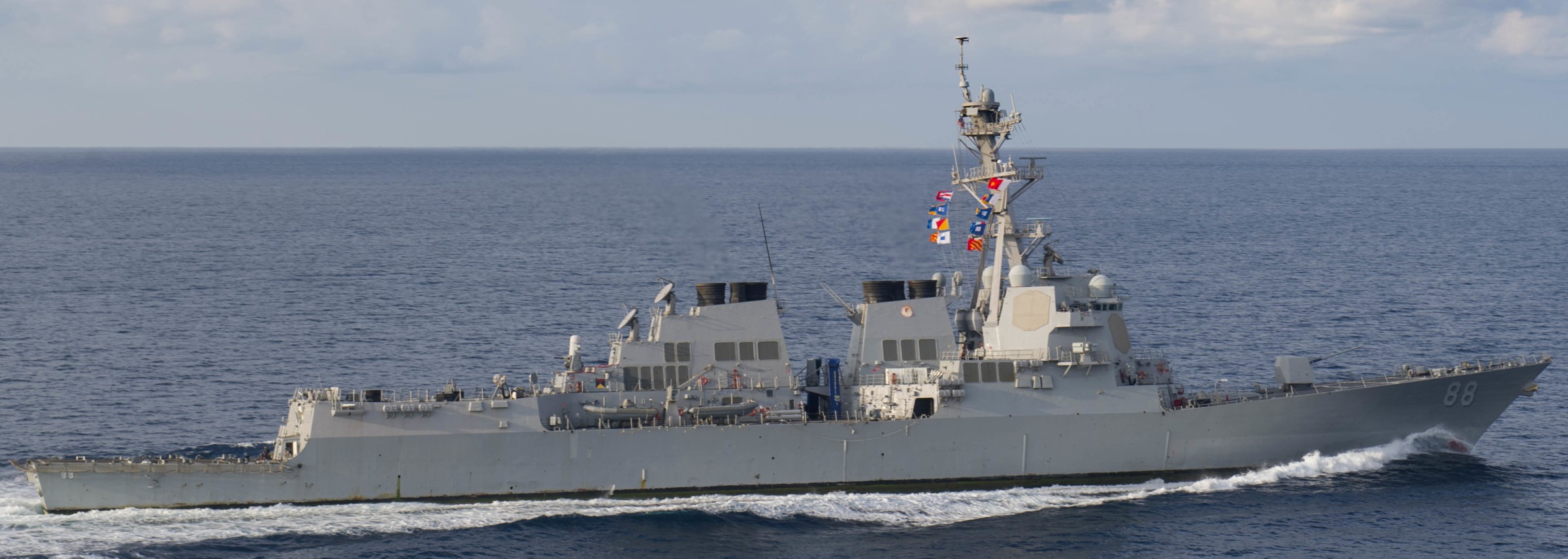 Indian Ocean - March 2018 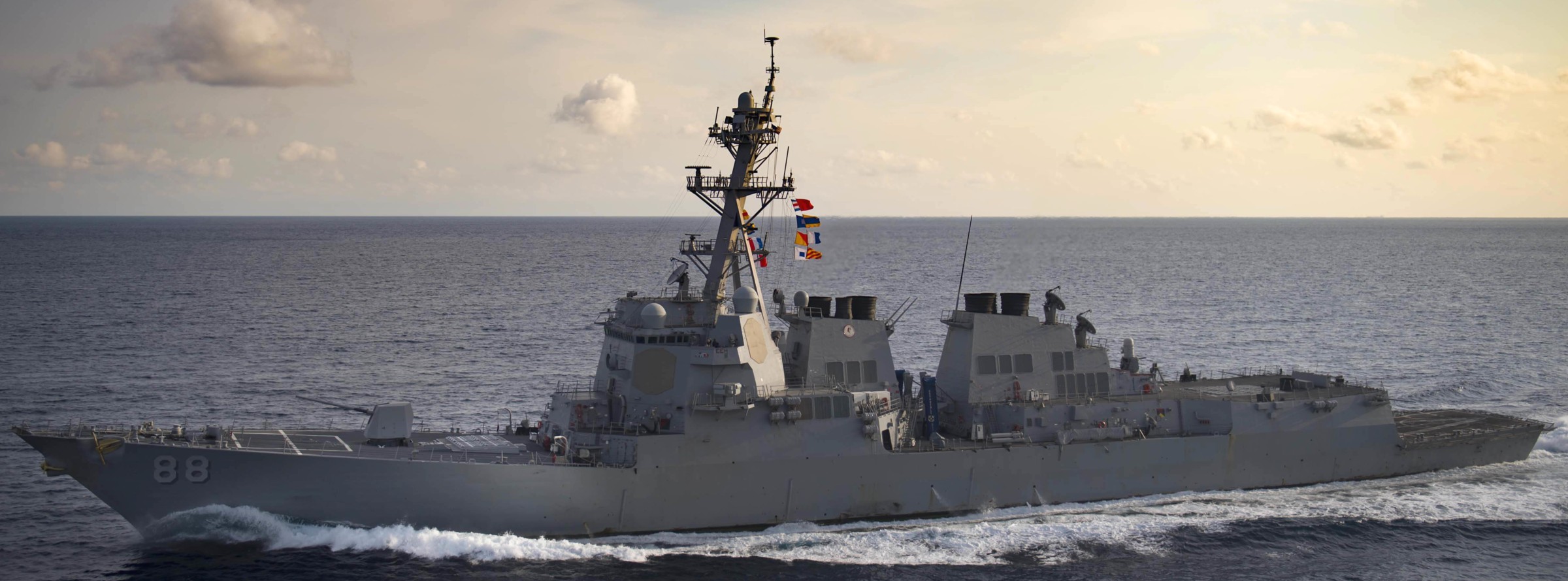 Indian Ocean - March 2018 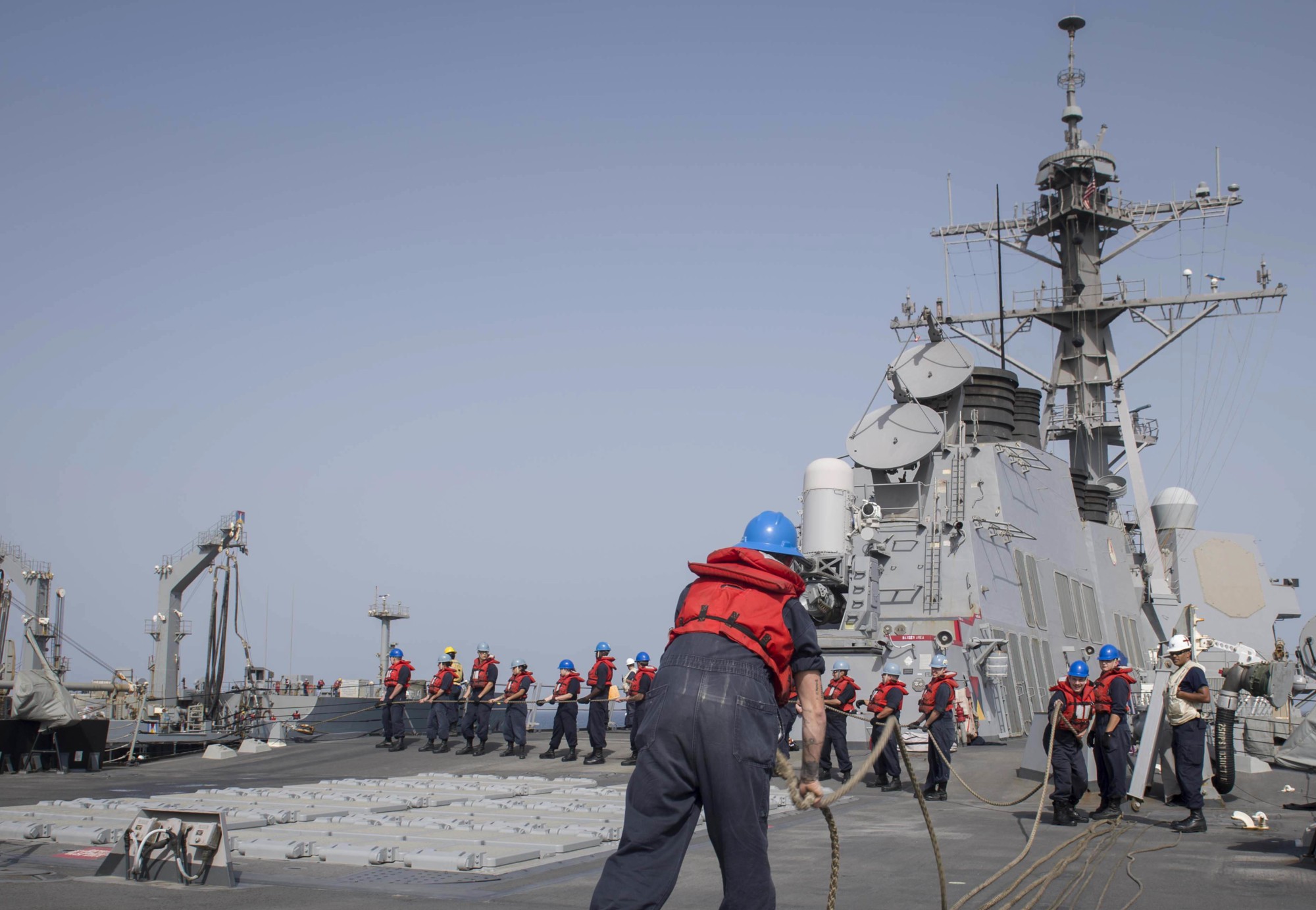 Arabian Sea - March 2018  departing Joint Base Pearl Harbor-Hickam, Hawaii - October 16, 2017 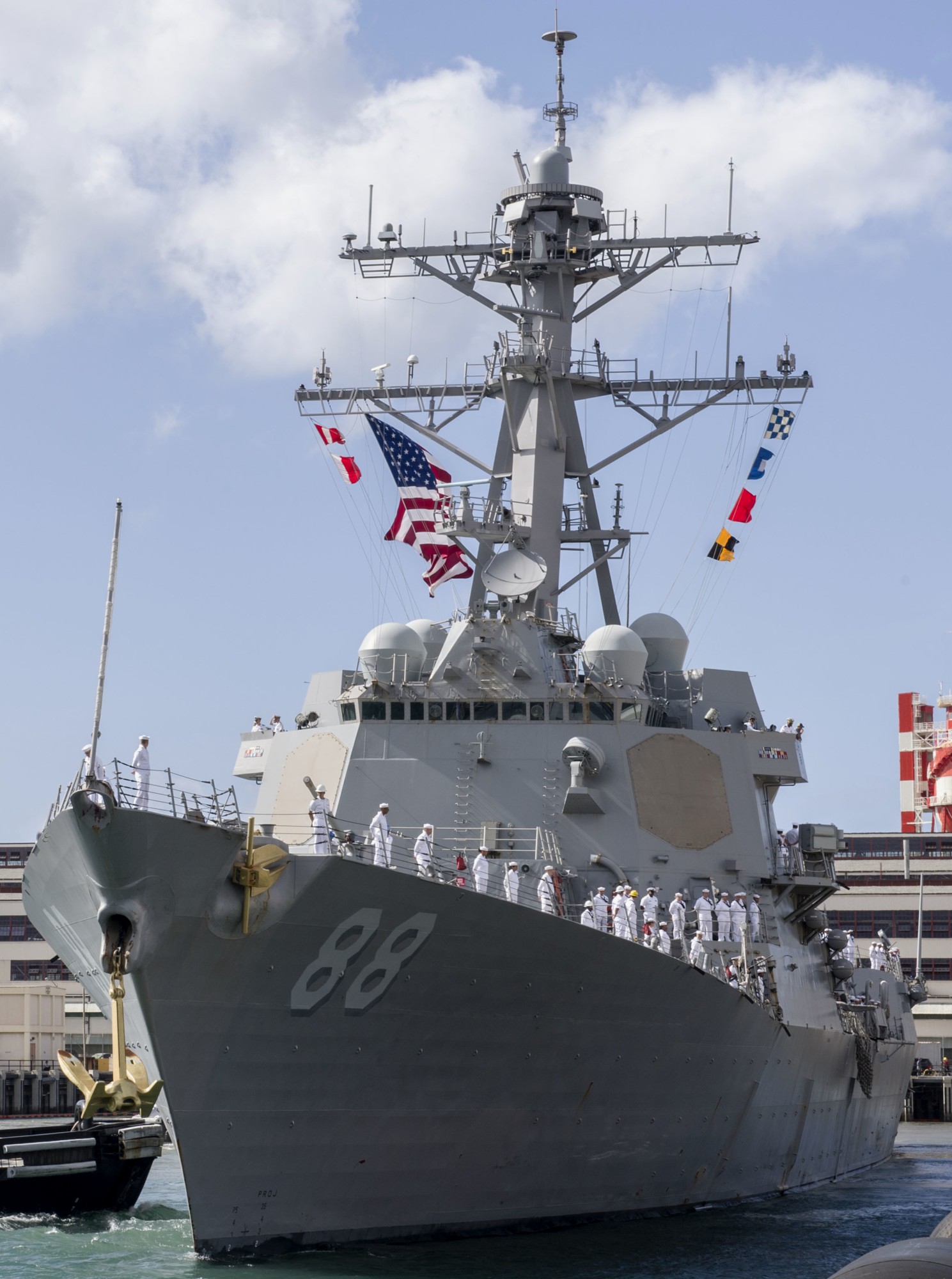 departing Joint Base Pearl Harbor-Hickam, Hawaii - October 16, 2017  launching a Standard Missile from her forward Mk.41 vertical launching system (VLS) - Pacific Ocean - May 2017 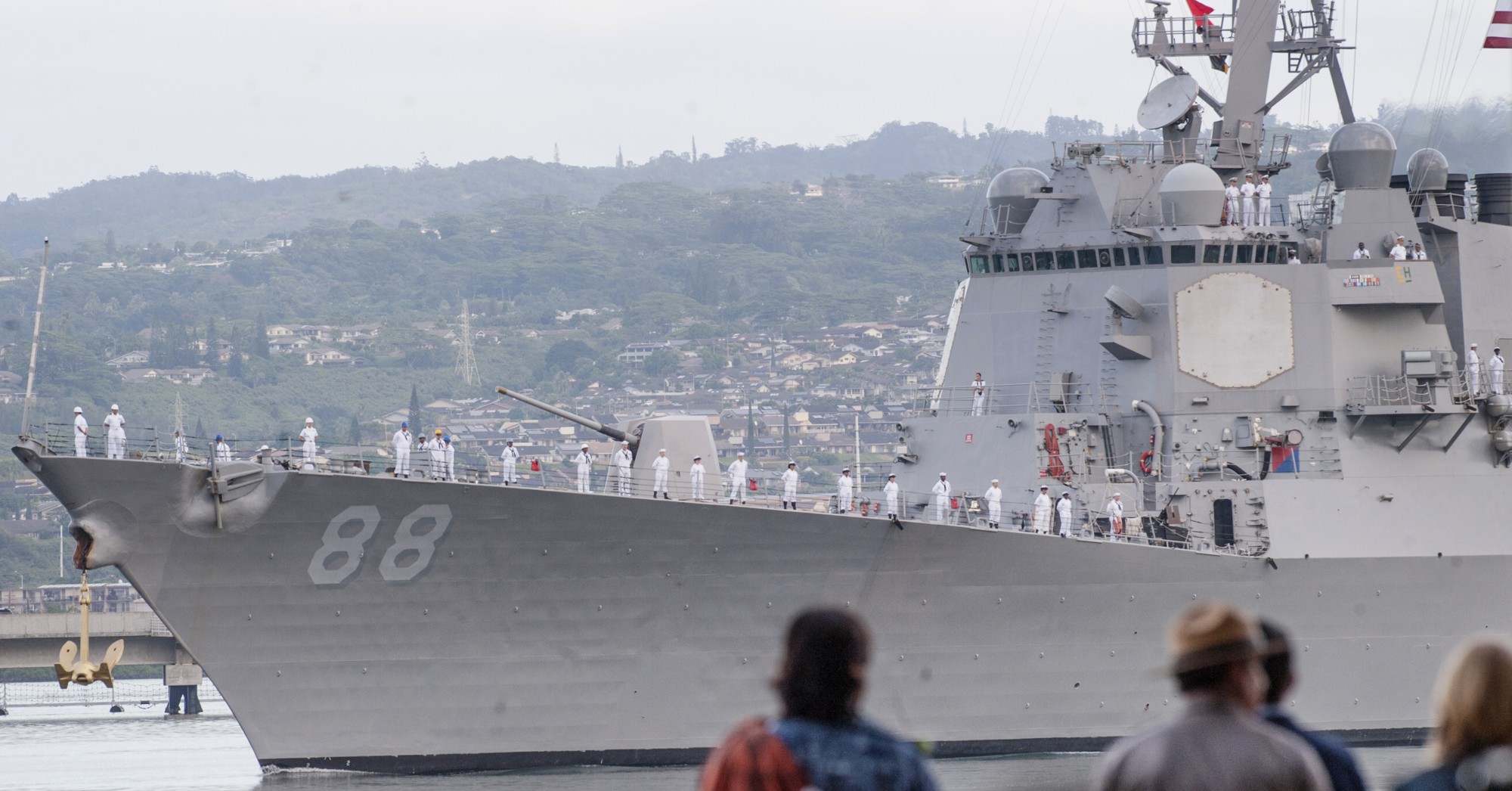 Pearl Harbor attack remembrance day - December 7, 2015 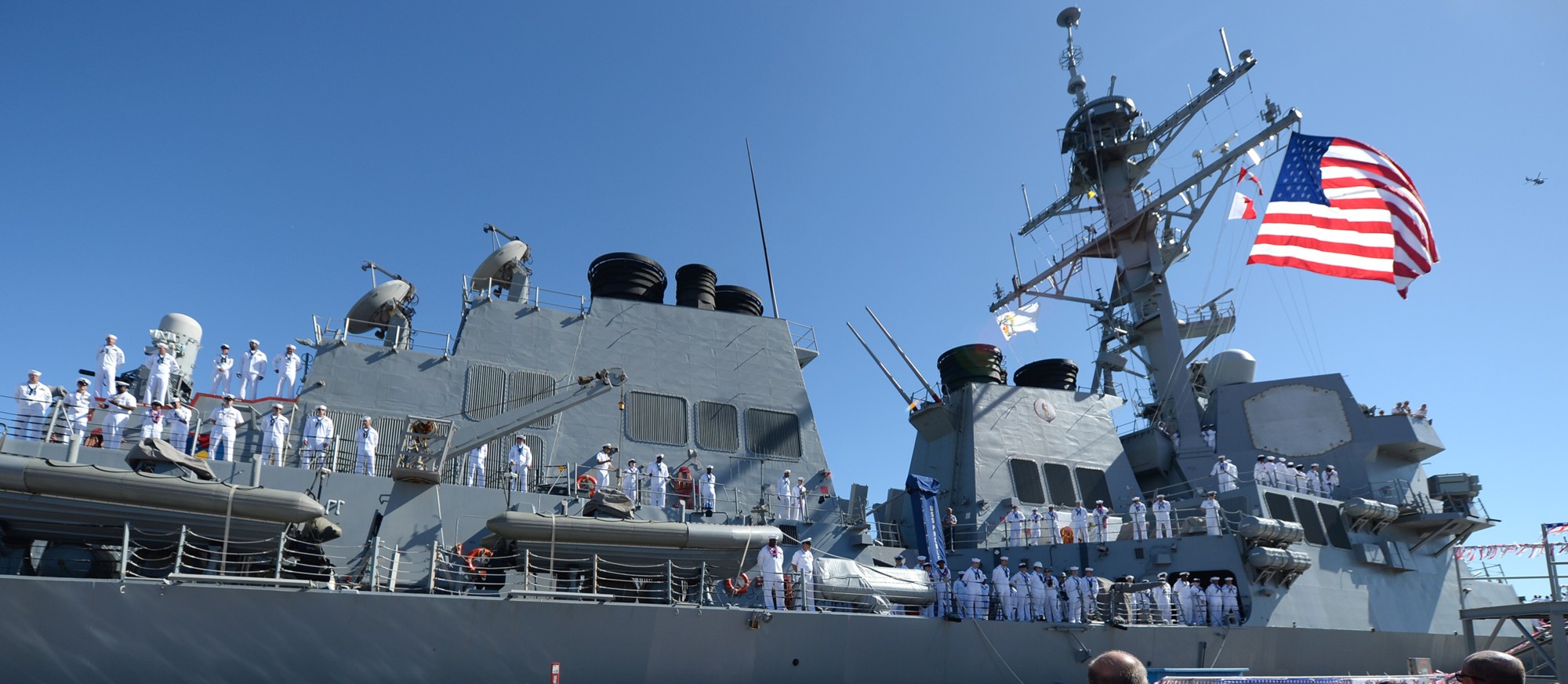 returning to Joint Base Pearl Harbor-Hickam, Hawaii - October 23, 2015 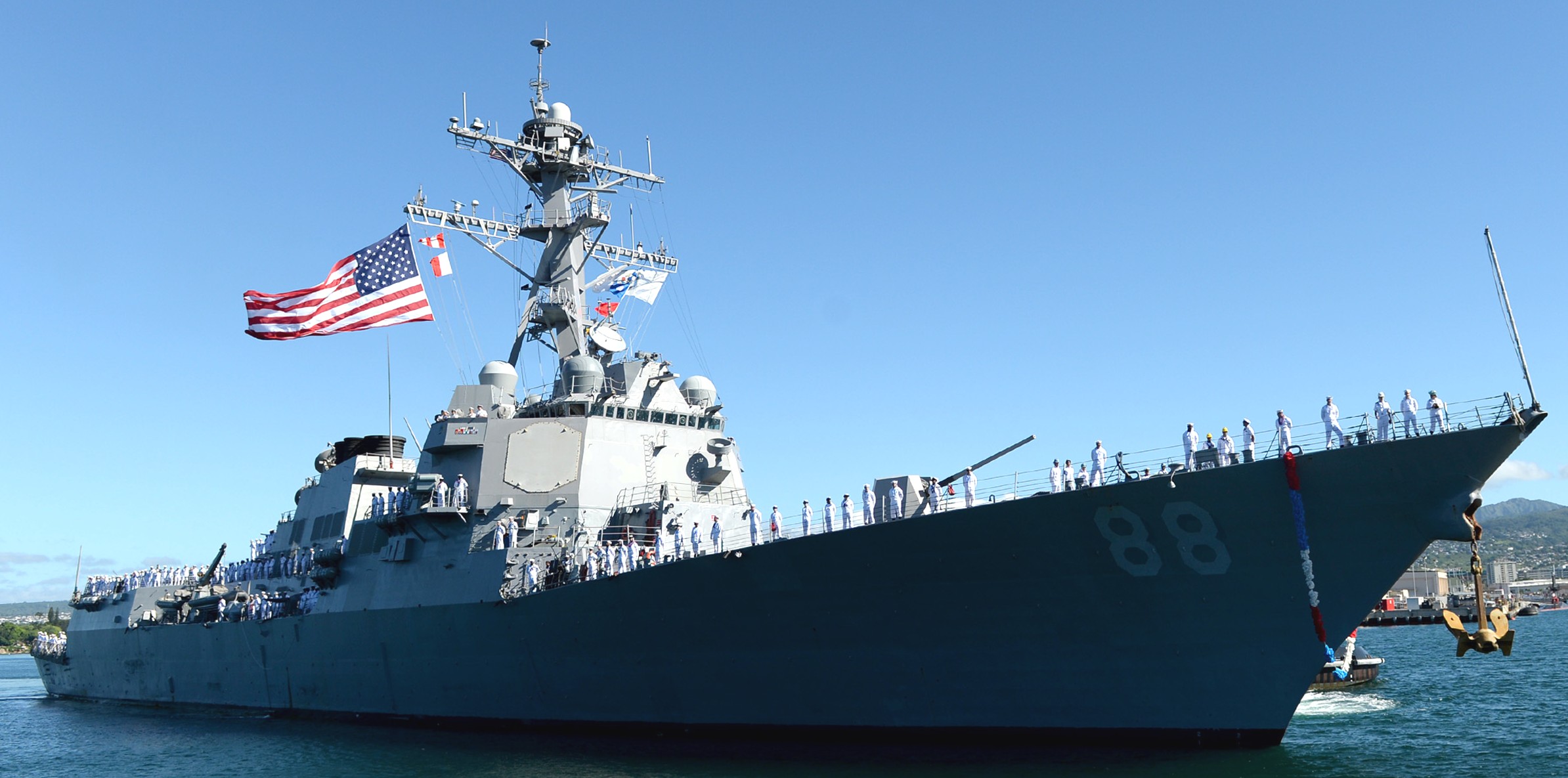 returning to Joint Base Pearl Harbor-Hickam, Hawaii - October 23, 2015 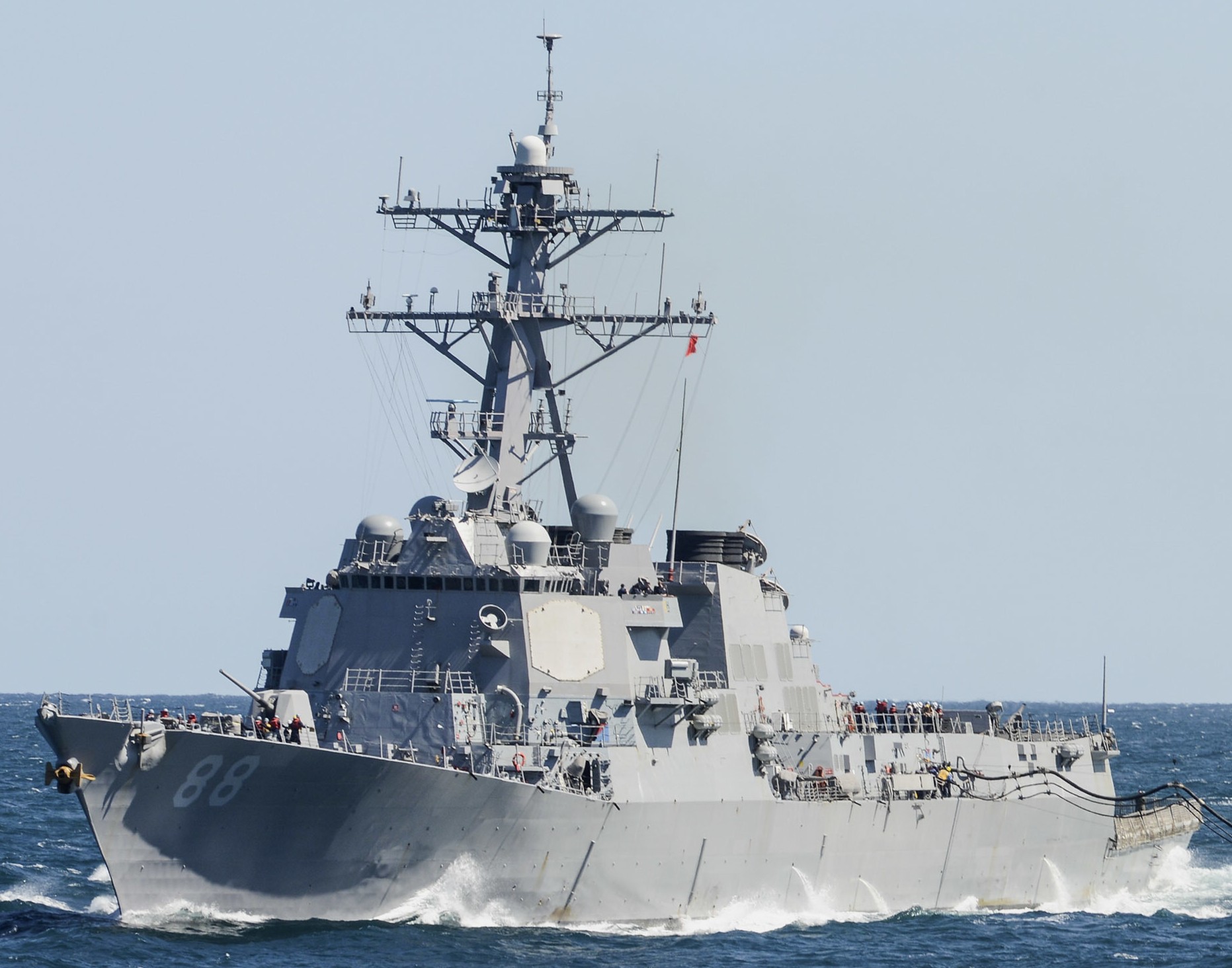 Indian Ocean - July 2015  Indian Ocean - July 2015  South China Sea - June 2015 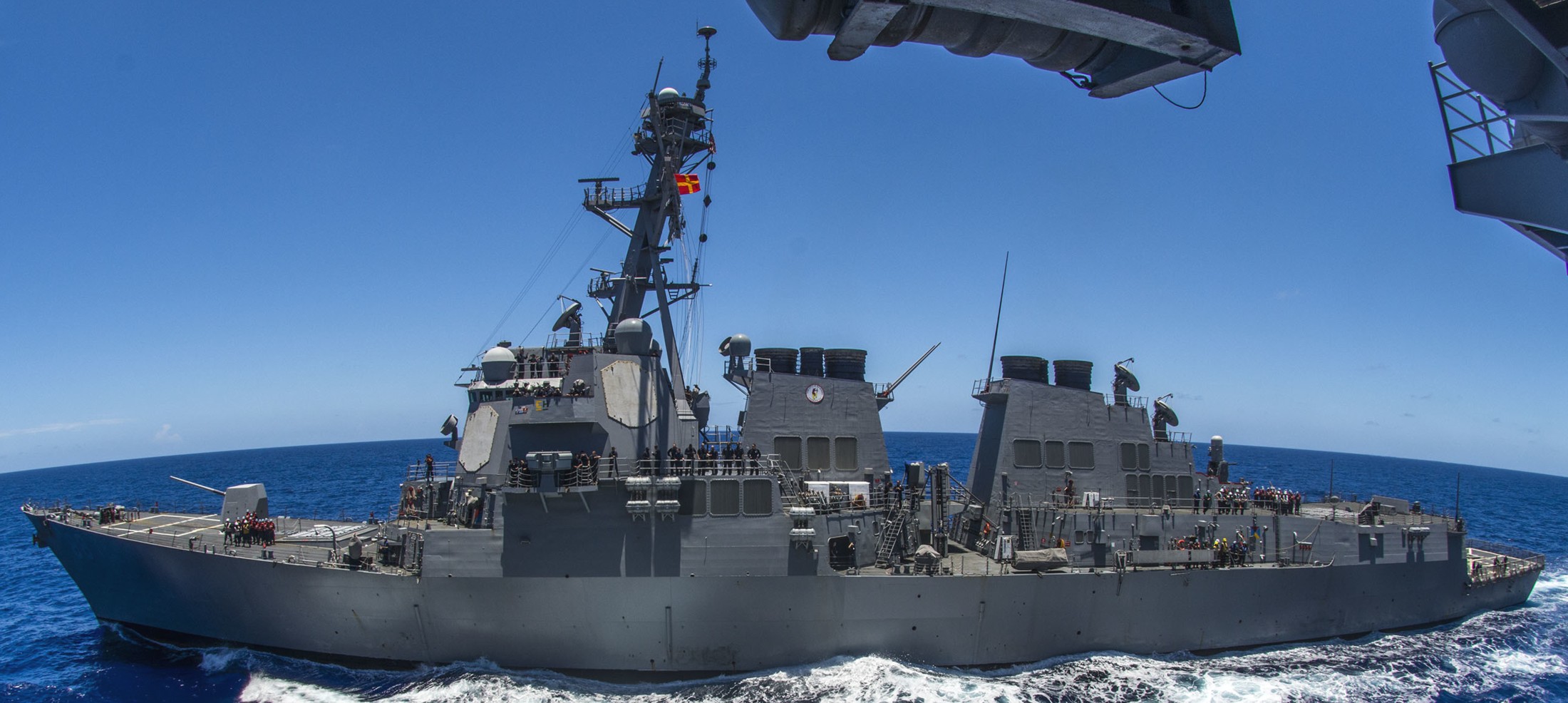 Philippine Sea - May 2015 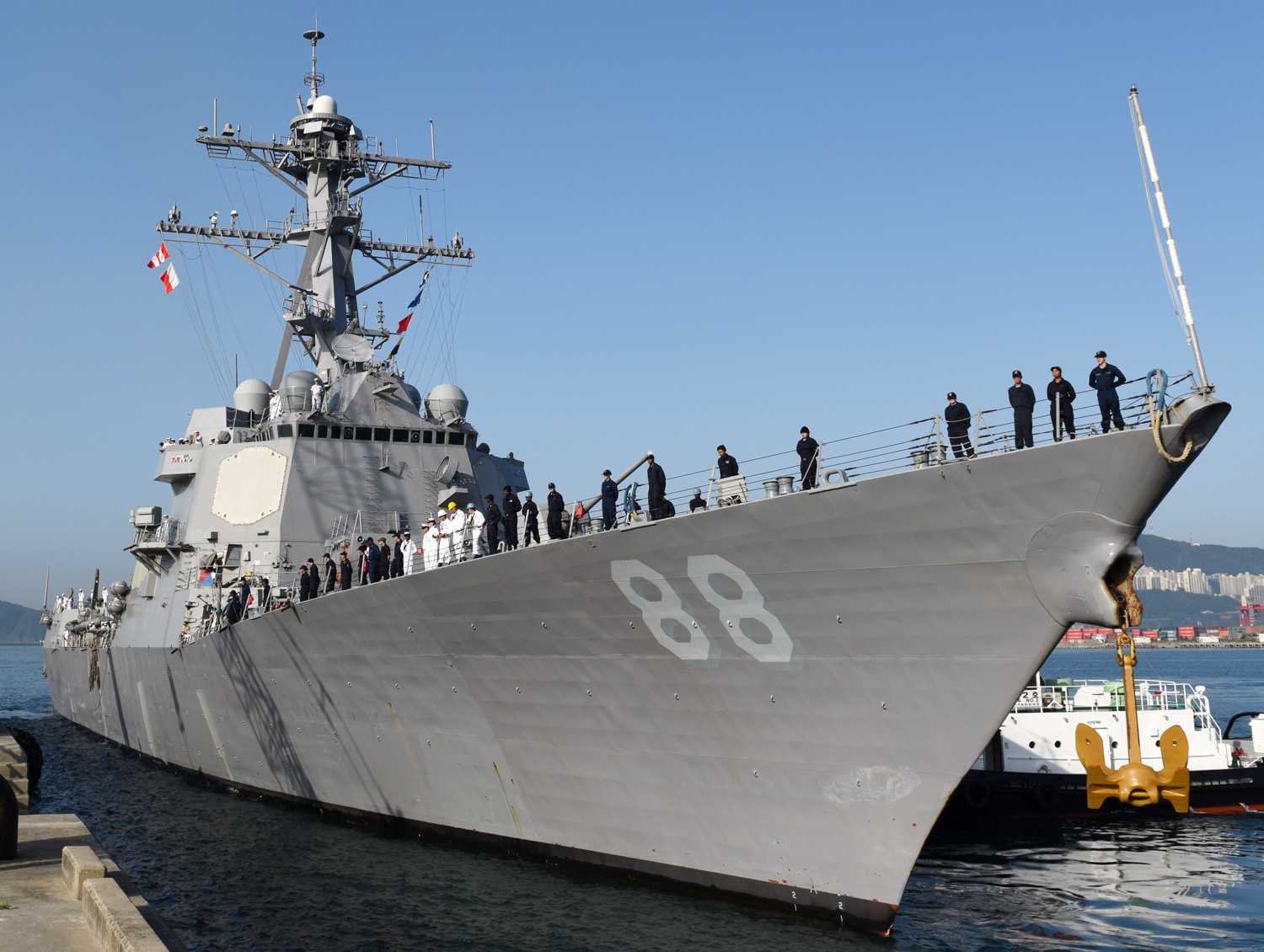 Busan, Republic of Korea - May 2015  change of command ceremony - Joint Base Pearl Harbor-Hickam, Hawaii - December 2014  arriving at her new homeport, Joint Base Pearl Harbor-Hickam, Hawaii - August 14, 2014 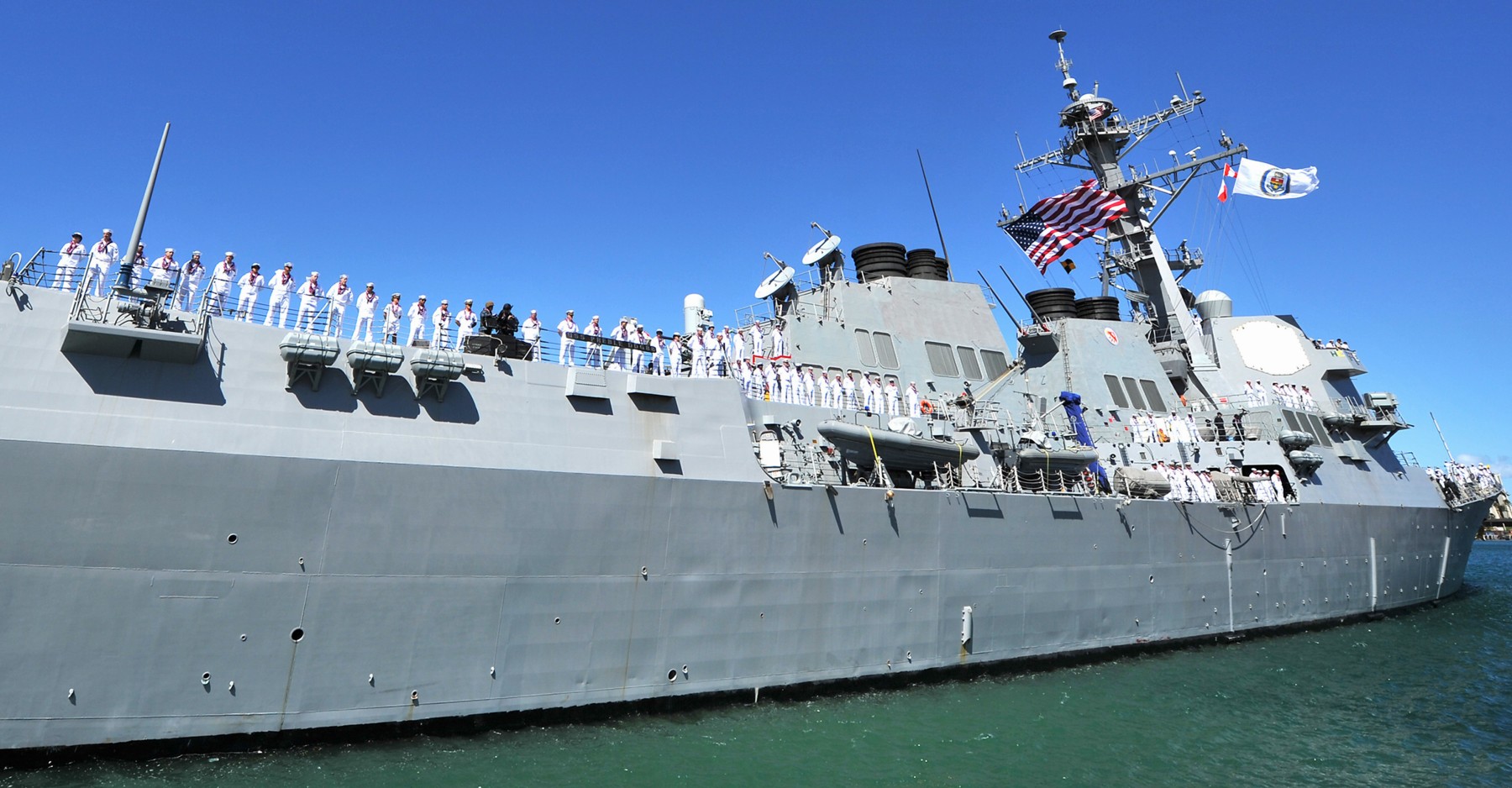 arriving at her new homeport, Joint Base Pearl Harbor-Hickam, Hawaii - August 14, 2014  departing Naval Base San Diego, California for a homeport shift to Joint Base Pearl Harbor-Hickam, Hawaii - August 8, 2014 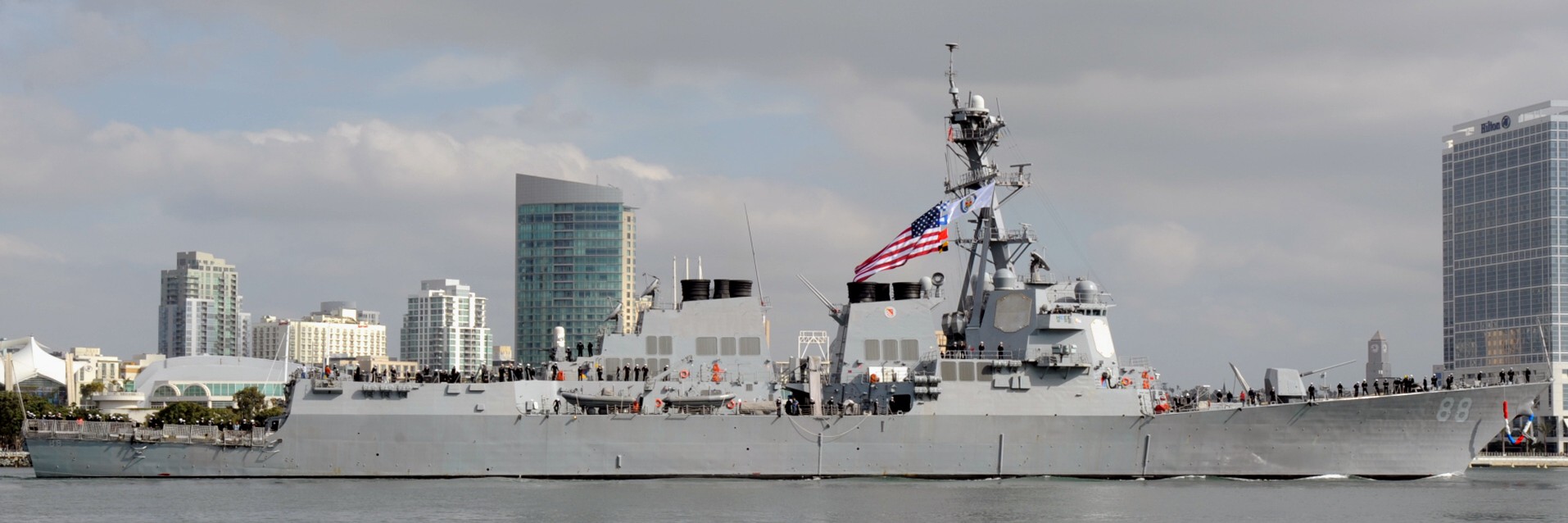 returning to Naval Base San Diego, California - November 18, 2013  Pacific Ocean - October 2013  Pacific Ocean - August 2013 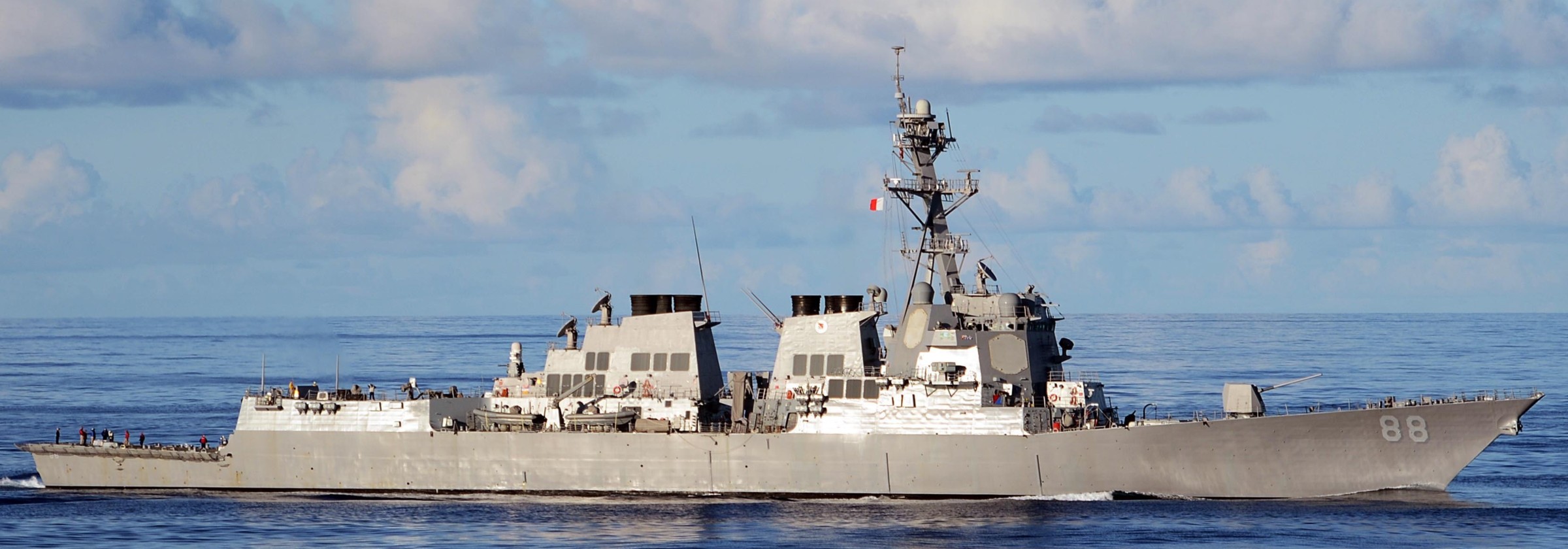 Philippine Sea - July 2013 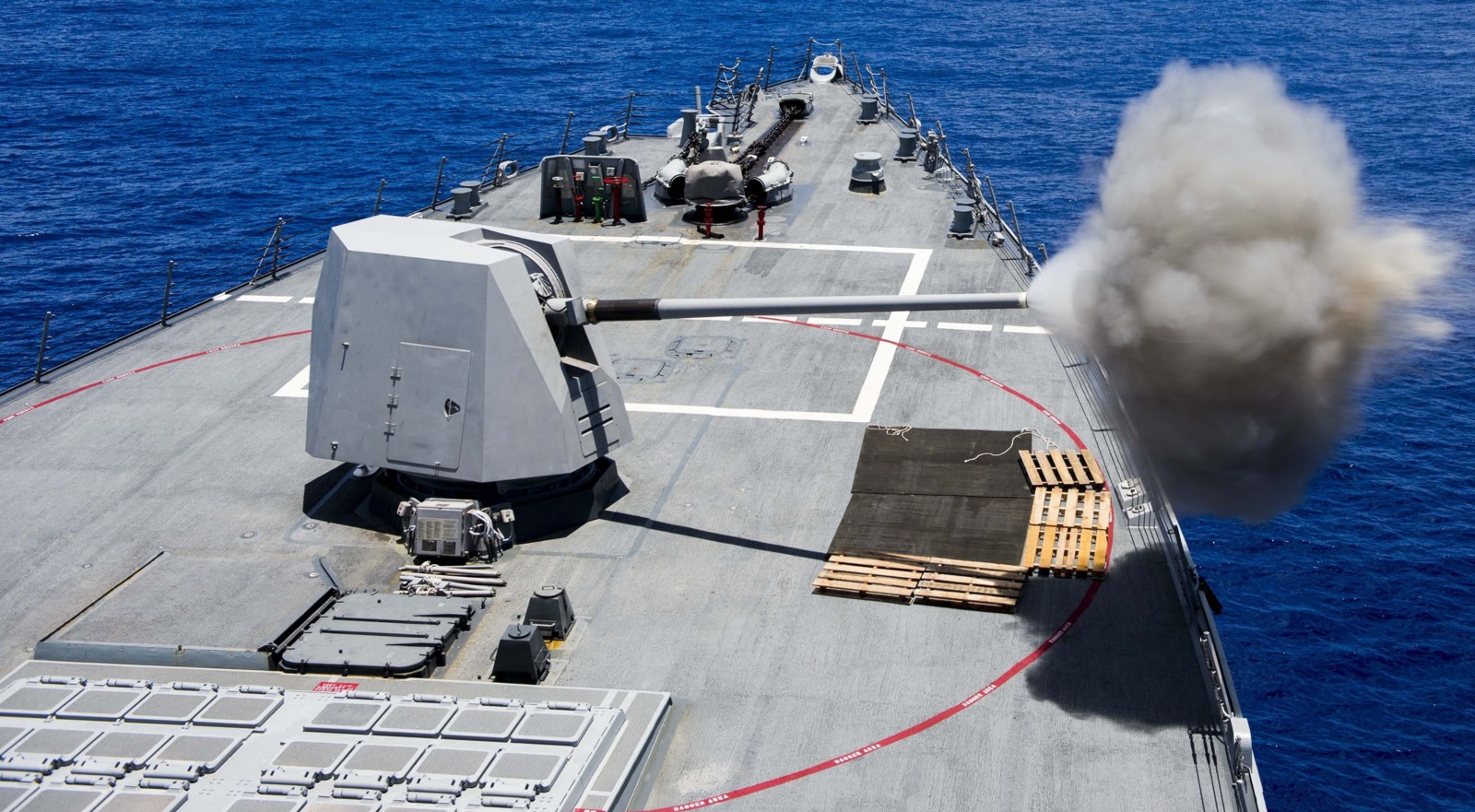 Mk.45 Mod.4 gun fire exercise - June 2013  Mk.38 Mod.1 machine gun fire exercise - June 2013 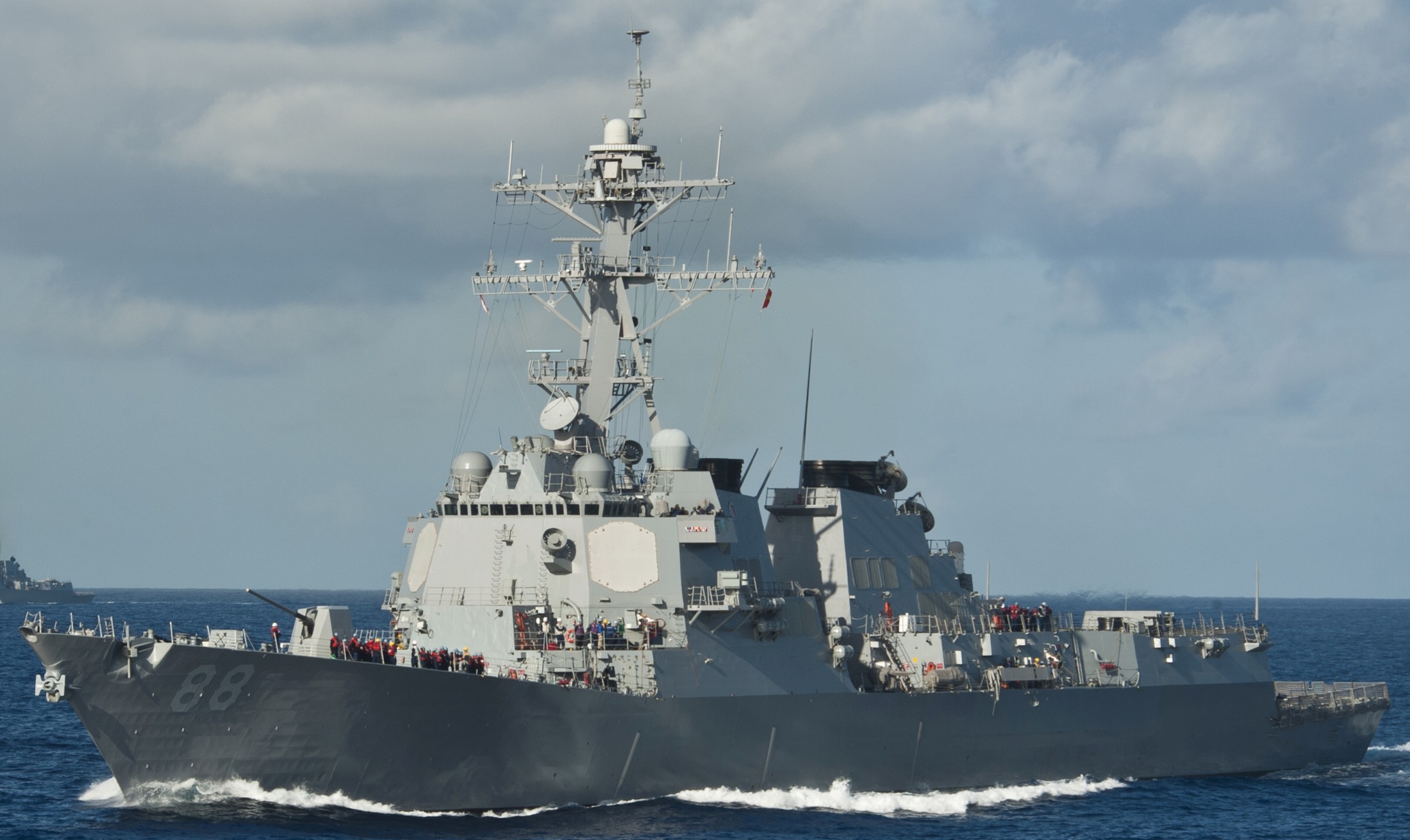 Pacific Ocean - April 2013 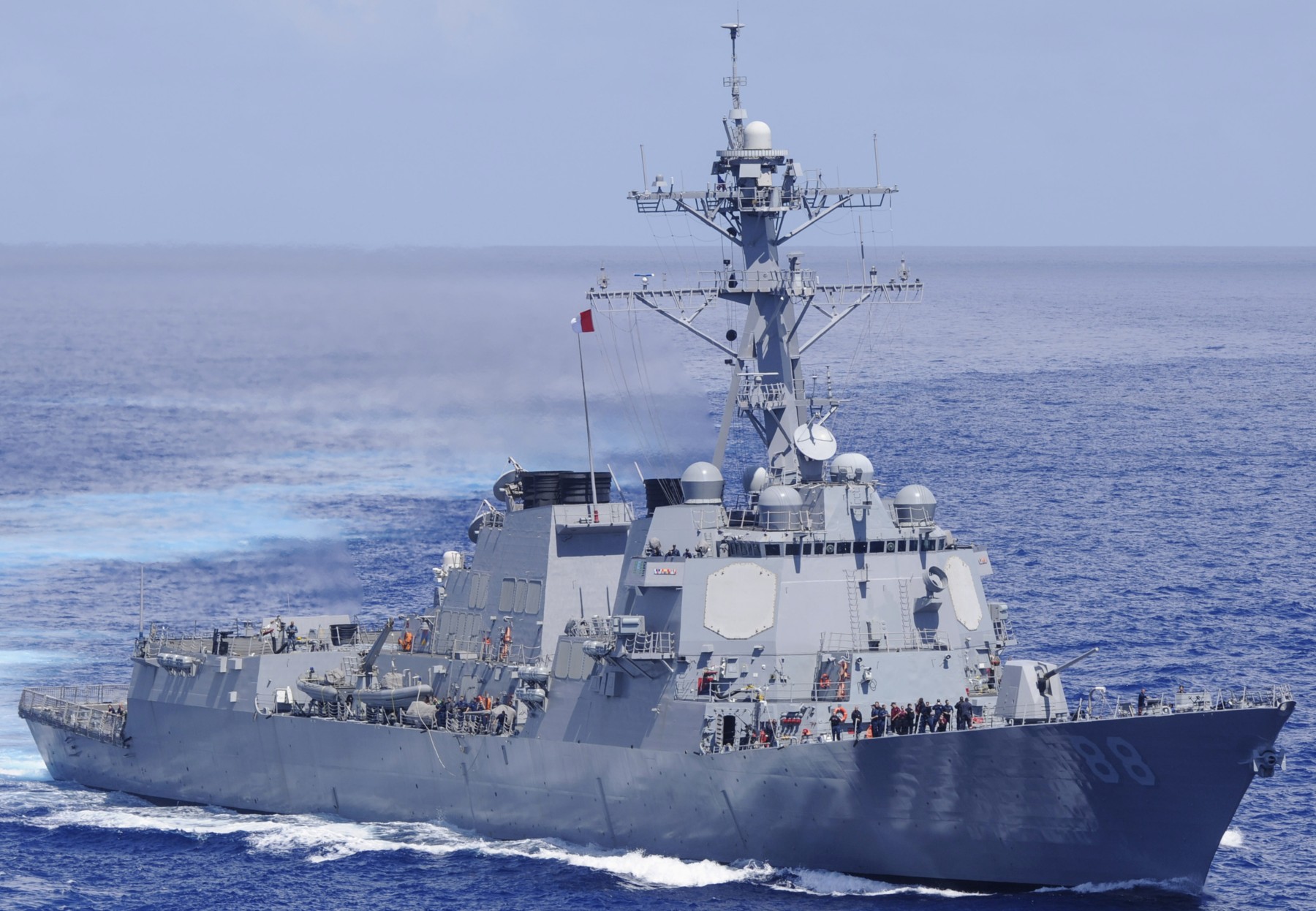 Pacific Ocean - April 2013 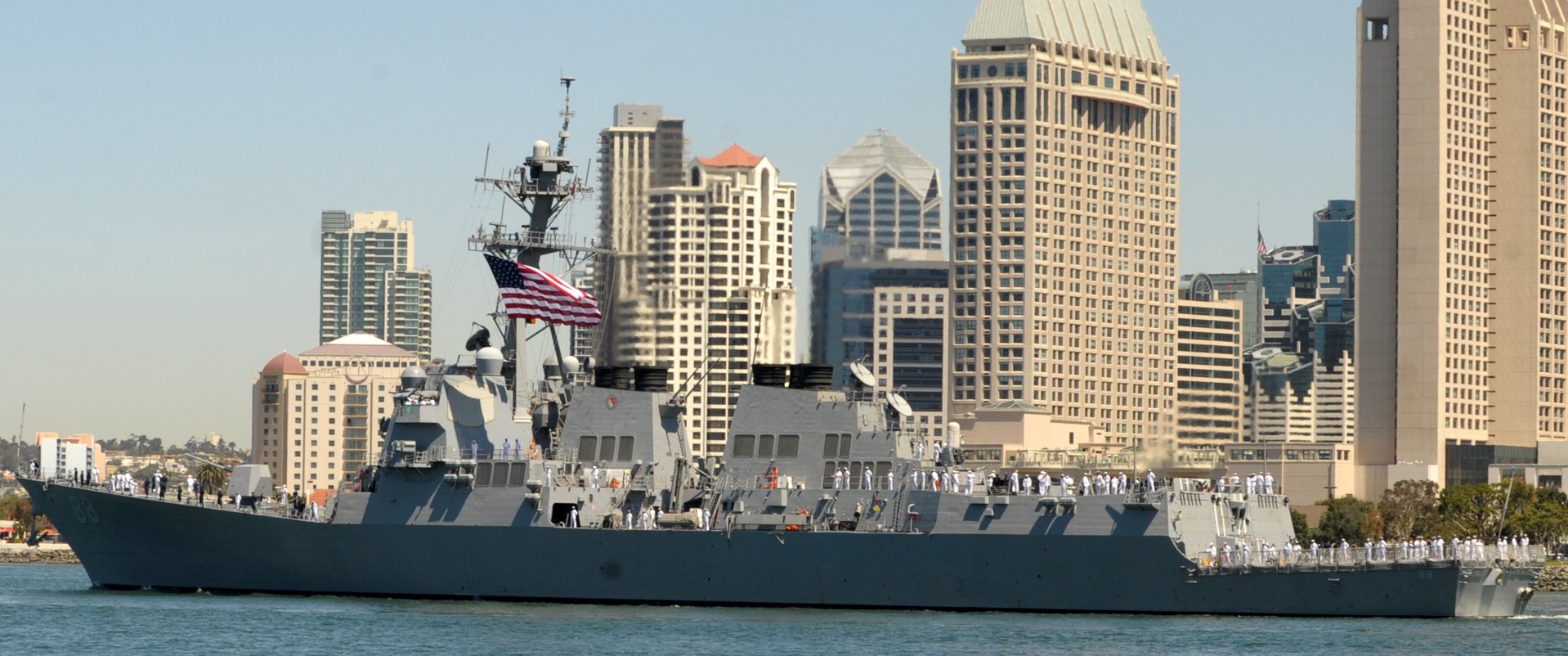 departing Naval Base San Diego, California - April 19, 2013 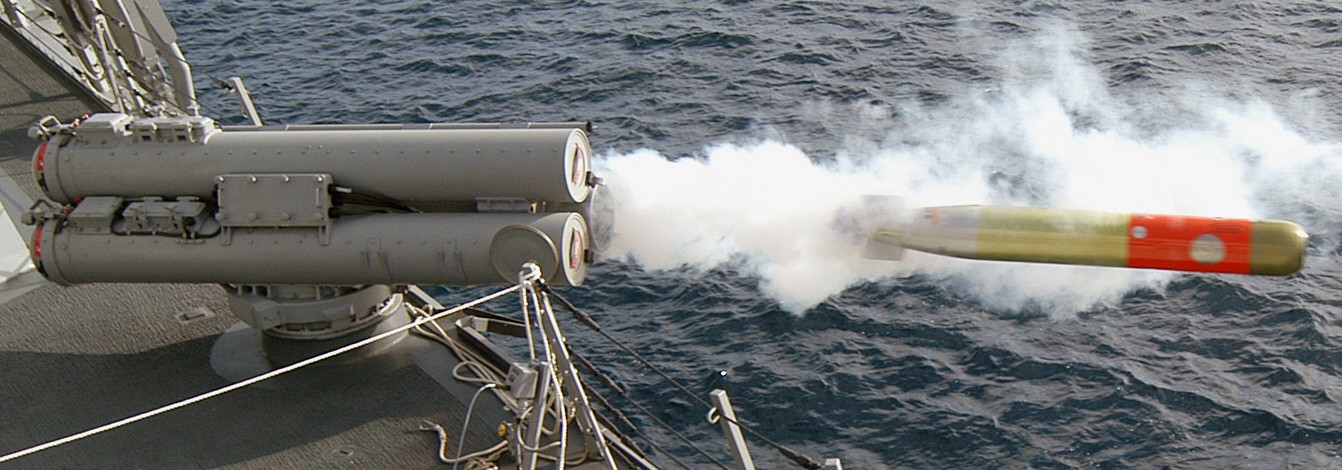 Mk.32 torpedo tubes exercise - Pacific Ocean - February 2013  departing Naval Base San Diego, California - February 6, 2013 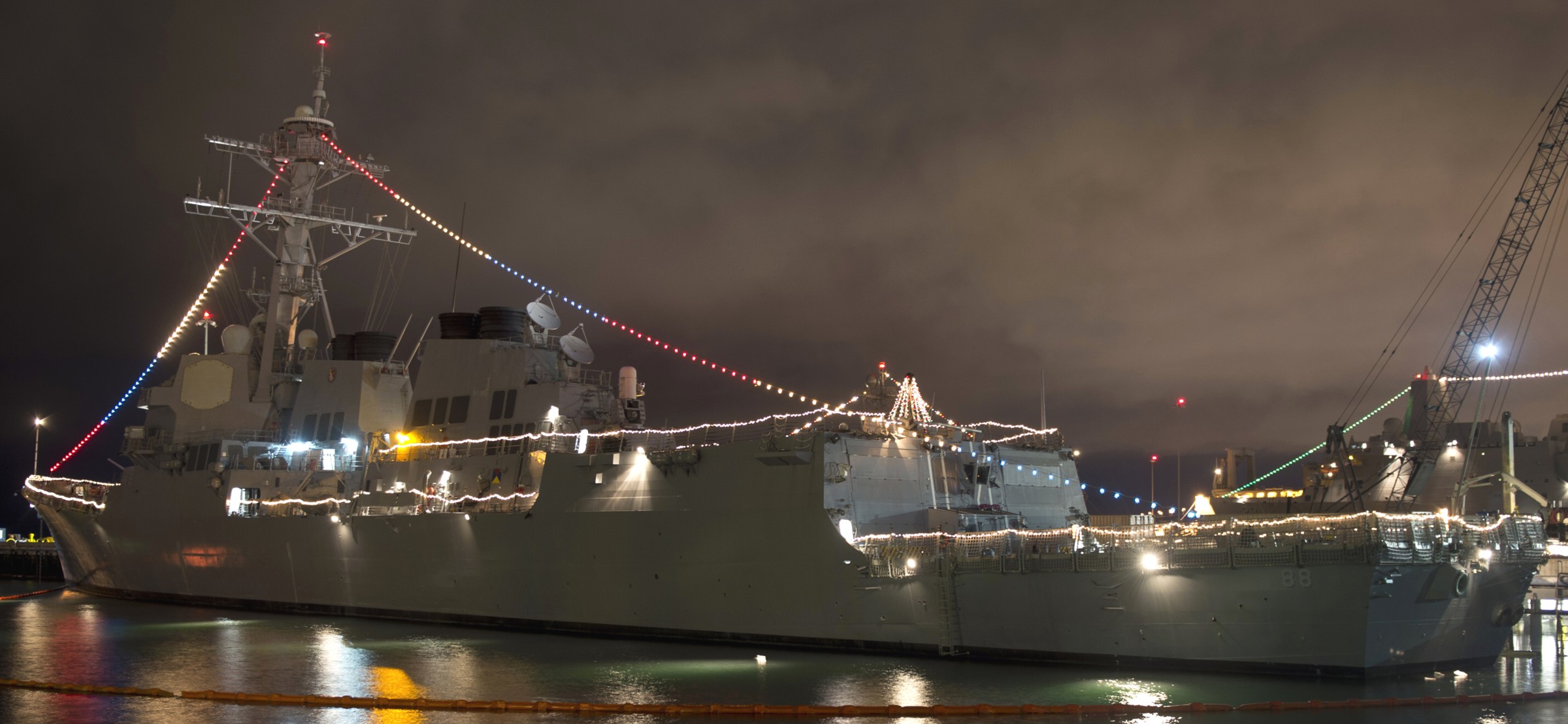 holiday lights - Naval Base San Diego, California - December 2012 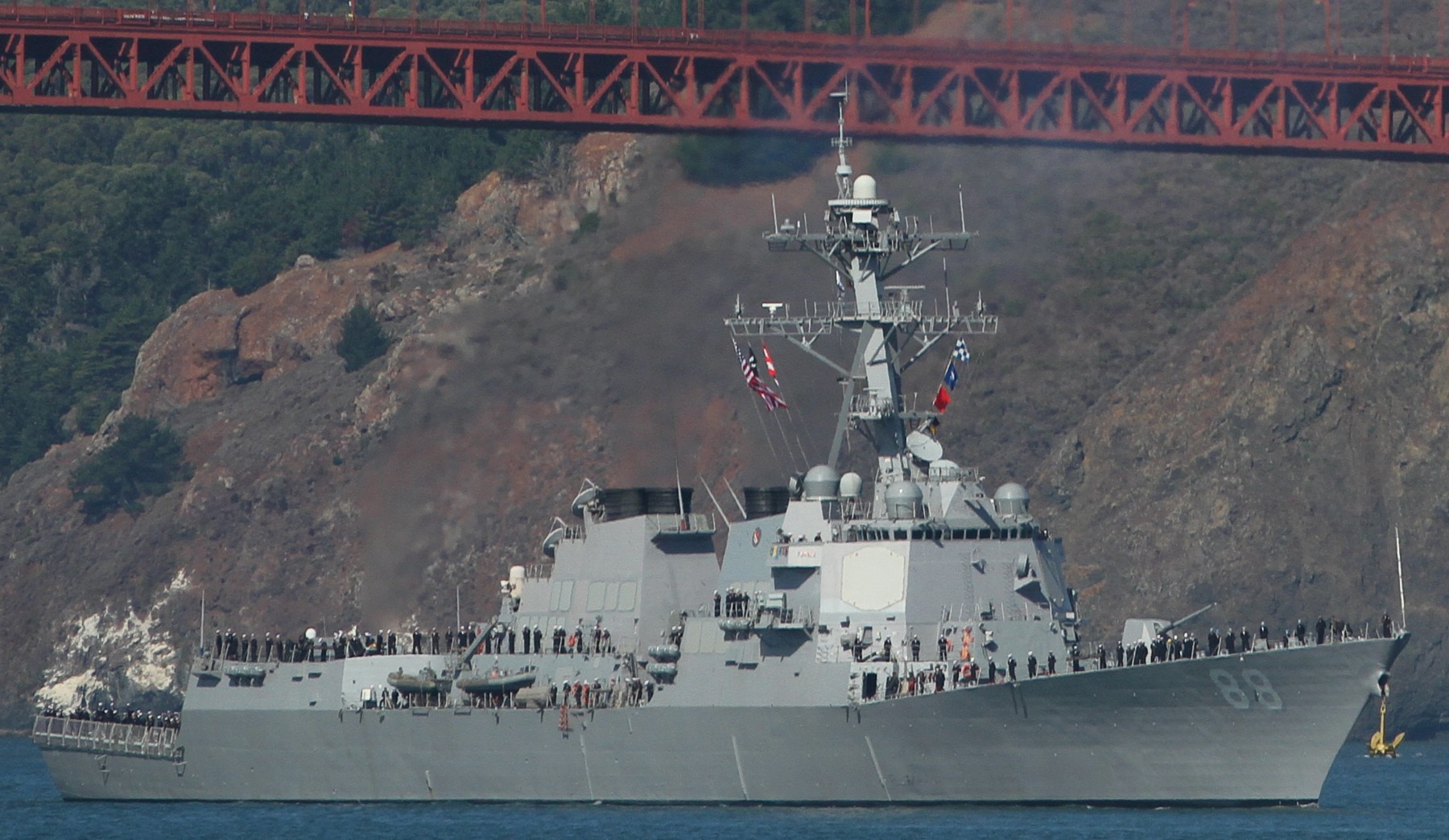 San Francisco Fleet Week - October 2012  San Francisco Fleet Week - October 2012 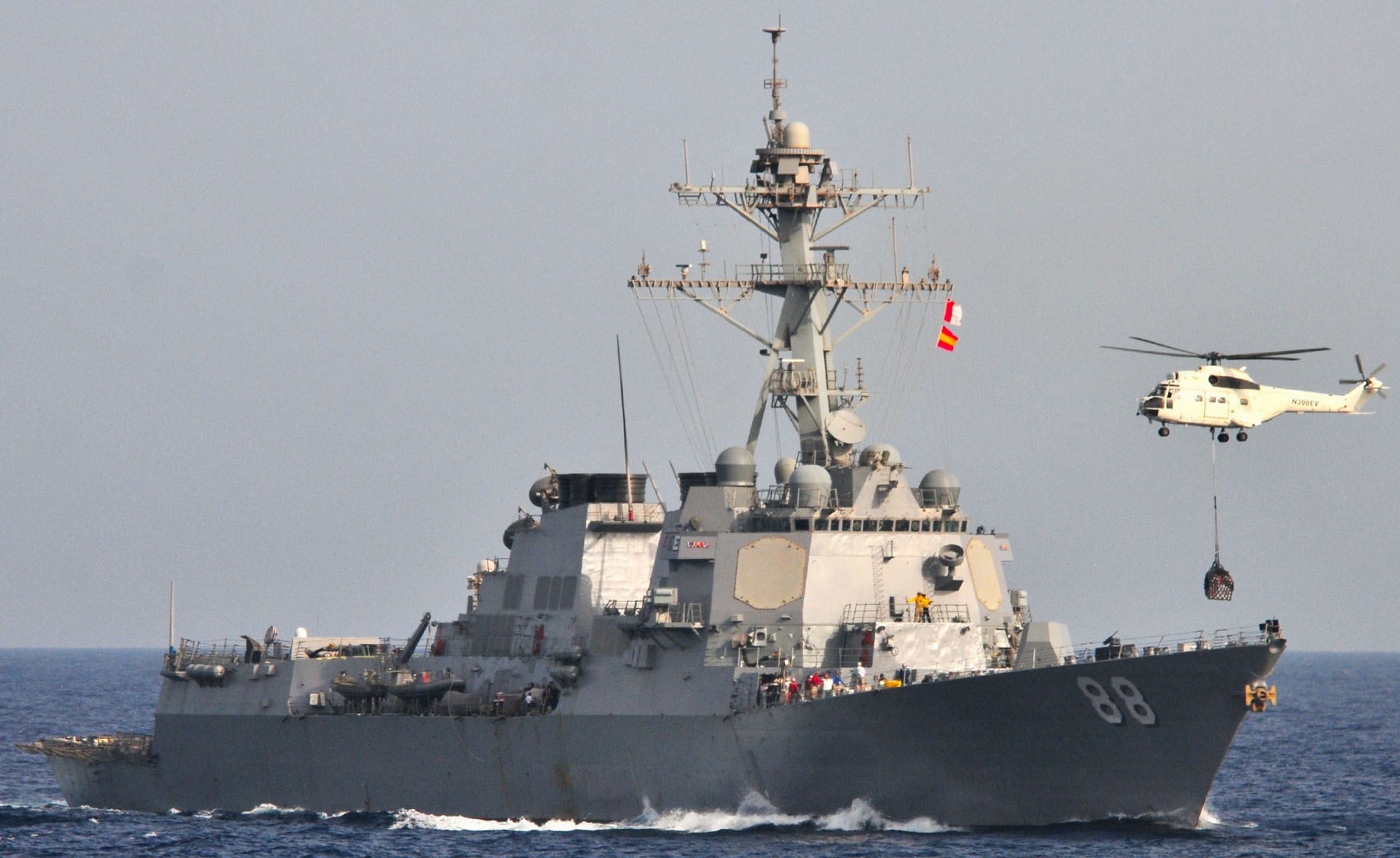 5th Fleet AOR - June 2011  forward Mk.41 vertical launching system (VLS), 32 cells - Gulf of Aden - May 2011 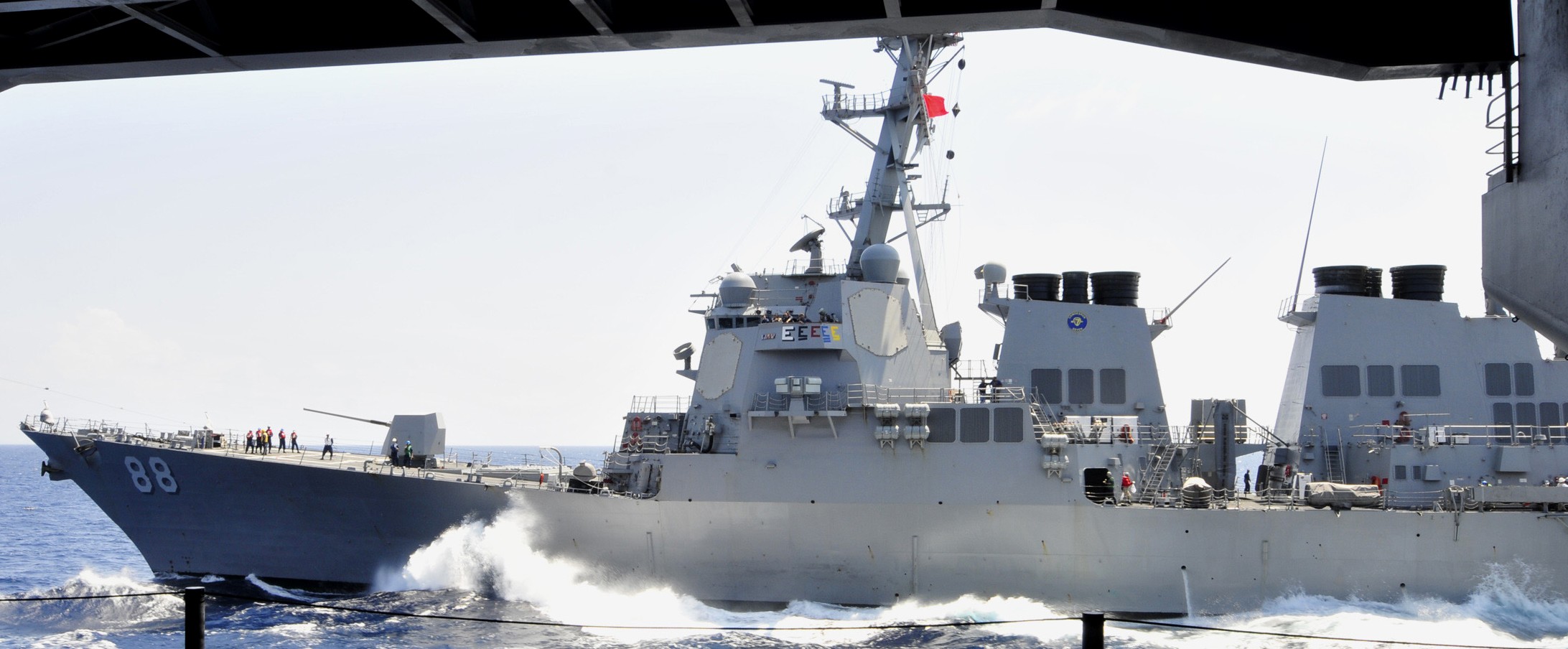 Indian Ocean - May 2011 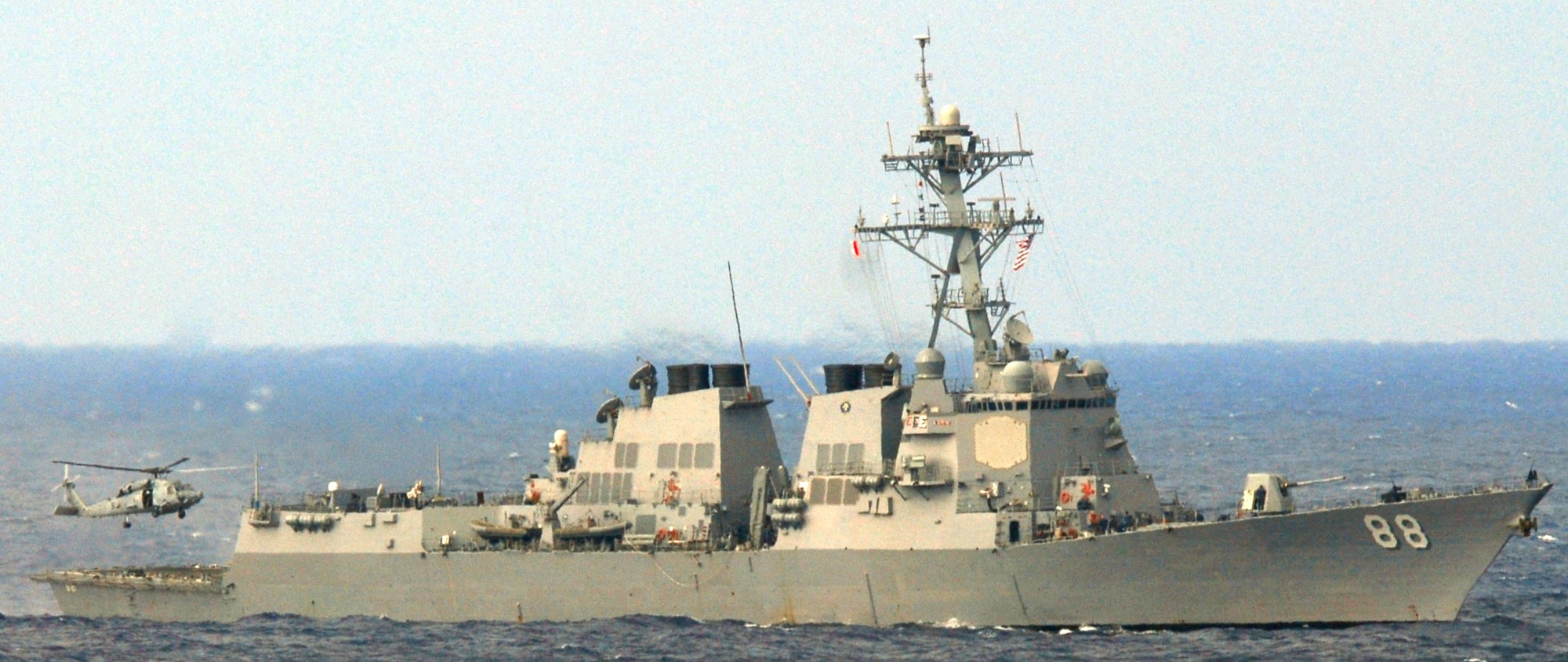 Pacific Ocean - April 2011 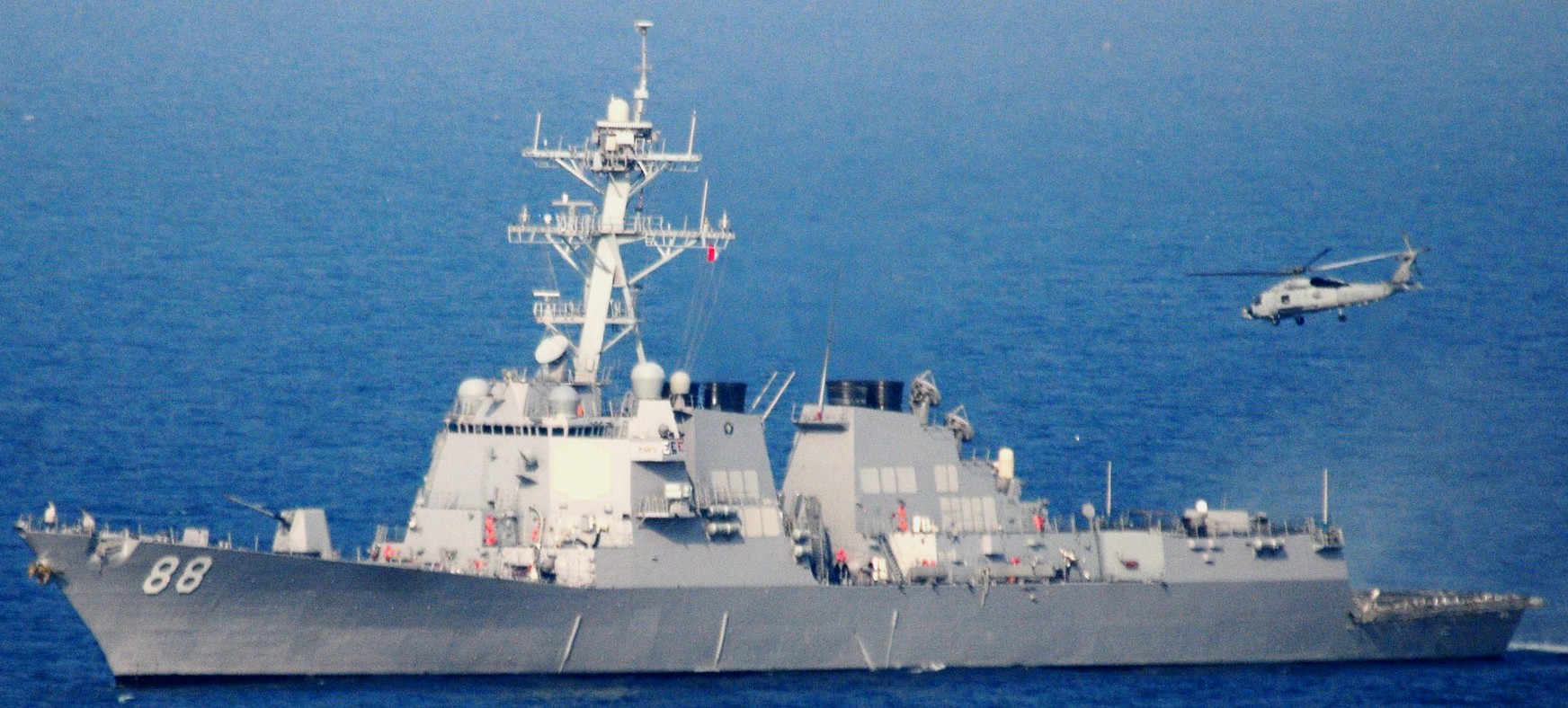 off Japan - March 2011 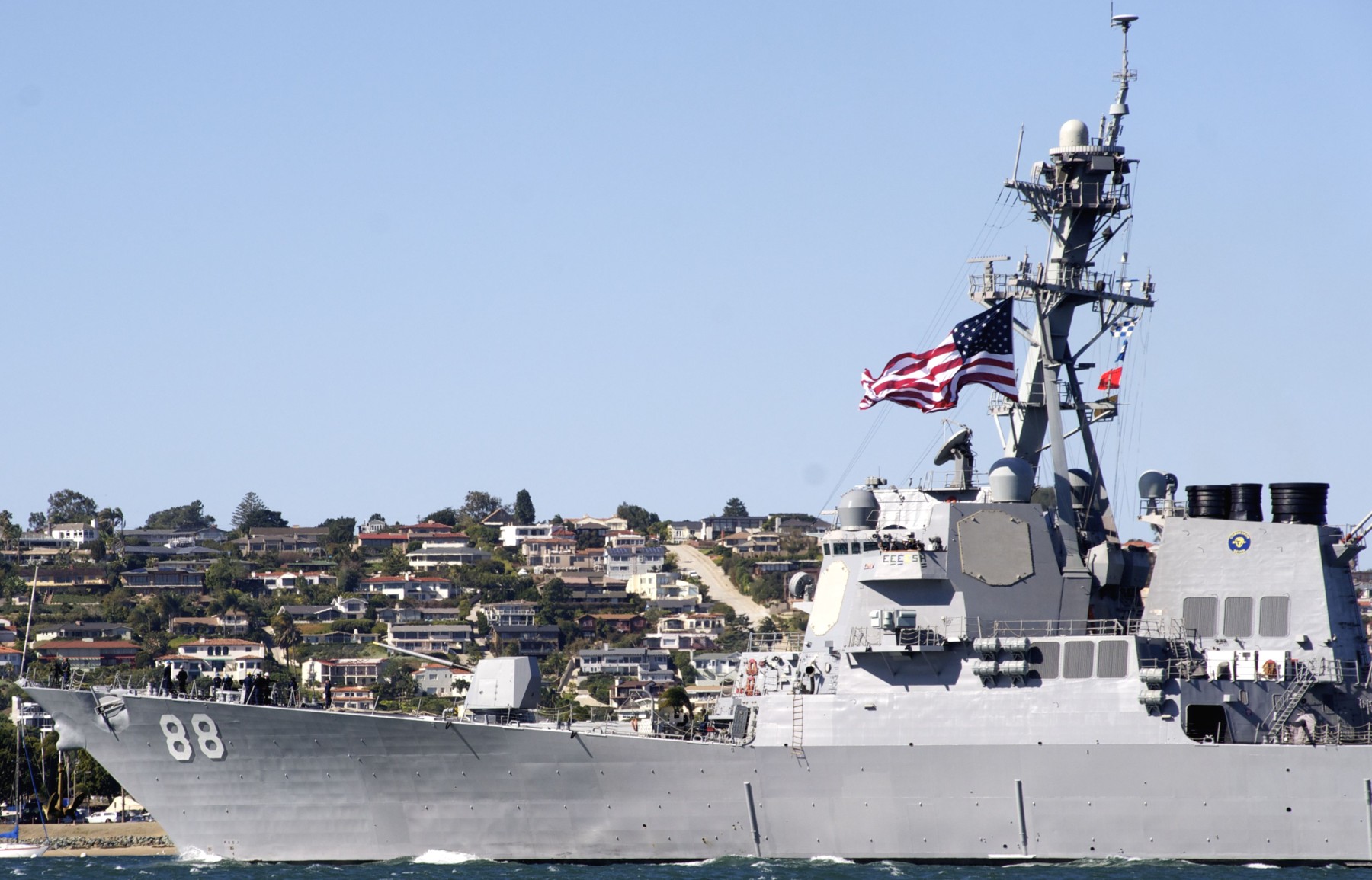 departing Naval Base San Diego, California - February 2, 2011  departing Naval Base San Diego, California - February 2, 2011 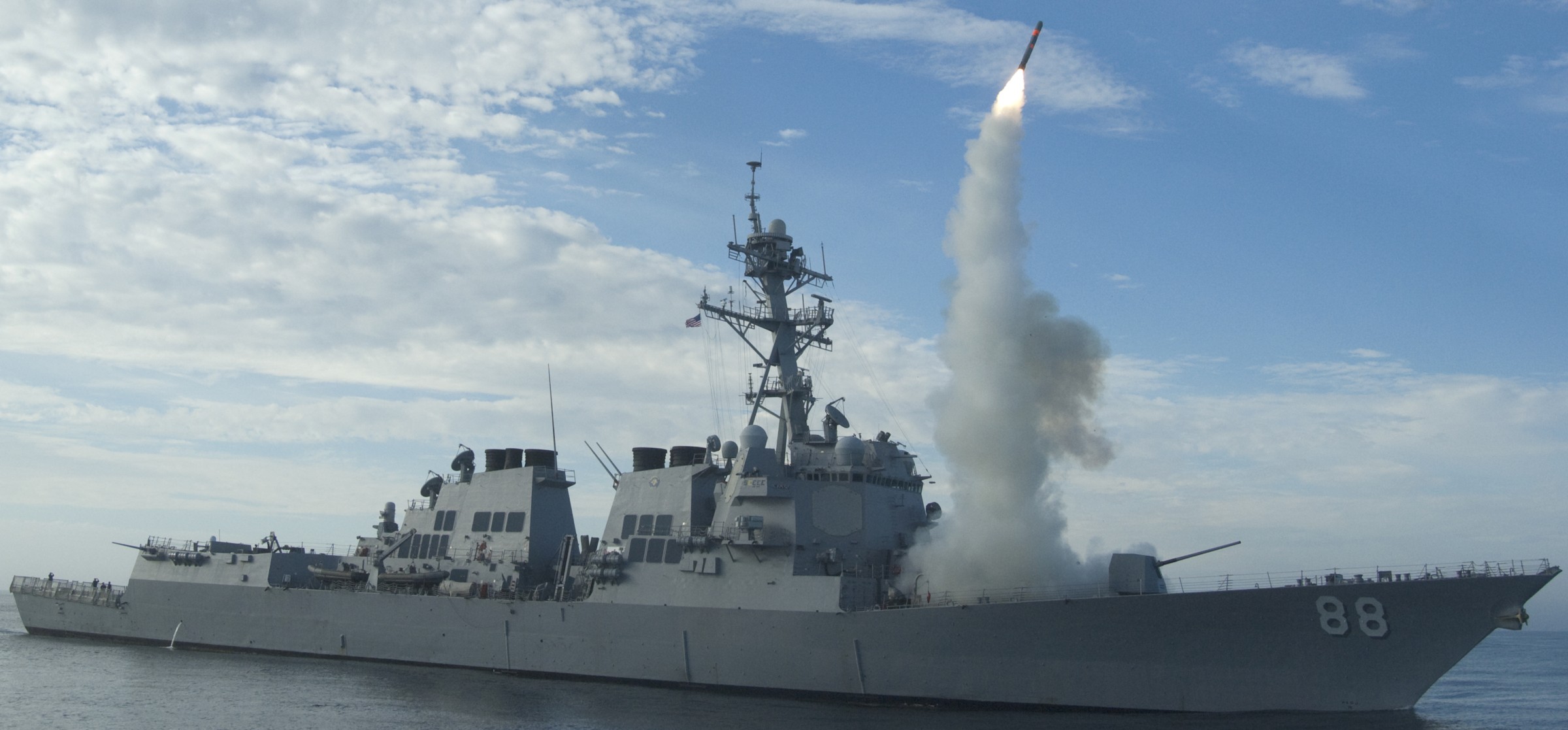 launching a BGM-109 Tomahawk TLAM missile - off California - September 2010 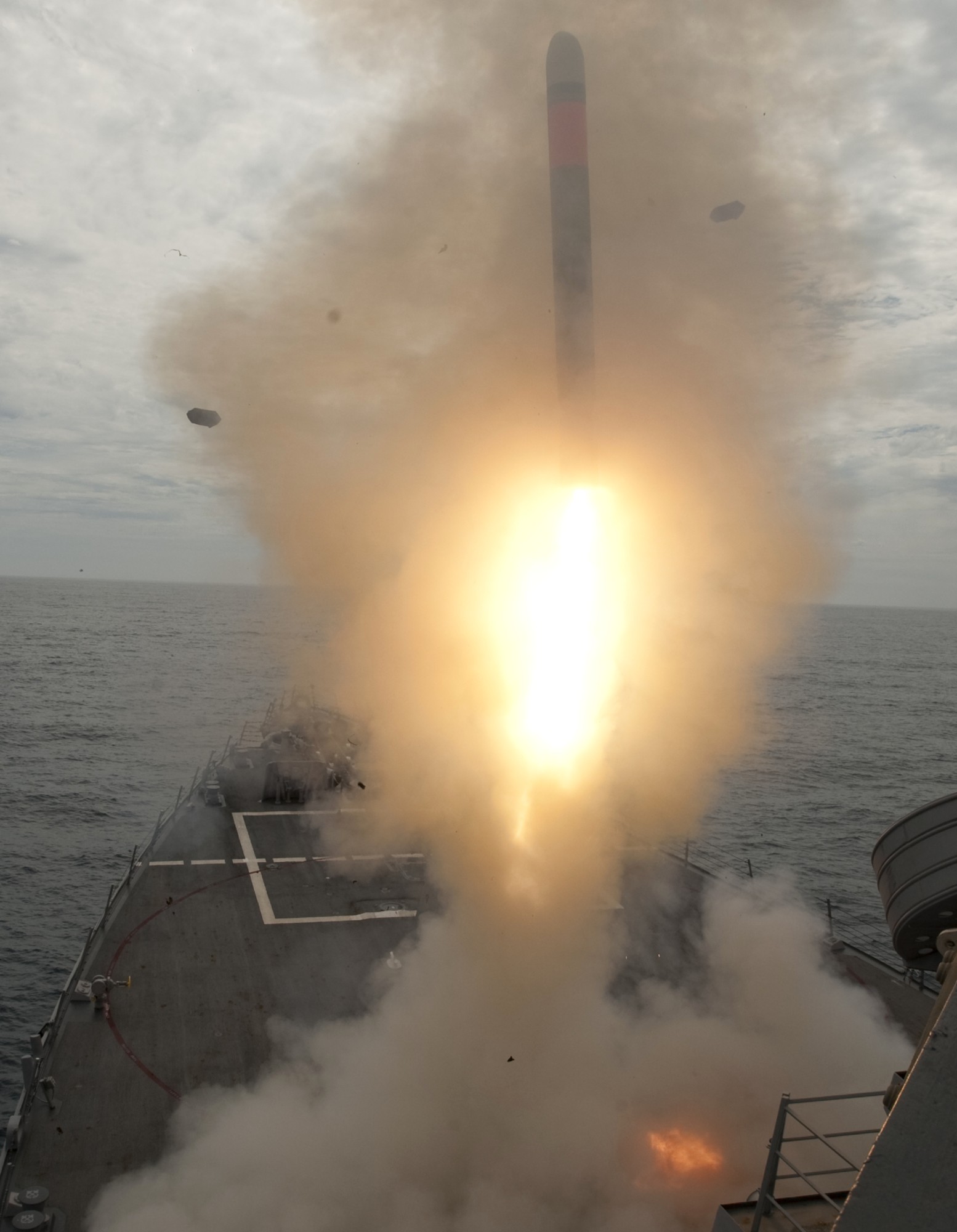 launching a BGM-109 Tomahawk TLAM missile - off California - September 2010 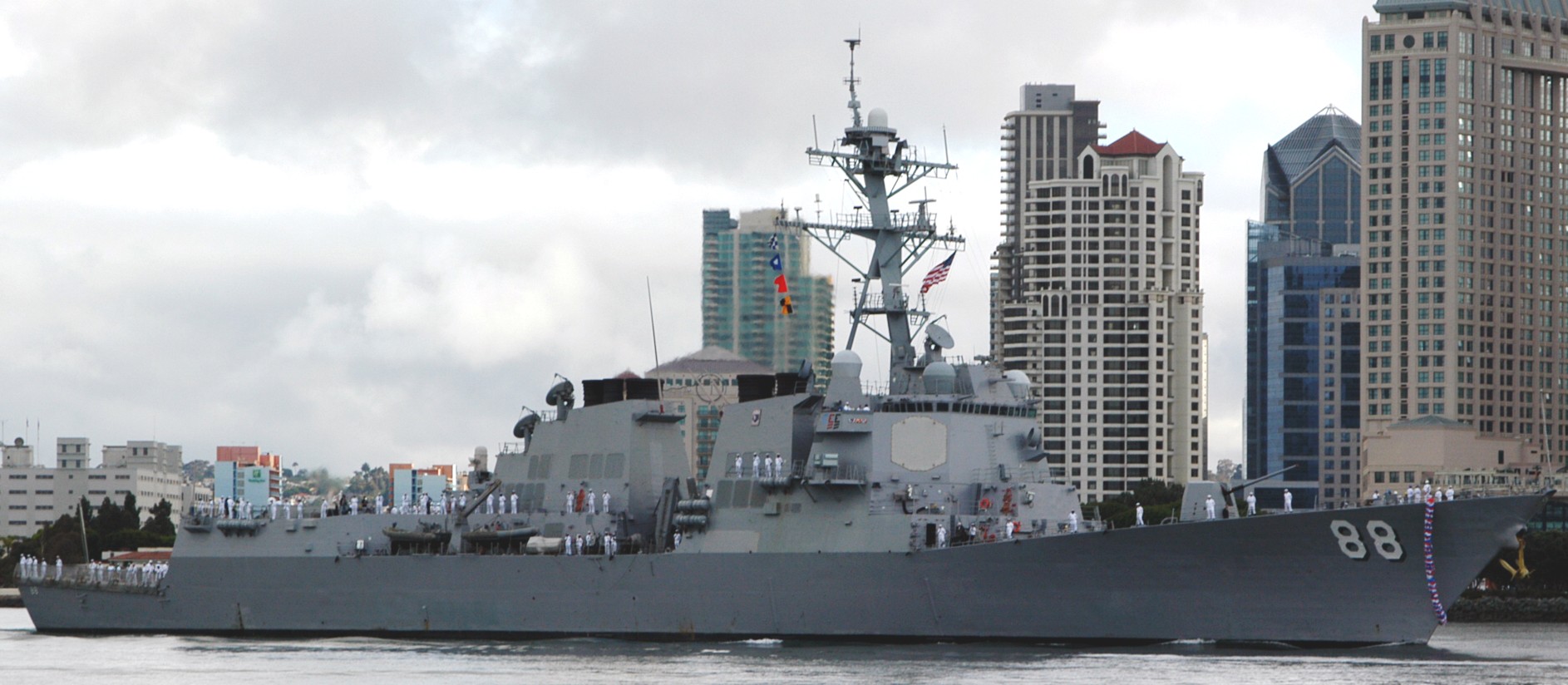 returning to Naval Base San Diego, California - June 16, 2009 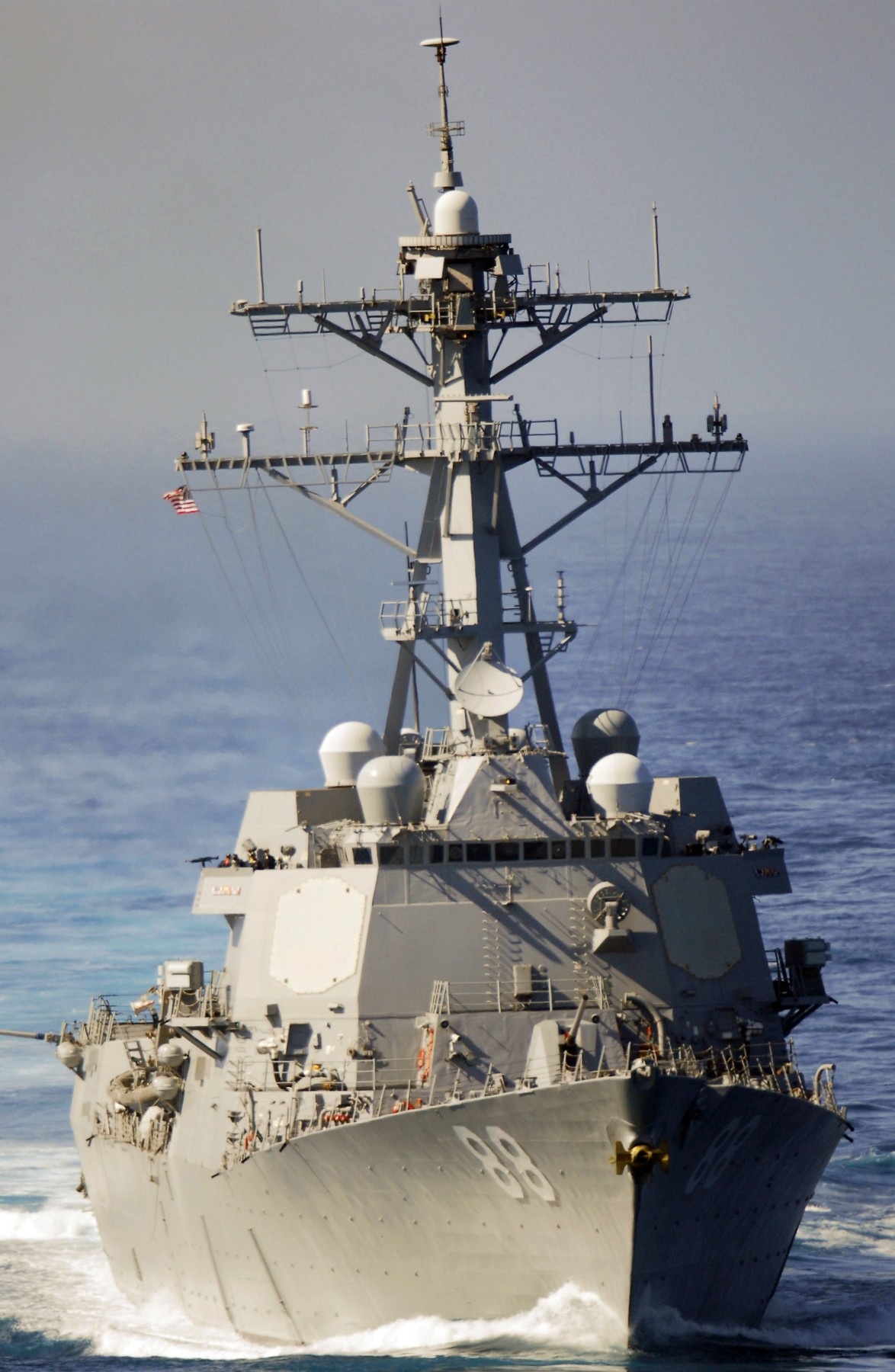 Pacific Ocean - October 2008 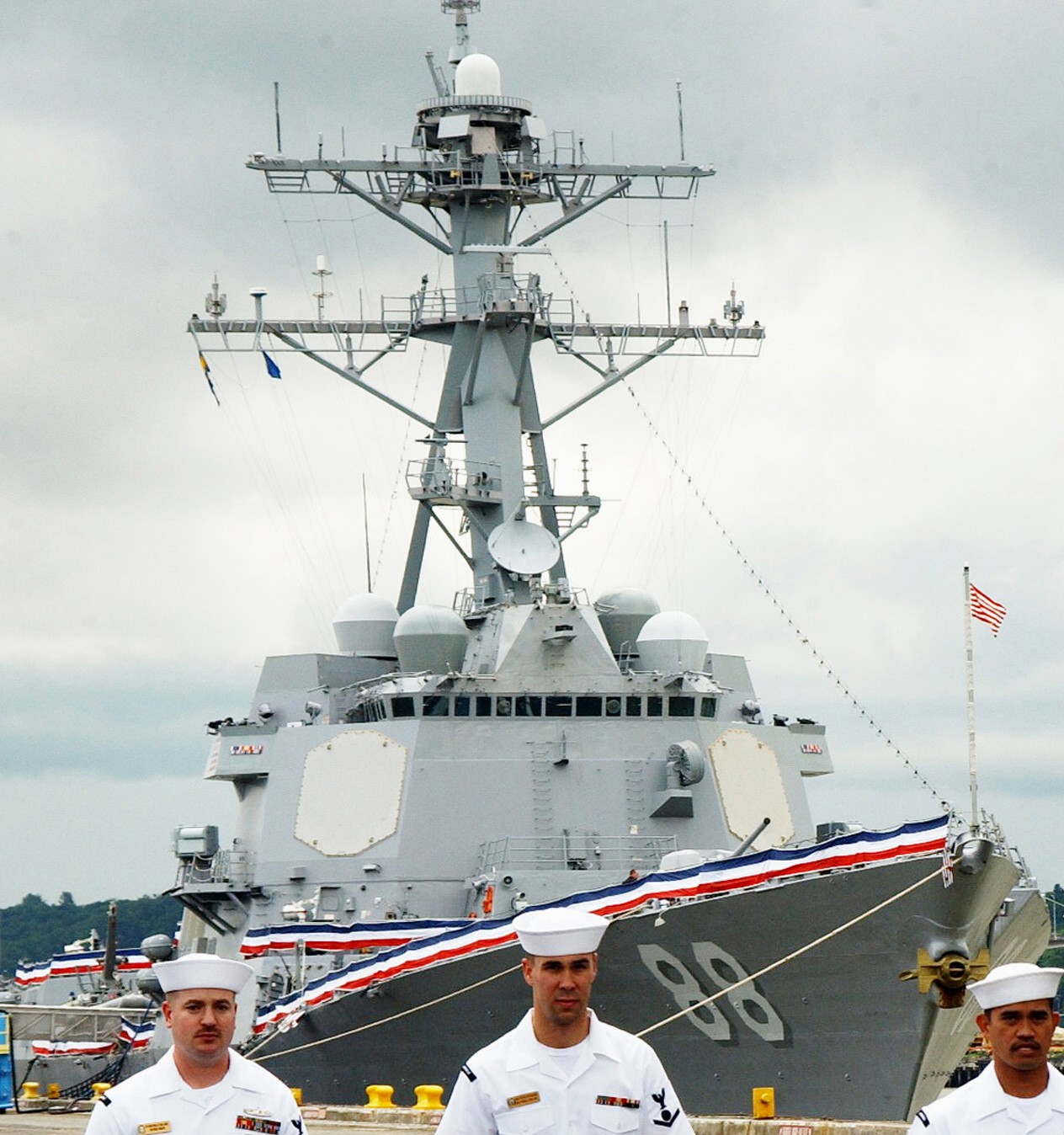 Seattle, Washington - May 2008  returning to Naval Base San Diego, California - August 29, 2007  returning to Naval Base San Diego, California - August 29, 2007 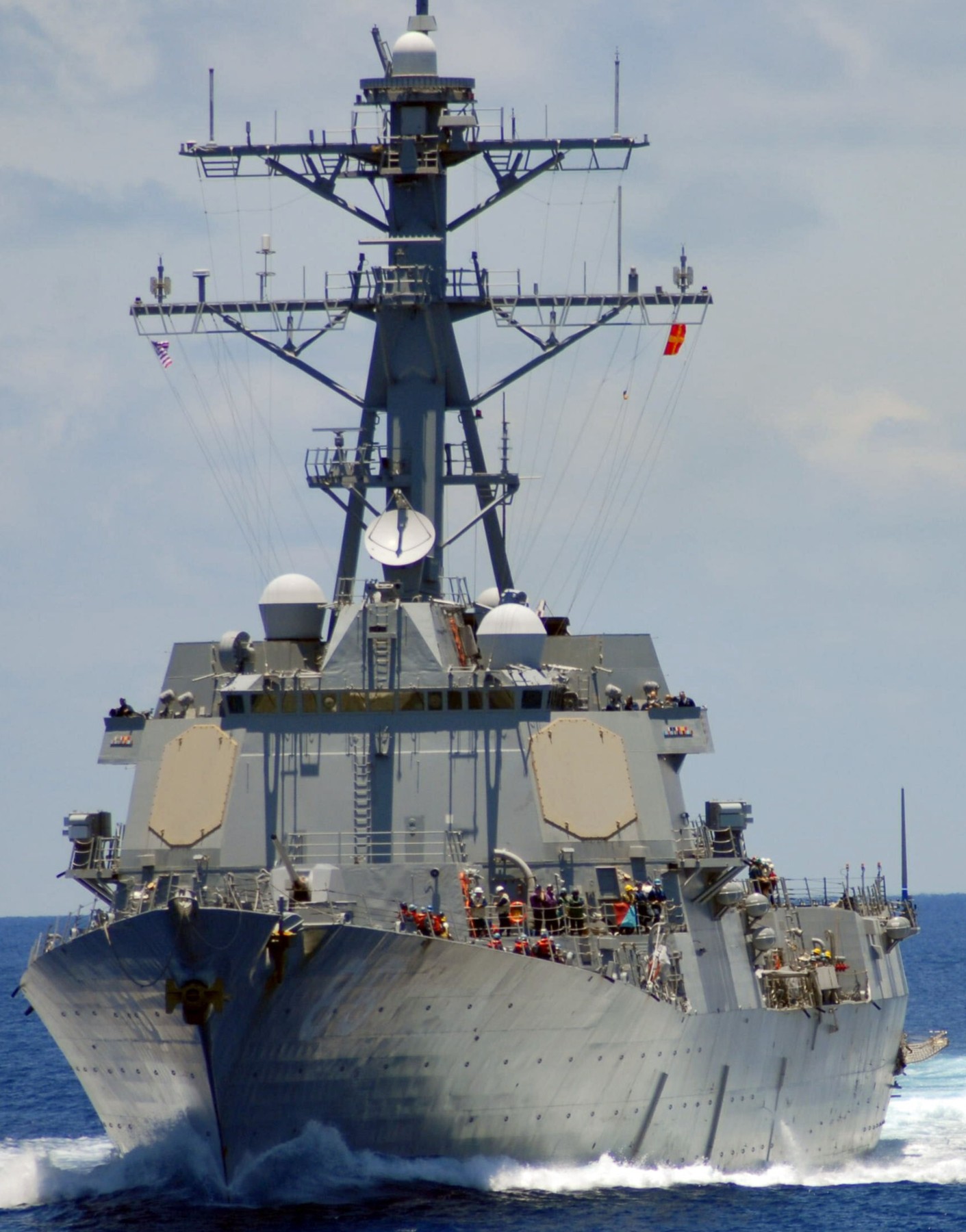 South China Sea - July 2007 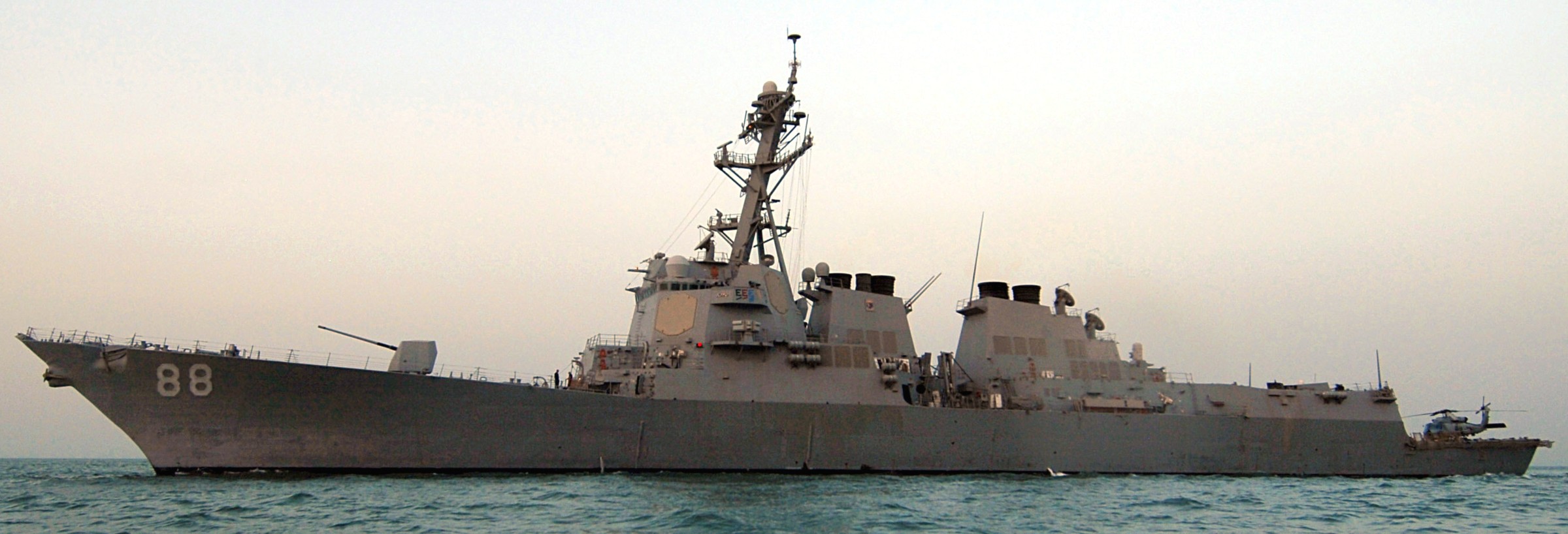 Persian Gulf - June 2007 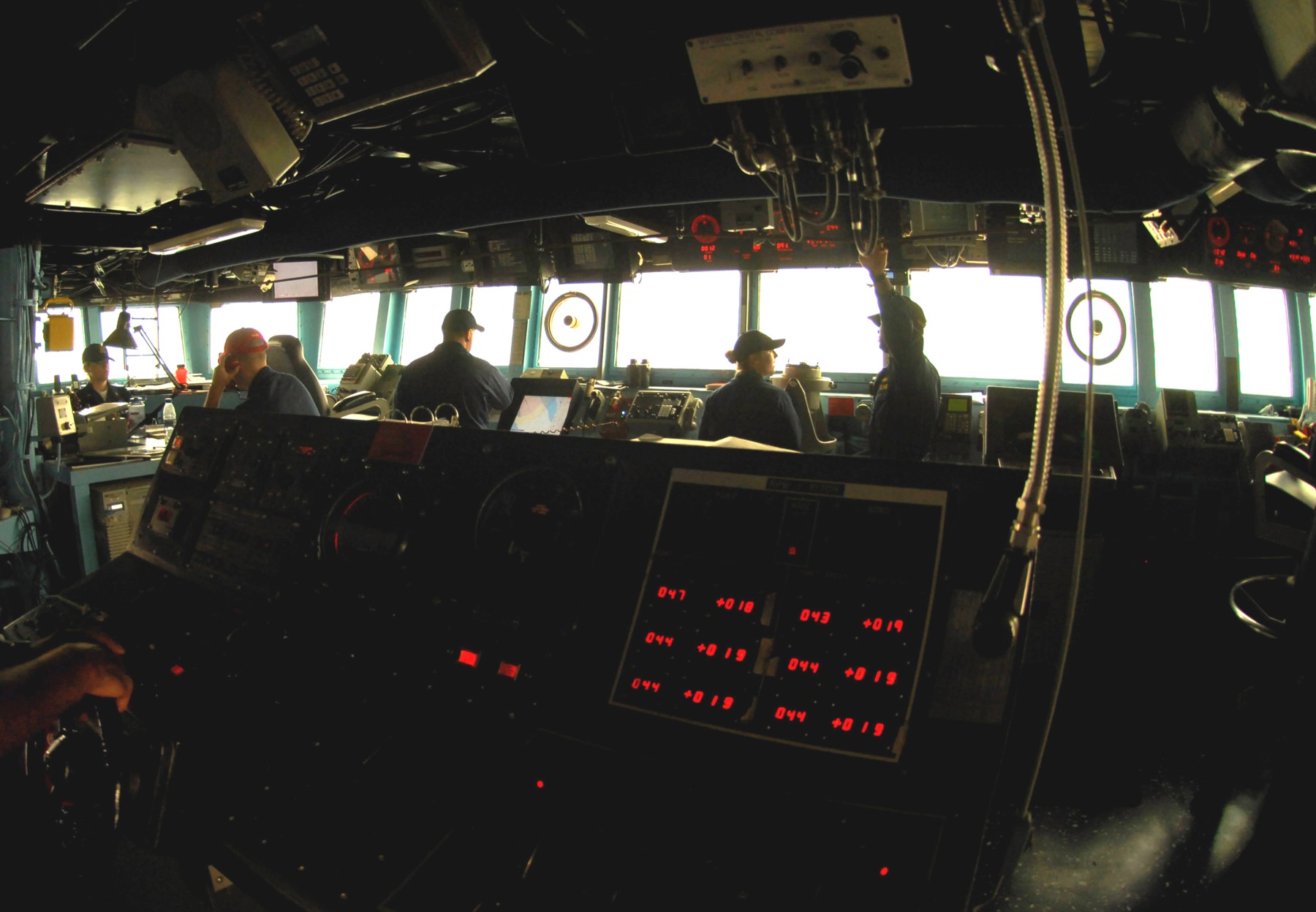 Persian Gulf - May 2007 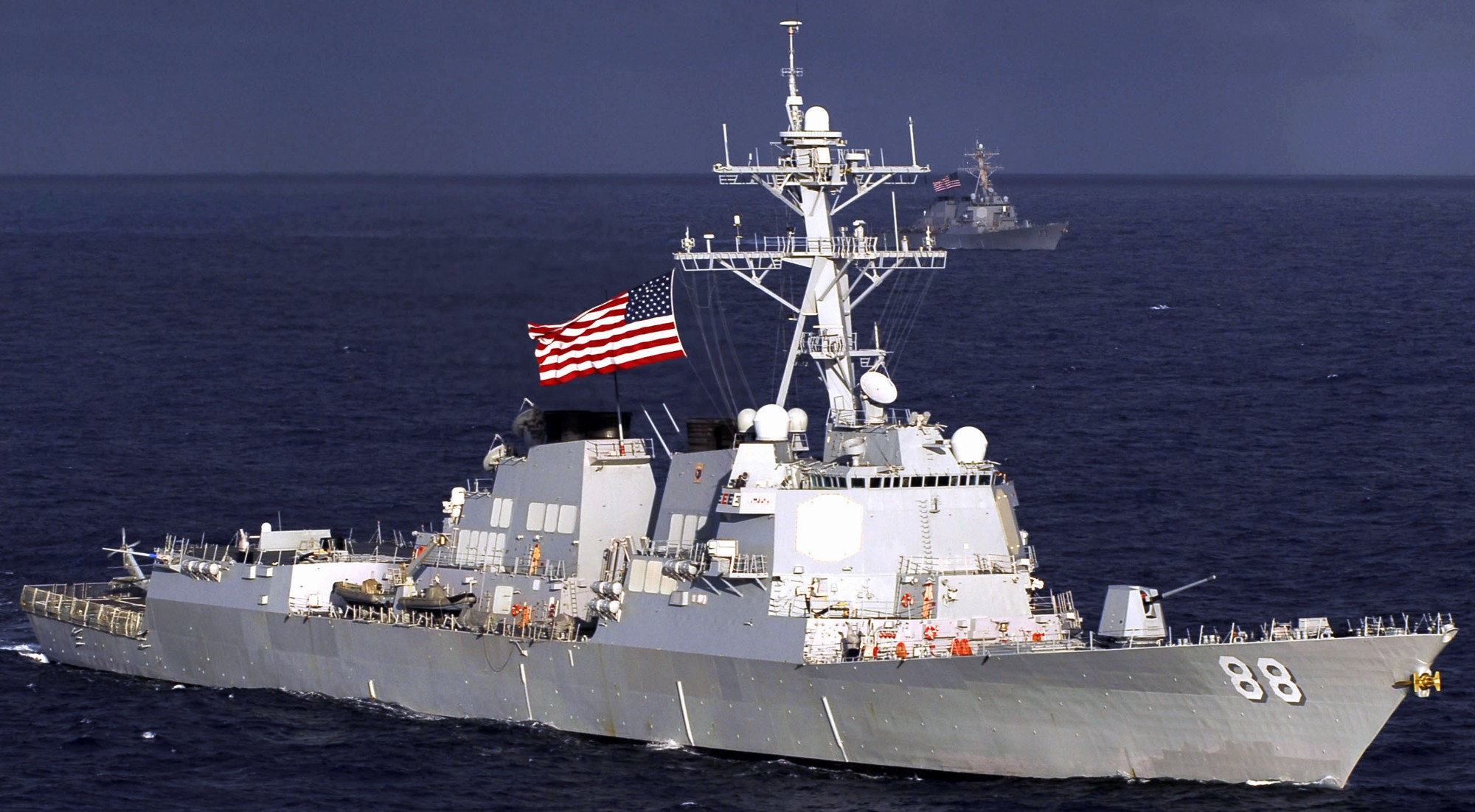 Pacific Ocean - February 2007 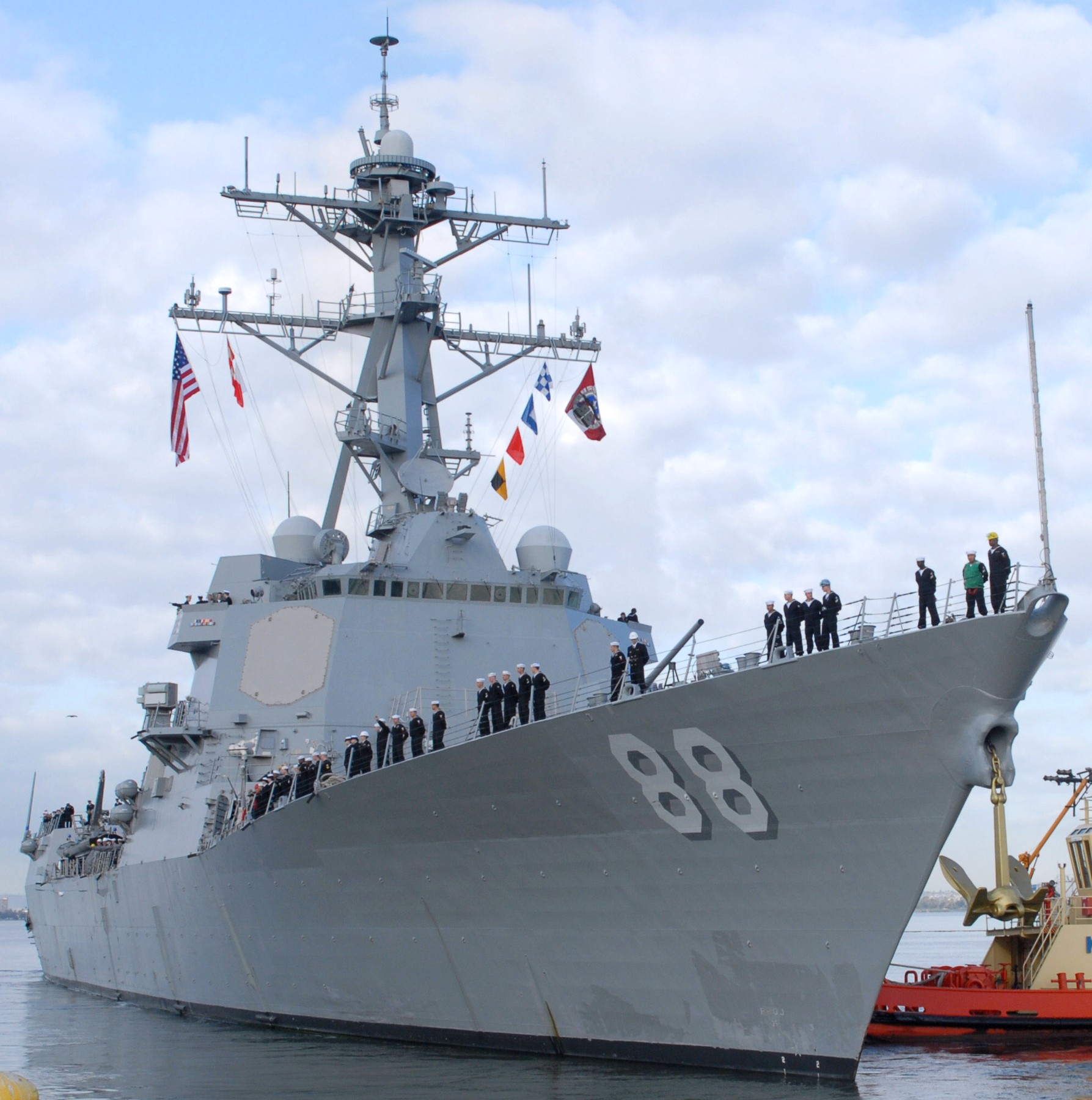 departing Naval Base San Diego, California - January 2007  Portland, Oregon - June 2006  Portland, Oregon - June 2006 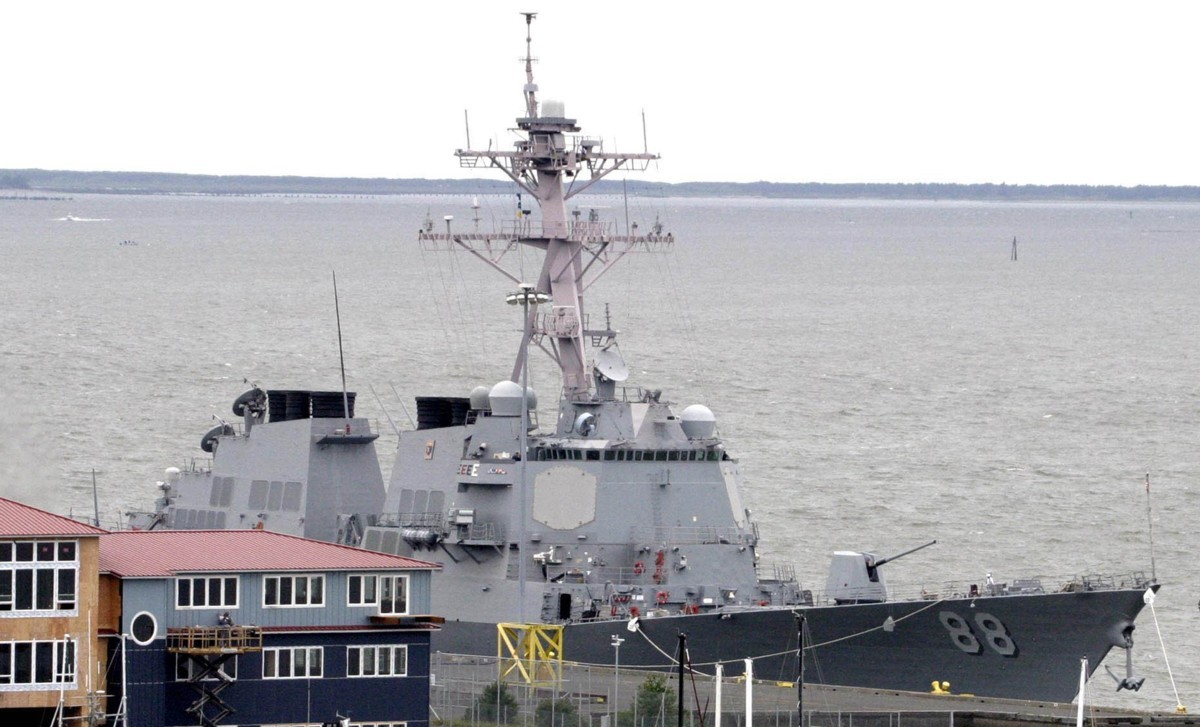 Astoria, Oregon - June 2006 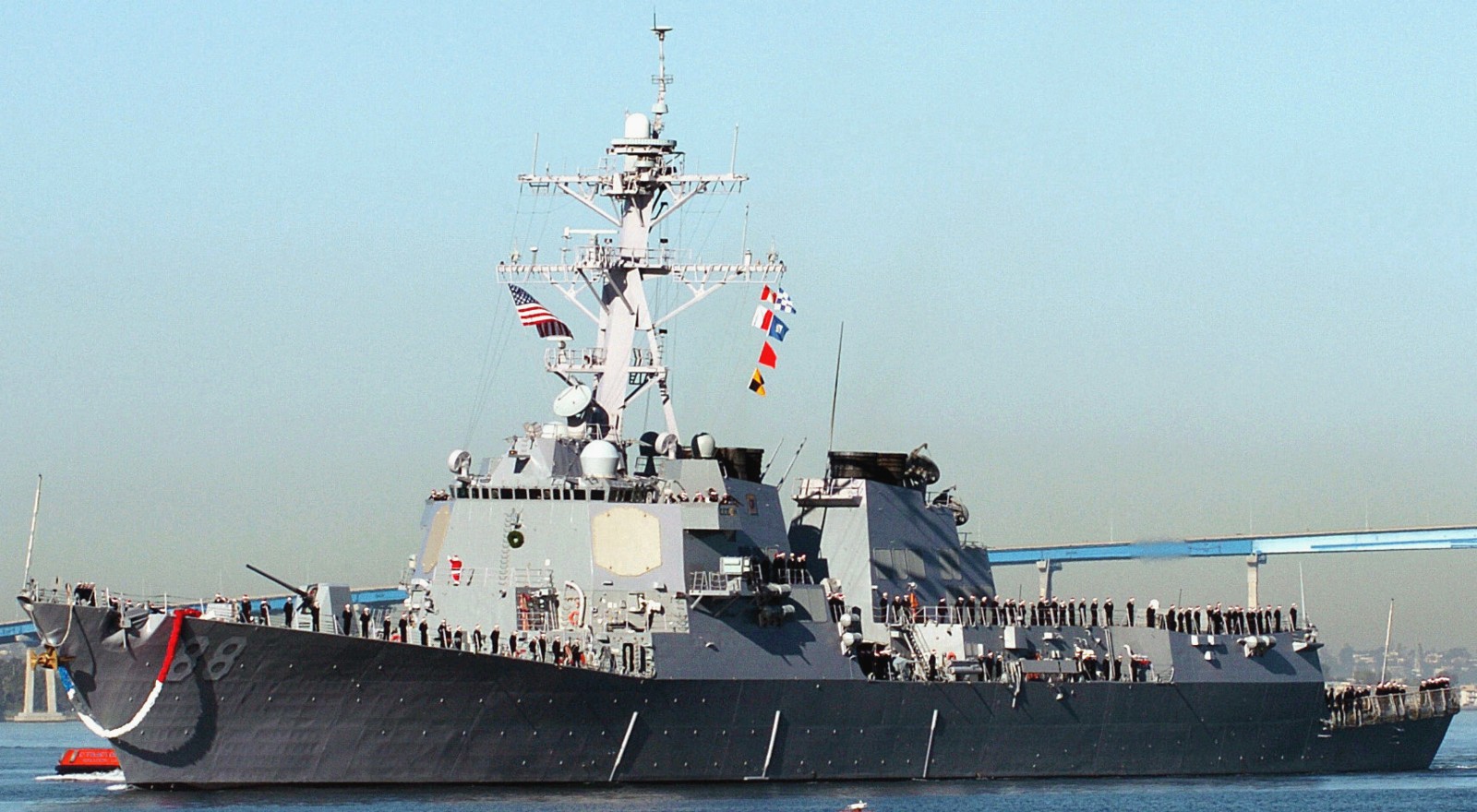 returning to Naval Base San Diego, California - December 17, 2004 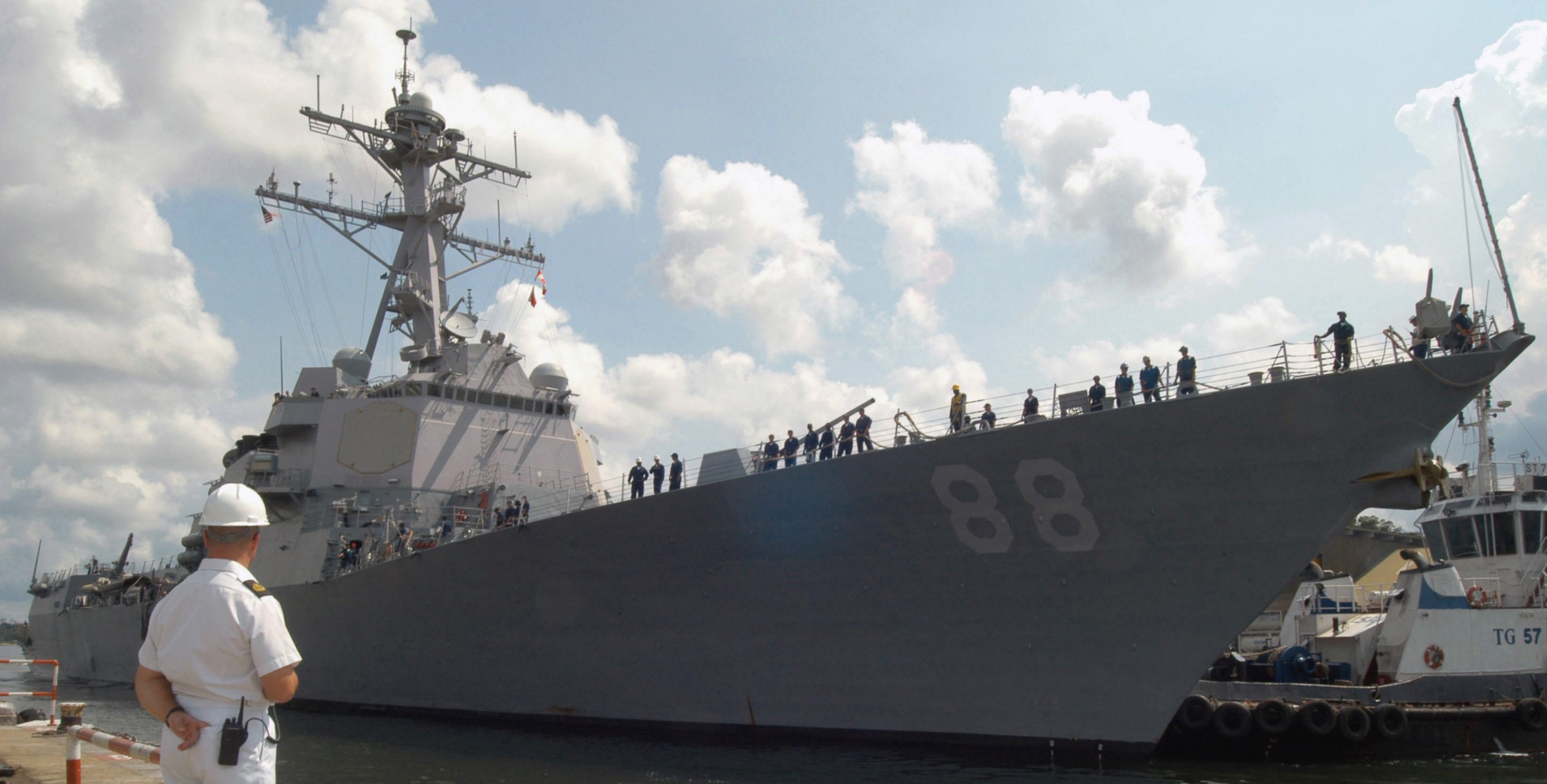 Changi Naval Base, Singapore - November 2004 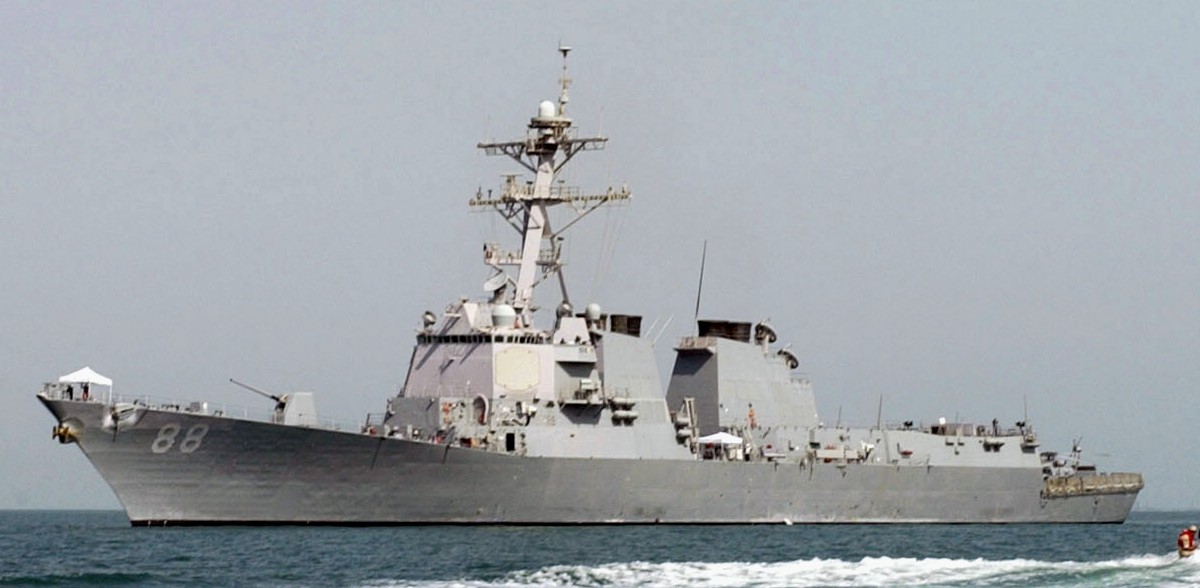 Persian Gulf - October 2004 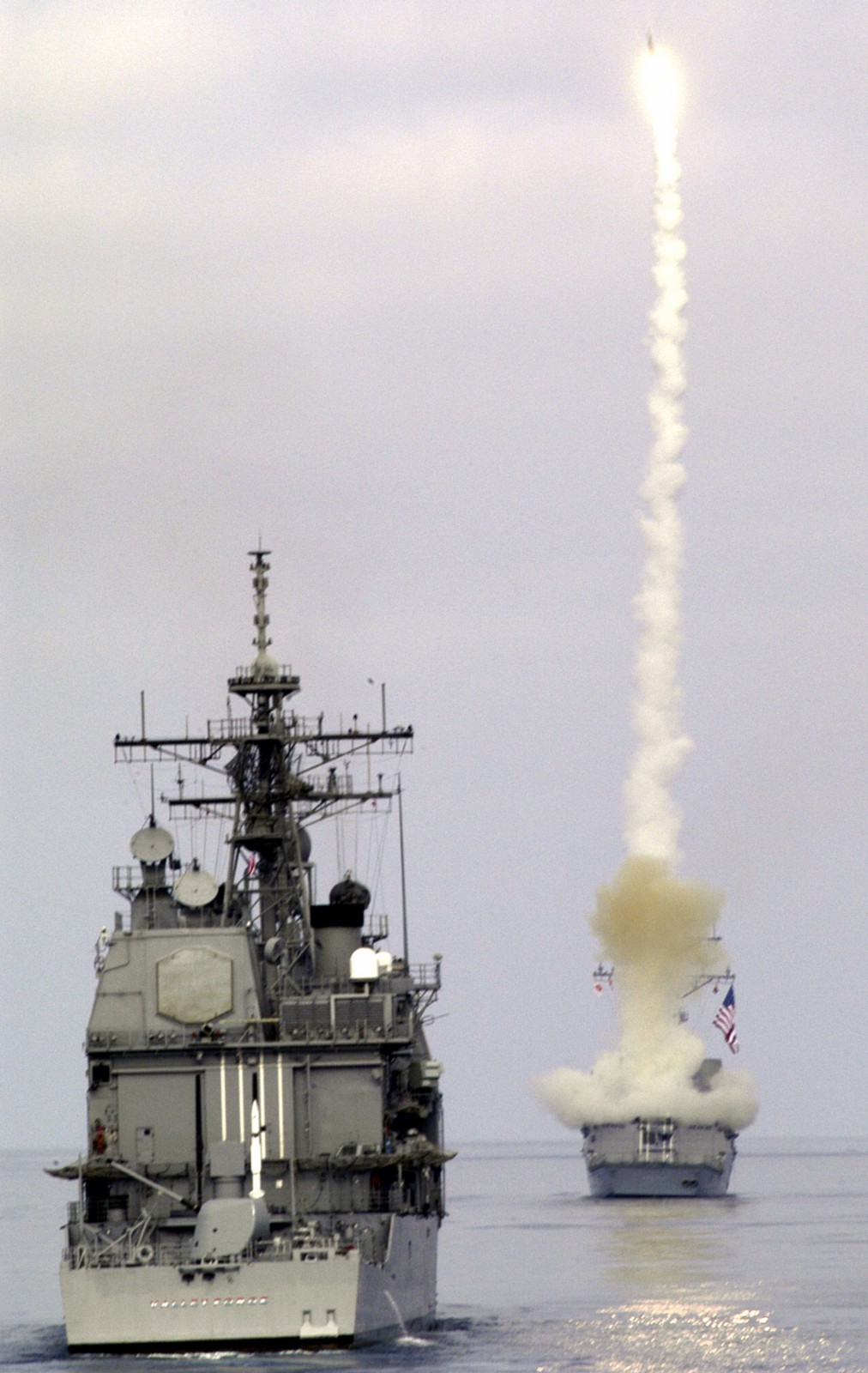 firing a Standard Missile SM-2MR - Pacific Ocean - October 2003  torpedo exercise - Pacific Ocean - February 2003 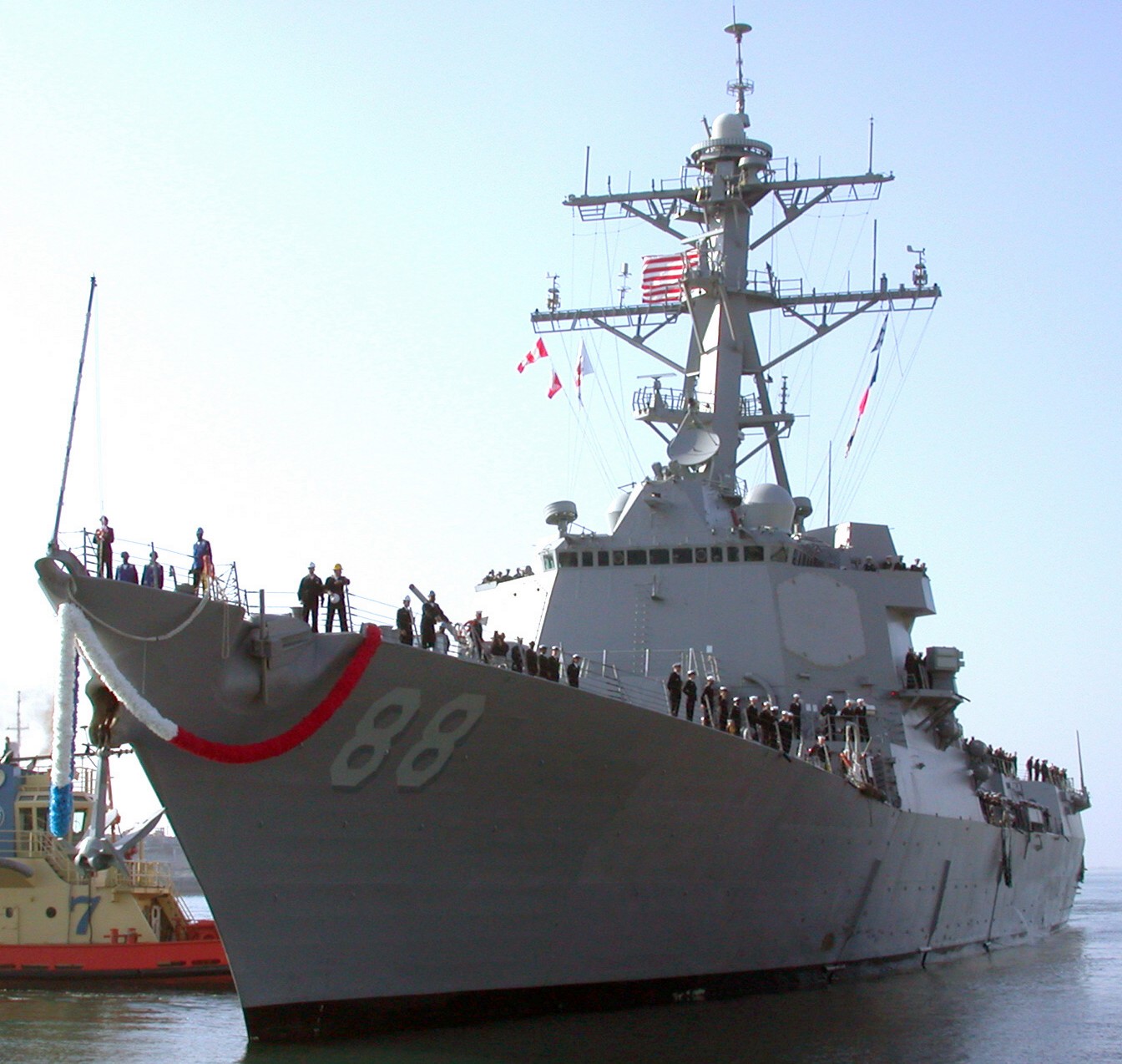 arriving at her new homeport, Naval Base San Diego, California for the first time - December 11, 2002 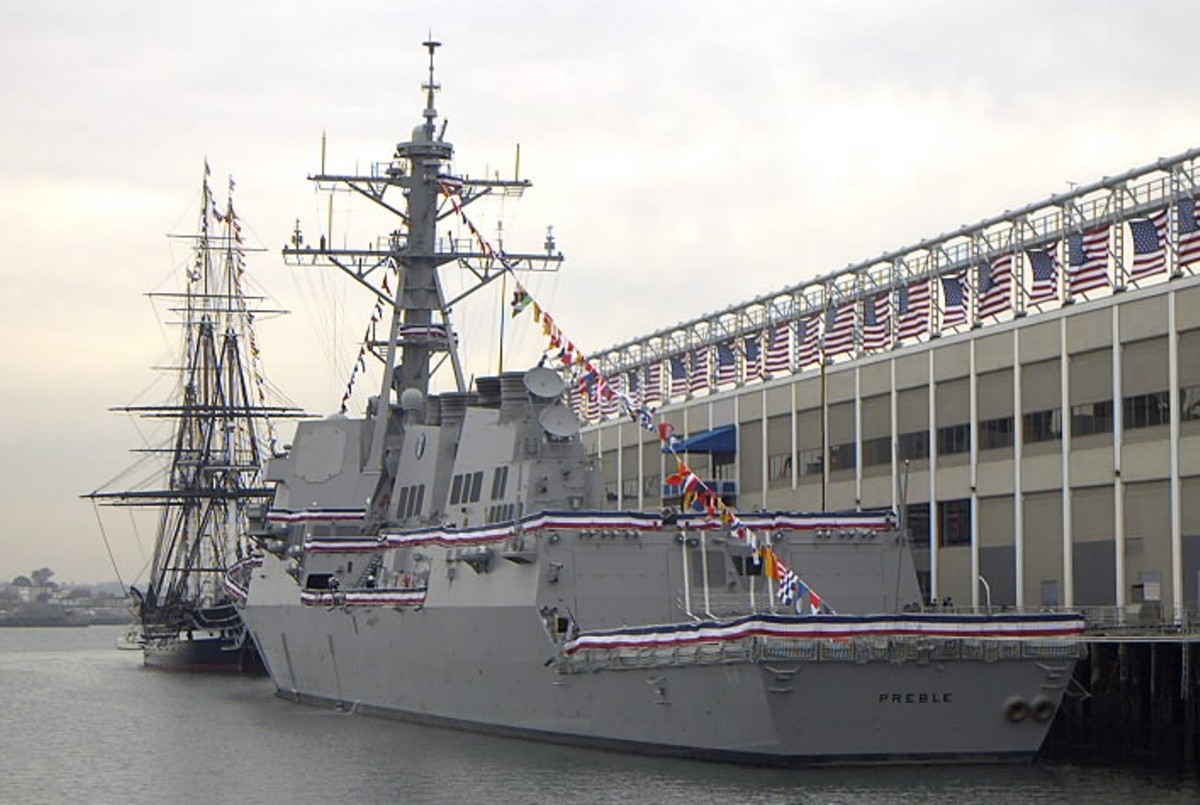 commissioning ceremony - Boston, Massachusetts - November 9, 2002  builder's sea trials - Gulf of Mexico - June 2002 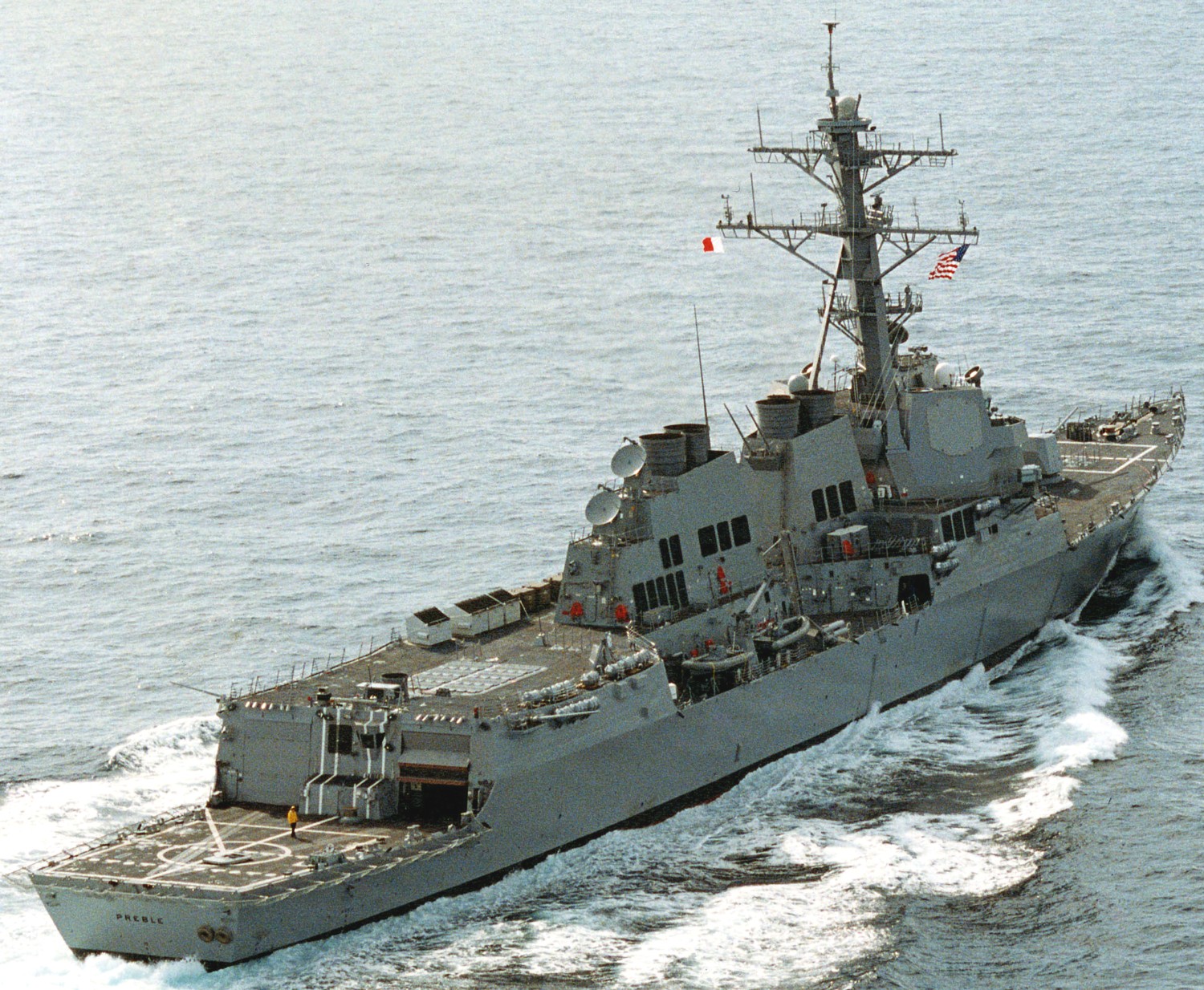 builder's sea trials - Gulf of Mexico - June 2002  builder's sea trials - Gulf of Mexico - June 2002 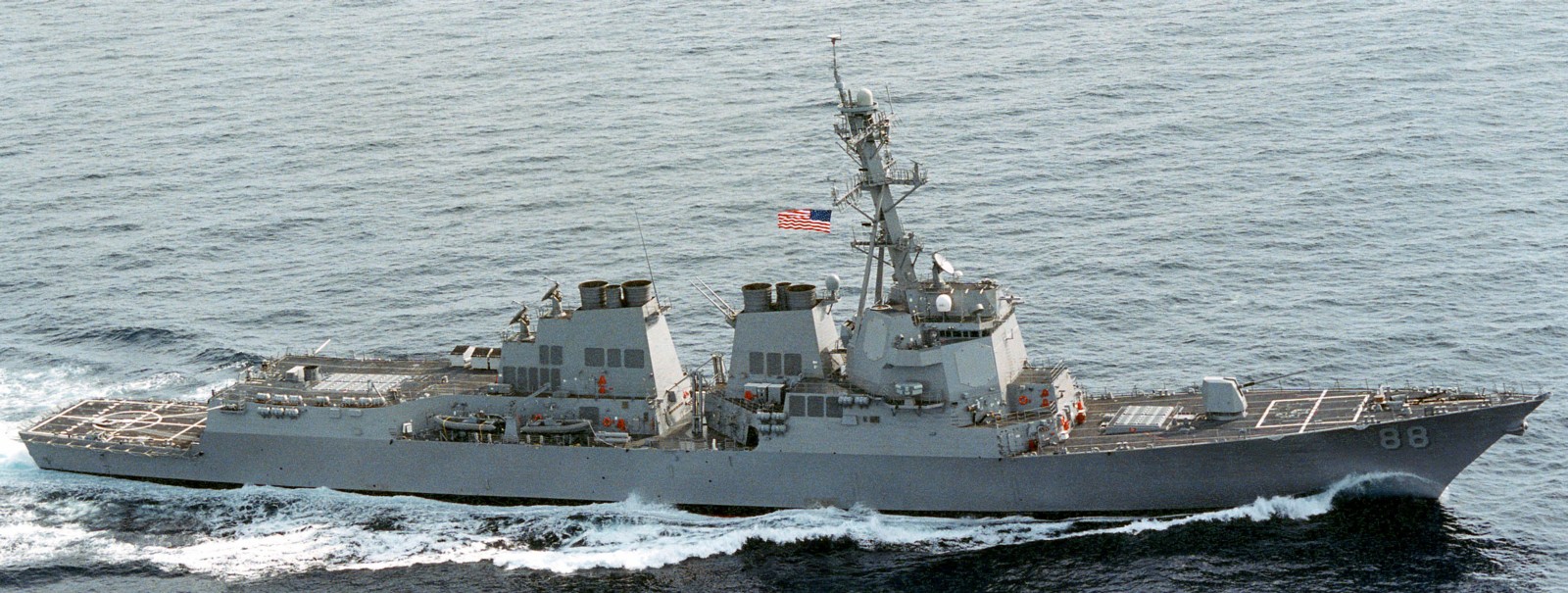 builder's sea trials - Gulf of Mexico - June 2002 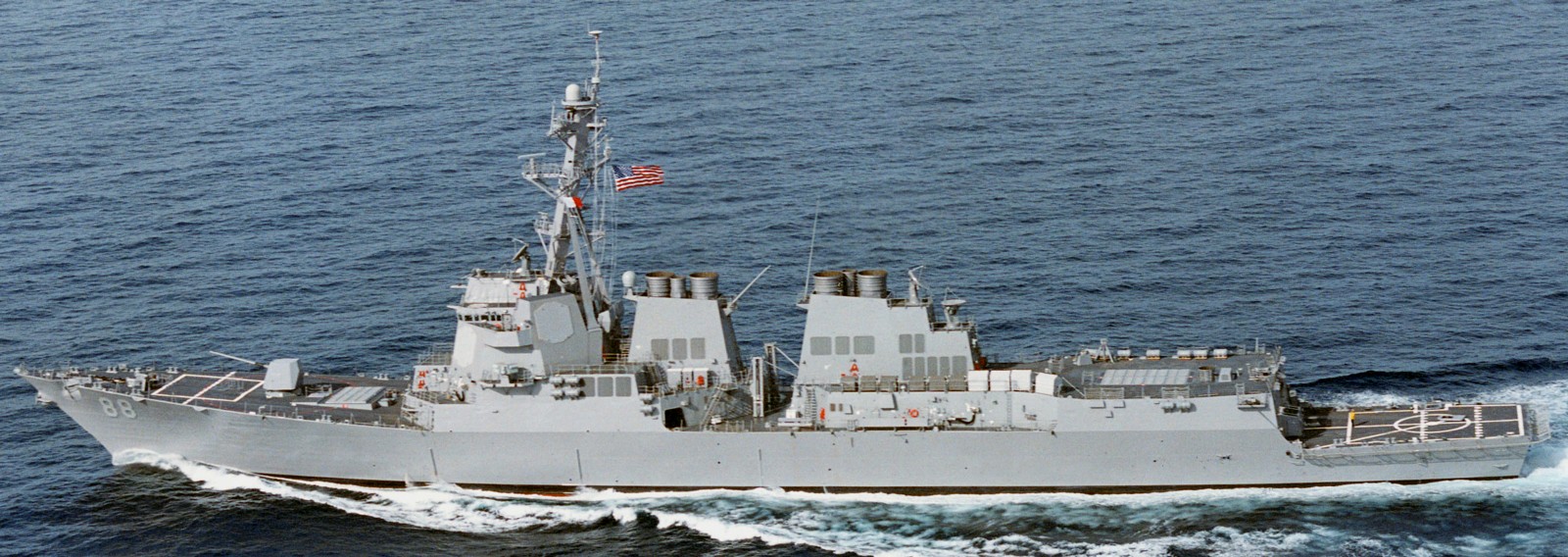 builder's sea trials - Gulf of Mexico - June 2002 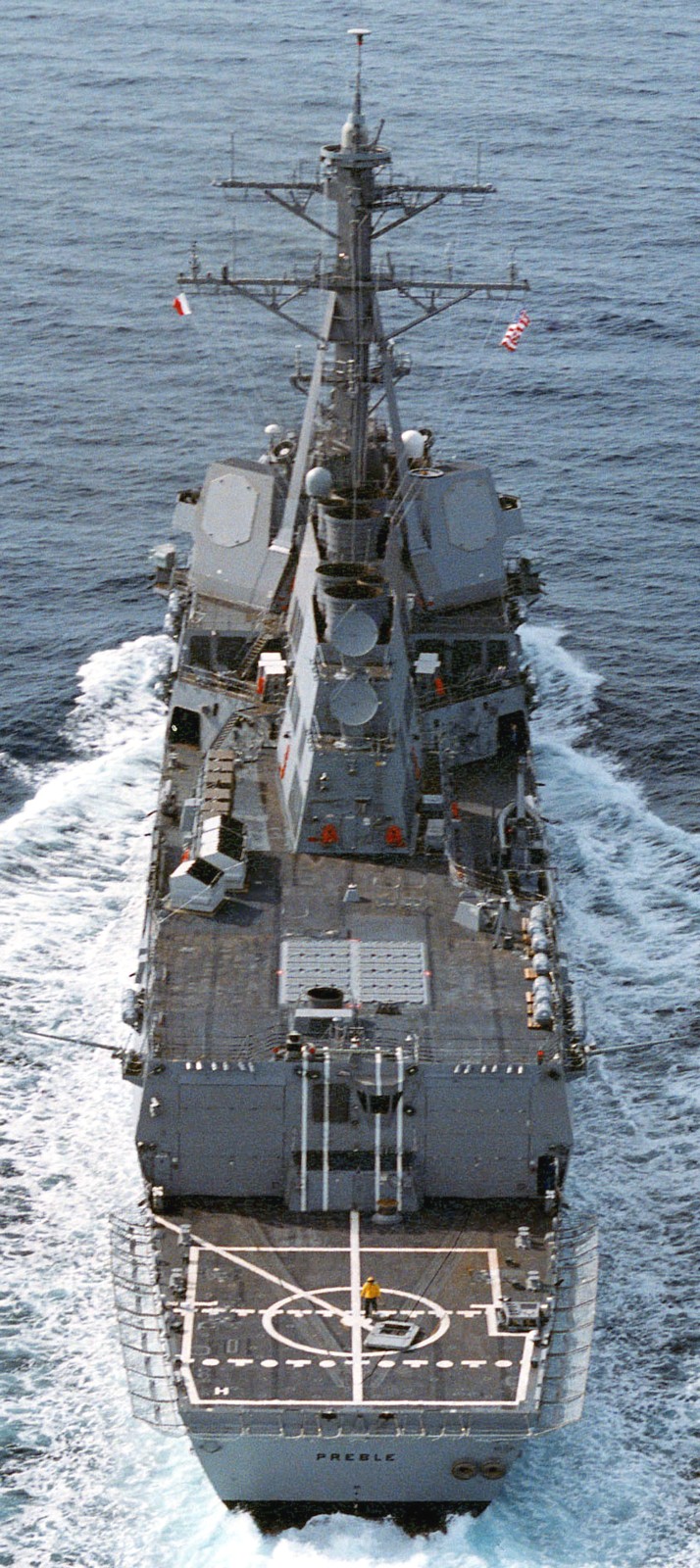
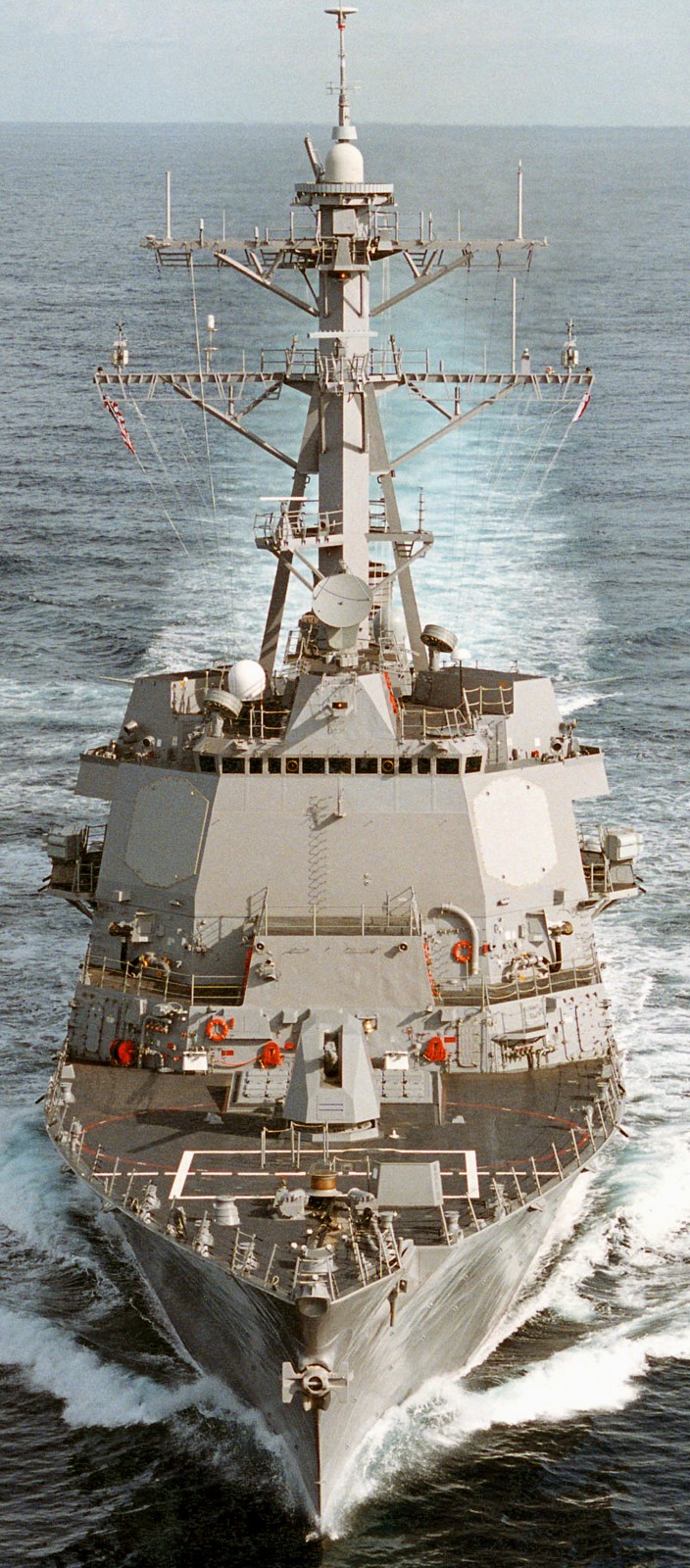 builder's sea trials - Gulf of Mexico - June 2002 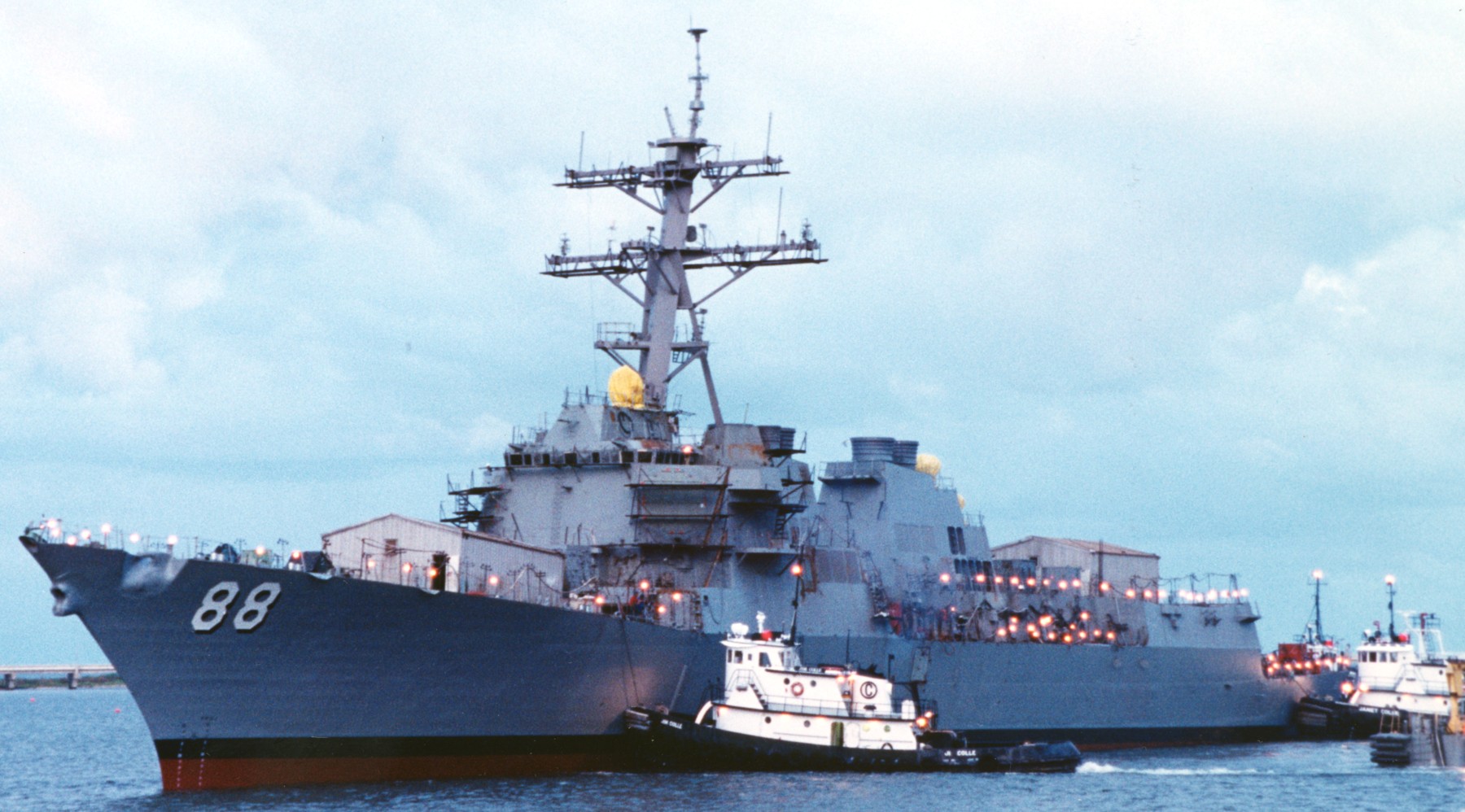 launching at Litton Ingalls Shipbuilding, Pascagoula, Mississippi - June 1, 2001 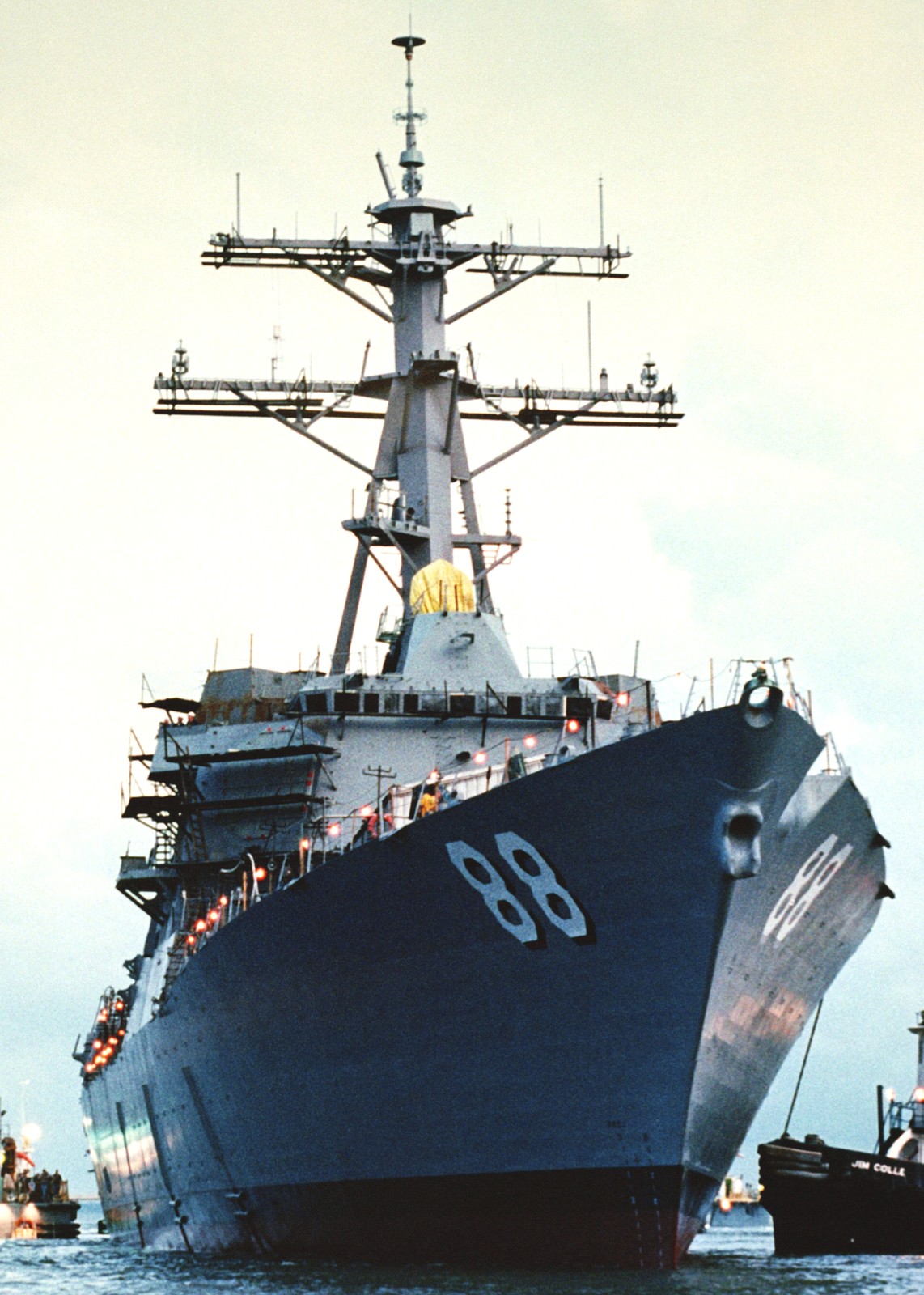 launching at Litton Ingalls Shipbuilding, Pascagoula, Mississippi - June 1, 2001 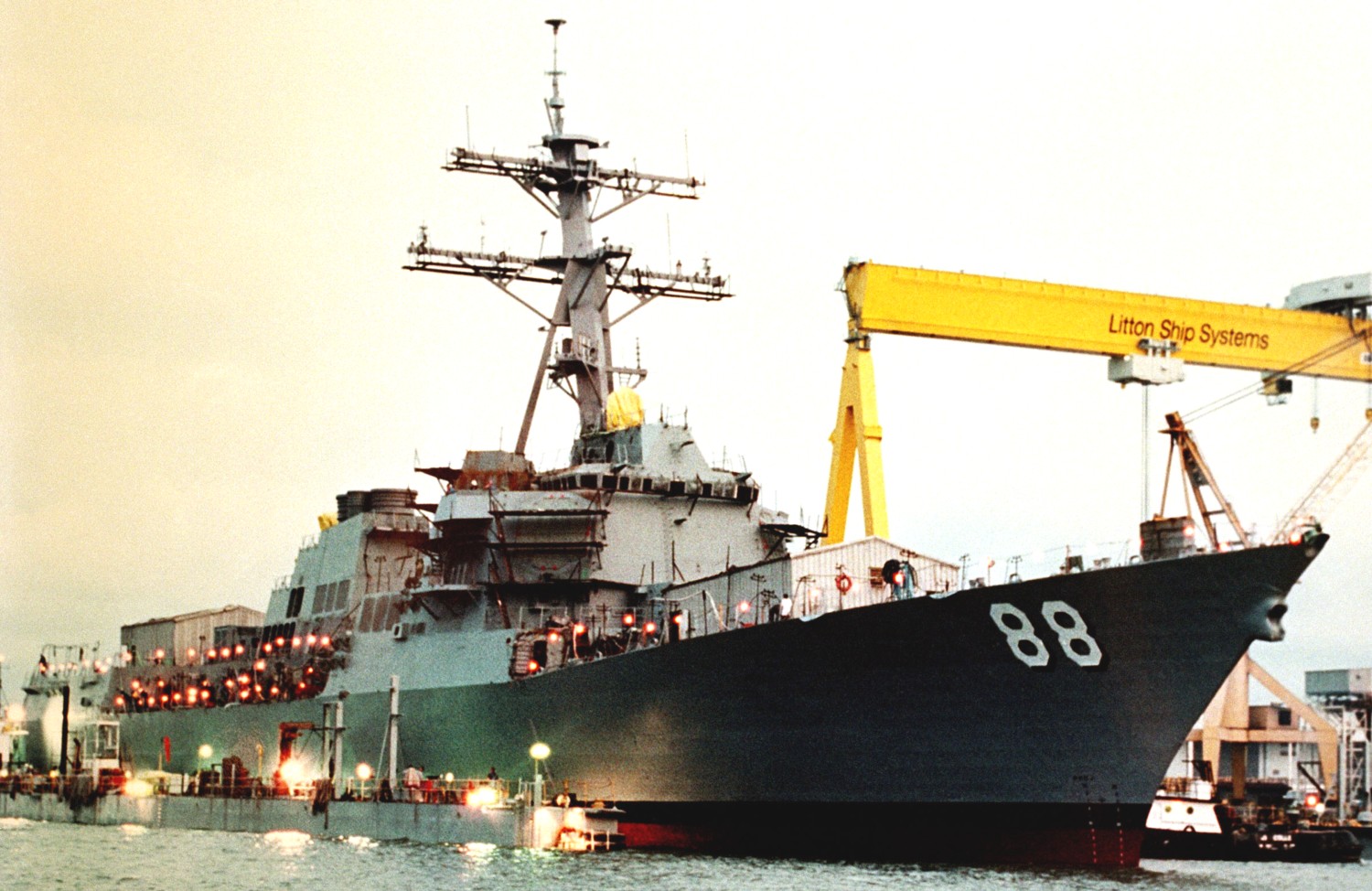 launching at Litton Ingalls Shipbuilding, Pascagoula, Mississippi - June 1, 2001 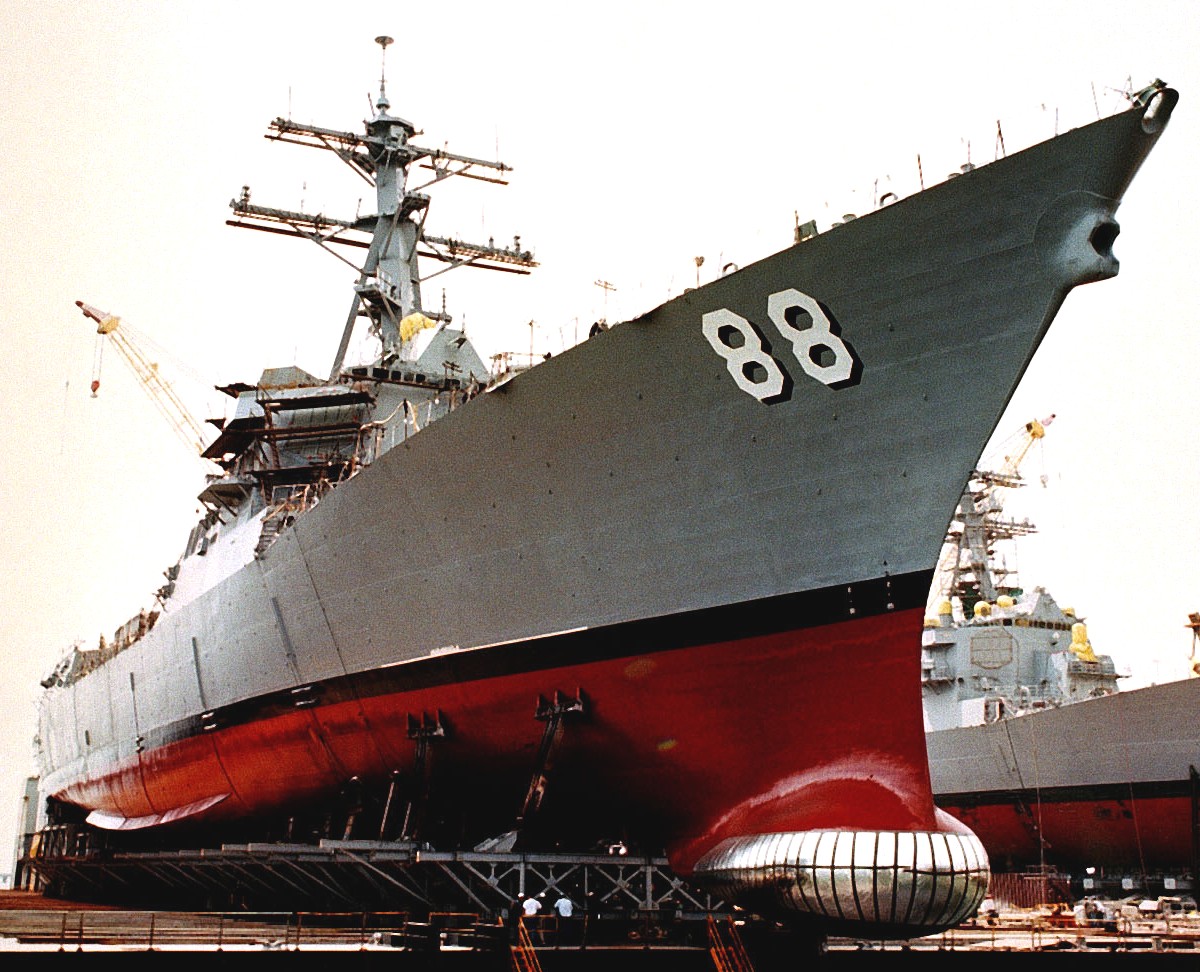 launching at Litton Ingalls Shipbuilding, Pascagoula, Mississippi - June 1, 2001 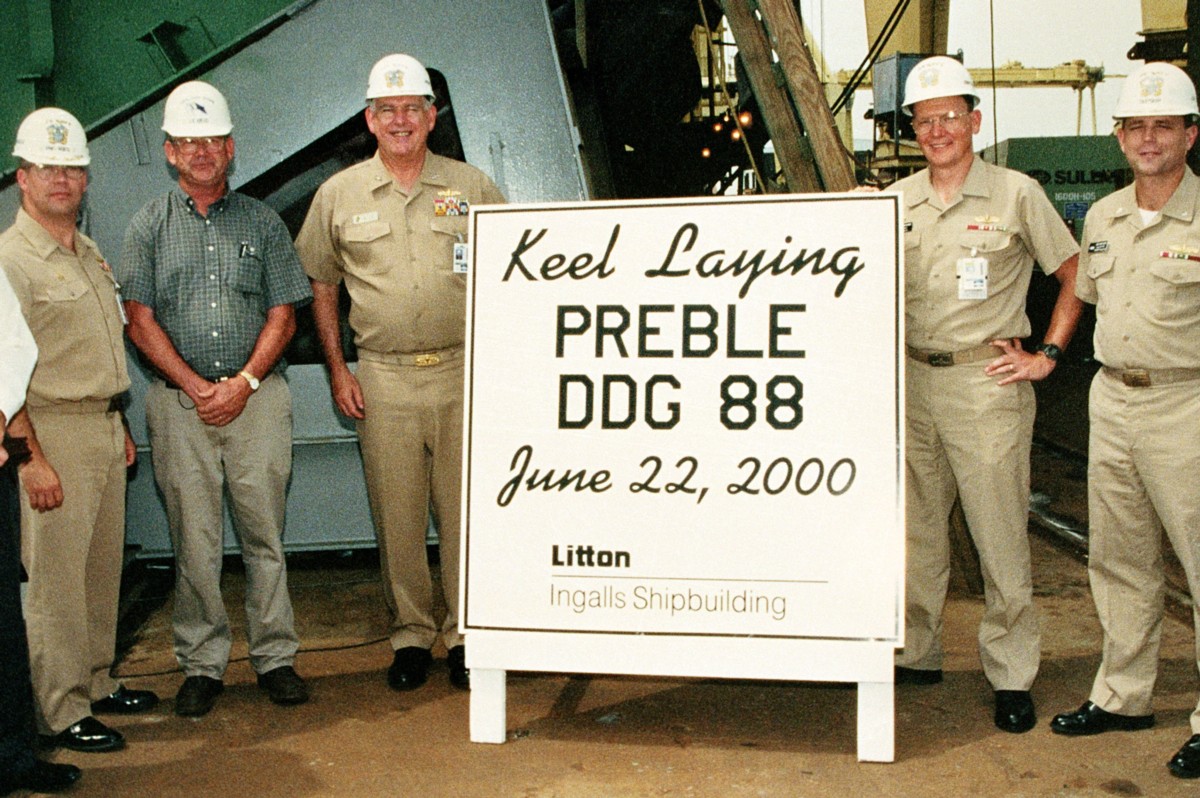 keel laying ceremony at Litton Ingalls Shipbuilding, Pascagoula, Mississippi - June 22, 2000 |
||
|
USS Preble (DDG 88): USS Preble was commissioned during a ceremony at the Commonwealth Pier/World Trade Center in Boston, Massachusetts. At her commissioning ceremony USS Preble was docked bow to bow with USS Constitution, the command of her namesake. The ceremony included a symbolic welcoming aboard of the spirit of Commodore Preble signaled by the ringing of chimes. Among the speakers at the commissioning were U.S. Senator Edward Kennedy, U.S. Representative Stephen Lynch, then Chief of Naval Operations Admiral Vernon E. Clark USN (Ret.) and journalist and sailor Walter Cronkite. Preble departed San Diego in June 2004 for her maiden deployment with the USS Belleau Wood Expeditionary Strike Group. Preble returned home after six months on 17 December 2004. On 20 January 2007, Preble departed for a routine deployment with the USS John C. Stennis carrier strike group. Preble supported Operation Enduring Freedom and Iraqi Freedom, Expeditionary Strike Force training and exercise Valiant Shield 2007 during the deployment. She returned to her homeport after seven months on 29 August 2007. In 2008, Preble successfully completed an accelerated training cycle and passed a rigorous Inspection Board and Survey (INSURV) in May. That fall, Preble executed the integrated training phase with the Stennis Strike Group in preparation for a deployment in 2009. Preble deployed on 17 January 2009 for a routine deployment with the Stennis Carrier Strike Group where she spent five months in the Seventh Fleet area of responsibility, participated in Exercise Foal Eagle and culminated the deployment with a diplomatic port visit in Tahiti, French Polynesia. Preble returned to home port on 15 June 2009. In 2010 Preble shifted to align with the USS Ronald Reagan Strike Group and hosted sailors from the Royal New Zealand Navy. The Anzac-class frigate HMNZS Te Kaha and replenishment tanker HMNZS Endeavour conducted exercises with Preble during a 3-day underway period. Additionally, Preble was called to act as the lead ship for a Destroyer Squadron Seven multi-group sail that showcased the ship's anti-submarine warfare capabilities. In September 2010, Preble conducted an Operational Test Launch of two Block 3C Tomahawk missiles and one Block 4E Tomahawk missile off the coast of San Nicholas Island. The launch was successful and aided in the further development of the weapon system. Preble participated in an Integrated Anti-Submarine Warfare Course at sea as well as three weeks of exercises with Ronald Reagan and sister ships in Destroyer Squadron Seven during the Composite Unit Training Exercise (COMPTUEX) in October to November 2010. In November 2010, Preble successfully conducted a Mk.54 torpedo technical evaluation in support of the Naval Undersea Warfare Center's development of the torpedo. Preble accurately fired six MK 54 torpedoes during the evaluation. In all, Preble had a successful 2010 and was awarded the Destroyer Squadron Seven Battle Efficiency Award which recognizes sustained superior performance, operational effectiveness, and continuous readiness. In addition, the ship earned the Black E (Maritime Warfare Excellence), Blue E (Logistics Management and Supply Excellence), Yellow E (Ship Safety) and Red E (Engineering/Survivability Excellence). In February 2011, Preble deployed with Carrier Strike Group Seven. Preble was a first responder to the 2011 Tōhoku earthquake and tsunami. The ship conducted humanitarian and disaster relief efforts off the coast of northeastern Japan. After spending nearly a month off the coast of Japan, Preble began to conduct a series of fisheries patrols. From 28 February to 6 March 2011, she conducted these patrols in the Exclusive Economic Zones of various Pacific island nations as part of the Oceania Maritime Security Initiative. With modern technology, fishing vessels have increased their capability and capacity to catch more fish, and consequently, it is imperative that the rights of small island nations to their EEZ be preserved to prevent illegal fishing and exploitation of their ecosystems. EEZ patrols are part of an ongoing partnership between the U.S. Navy and U.S. Coast Guard to reduce and eliminate illegal, unregulated, unreported (IUU) fishing and effectively enforce fishing regulations across the Western Pacific. Preble's mission supported the United States' long-standing partnership with the maritime nations of Micronesia, Oceania, and the Marshall Islands, with the focus on IUU fishing in the EEZs of these island nations and on the high seas itself. During the course of this operation, Preble encountered multiple vessels conducting fishing operations in EEZ. All the data was reported to USCG District 14 for evaluation and follow-on action via the embarked Coast Guard liaison team. Also, Preble's embarked detachment of Sikorsky SH-60 Seahawk helicopters from squadron HSL-43 was used to conduct routine aerial patrols, enabling the surveillance team to search multiple areas of interest. She then continued west to operate as part of the Seventh and Fifth Fleets. Preble came under the command of the Fifth Fleet in May 2011 and conducted counter-piracy operations as part of Combined Task Force 151. Preble returned home in late 2011. On 25 August 2011, BAE Systems Ship Repair was awarded a $14.5 million contract, in addition to a previous contract, to upgrade and repair Preble. In 2019 it was announced that Preble would receive the High Energy Laser with Integrated Optical-dazzler and Surveillance (HELIOS) close in weapons system in 2021. USS Preble will be the first destroyer to be equipped with a high-energy laser to counter surface craft and unmanned aerial systems. The destroyer will also receive a BAE Systems Ship Repair upgrade, bringing the ship up to date in terms of capability and complexity. In August 2024 it was announced, that USS Preble will leave San Diego to be forward deployed to Fleet Activities Yokosuka, Japan. Preble will replace USS Benfold (DDG 65). source: wikipedia + USN |
||
|
Commodore Edward Preble (August 15, 1761 - August 25, 1807): Born at Falmouth, Maine, Edward Preble was the fourth child and third son of General Jedidiah Preble, an officer of the Revolution. His great-grandfather was Abraham Preble, having settled in Scituate, Massachusetts, about 1636. His mother, Mehitable (Bangs) Roberts, was the second wife of General Preble. Edward was educated at Dummer Academy, Newbury, Massachusetts. He married Mary Deering on 17 March 1801, and they had one son. At the age of sixteen Preble ran away to sea on a privateer of Newburyport, and in 1779 was appointed a midshipman on the frigate Protector of the Massachusetts navy. This ship fought two actions with the British ships Admiral Duff and Thames. In 1781 she was captured and Preble was confined for a time on the prison-ship Jersey. In 1782 he was a lieutenant under Captain George Little on the Massachusetts cruiser Winthrop, which succeeded in taking five prizes. After the Revolution he spent fifteen years in the merchant service and visited many parts of the world, being once captured by pirates. Upon the opening of hostilities with France in 1798, he was appointed a lieutenant in the navy and was given command of the brig Pickering in the squadron of Commodore John Barry in the West Indies. He received a commission as captain on 15 May 1799 and was ordered to the new frigate Essex. The frigate Congress and the Essex set sail with a convoy of merchantment for the East Indies in January 1800, but six days out the Congress was dismasted in a gale and the Essex proceeded alone. She was the first American warship to show the flag beyond the Cape of Good Hope. After cruising for two months about the Straits of Sunda, rendering important service in protecting American trade from French privateers, the Essex sailed for home with a convoy of fourteen vessels, arriving at New York in November. The naval war with France was scarcely brought to a close before the war with Tripoli began and in 1803 Preble was put in command of the third squadron to be sent to the Mediterranean. His flagship was the Constitution and the squadron included six other vessels: the frigate Philadelphia, the brigs Siren and (Argus), and the schooners Vixen, Nautilus, and Enterprise. Each vessel sailed when ready and the Consitution was the fourth to get away on 14 August 1803, arriving at Gibraltar on 12 September. After working on a difficulty with Morocco in November, Preble sailed east for the rendezvous with the squadron. Before reaching Syracuse, however, he learned of the capture of the Philadelphia by the Tripolitans and the captivity of Captain William Bainbridge with more than 300 members of the crew. The Philadelphia, lying in the harbor of Tripoli, was later destroyed by a prize ketch called the Intrepid, commanded by Stephen Deactur. Meanwhile, the blockade of Tripoli had been proclaimed by the commodore and was maintained, as well as circumstances permitted, by the squadron. At the same time, the squadron was also employed in cruising and in preparing for an attack upon the town. Preble borrowed two mortar-boats and six gunboats from the king of the Two Sicilies. Aside from these auxiliaries the squadron comprised the six American vessels and two prizes taken into the service, the Intrepid and the brig Scourge. The squadron carried forty-two heavy guns, one on each gunboat and the others on the Constitution, all the other vessels' guns being too light for assaulting the enemy's batteries. The commodore had under his command 1060 officers and men. Tripoli was defended by strong forts and batteries, many gunboats, several larger vessels, and 25,000 men. After much delay because of bad weather, the first assault on Tripoli was made on 3 August 1804. Most of the fighting was done by the gunboats, which closed with the enemy's gunboats and necessitated many desperate hand-to-hand contests. The squadron bombarded the town, inflicting considerable but not vital damage. The Americans were victorious at sea, three of the enemy's gunboats being captured and three sunk. Four subsequent attacks were made, two of them at night, with great loss to the enemy, but Tripoli was not captured. On the night of 4 September, the Intrepid, with 15,000 pounds of powder on board and commanded by Richard Somers, was sent into the harbor to be exploded in the midst of the Tripolitan fleet, but for some reason never explained, the explosion was pre-mature and all hands perished. Preble's total loss during the summer, including the crew of the Intrepid, was thirty killed and twenty-four wounded. Soon after this a larger and more powerful squadron appeared under the command of Commodore Samuel Barron and Preble was superseded. Very little was accomplished by Barron's squadron and the next year peace was reached with Tripoli on terms far from satisfactory. After his return home Preble was employed in building gunboats for the navy. His health, which had long been declining, turned for the worse and he died at Portland at the early age of forty-six on 25 August 1807. Ships named for Commodore Edward Preble: The first Preble, sometimes called Commodore Preble, a sloop purchased on Lake Champlain in 1813, was commissioned 6 August 1813, Lt. Charles Budd in command. The second Preble, a sloop-of-war built by the Portsmouth (N.H.) Navy Yard, was launched 13 June 1839 and commissioned the following year, Comdr. Samuel L. Breese in command. The third Preble (Torpedo boat destroyer 12) was laid down by the Union Iron Works, San Francisco, Calif., 21 April 1899; launched 2 March 1901; sponsored by Miss Ethel Preble; and commissioned 14 December 1903, Lt. T. C. Fenton in command. The fourth Preble (DD 345) was laid down by the Bath Iron Works, Bath, Maine, 12 April 1919; launched 8 March 1920; sponsored by Miss Sallie MacIntosh Tucker; and commissioned at the Boston Navy Yard 19 March 1920, Comdr. H. A. Baldridge in command. The fifth Preble (DLG 15) was laid down by the Bath Iron Works Corp., Bath, Maine, 16 December 1957; launched 23 May 1959; sponsored by Mrs. Ralph E. Wilson; and commissioned in the Boston Naval Shipyard 9 May 1960, Comdr. Edward G. Fitz-Patrick in command. The sixth Preble (DDG 88) was laid down by Ingalls Shipbuilding, Pascagoula, Mississippi, 22 June 2000; launched 1 June 2001; sponsored by Connie Rae Clark; and commissioned at the Commonwealth Pier/World Trade Center in Boston, Massachusetts on 9 November 2002, Commander Timothy Batzler in command. |
||
Edward Preble |
||
| patches + more | ||
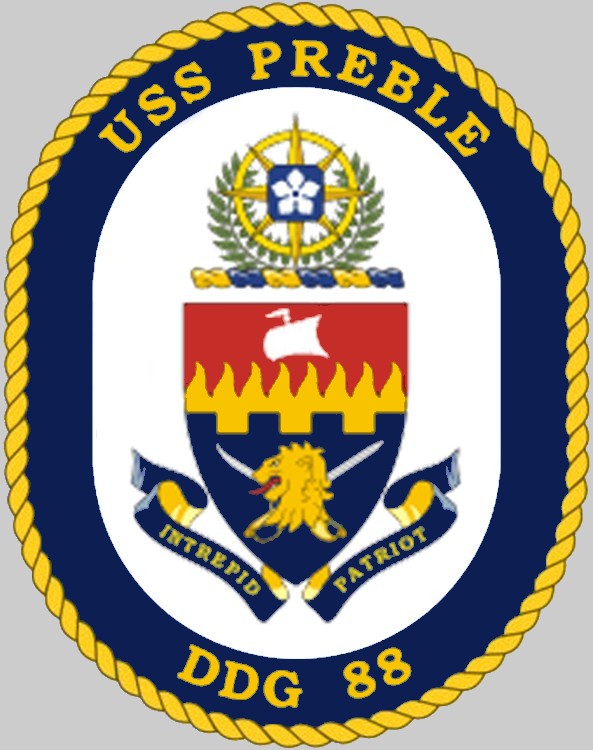  |
||
|
|
seaforces.org
|
USN ships
start page | |
